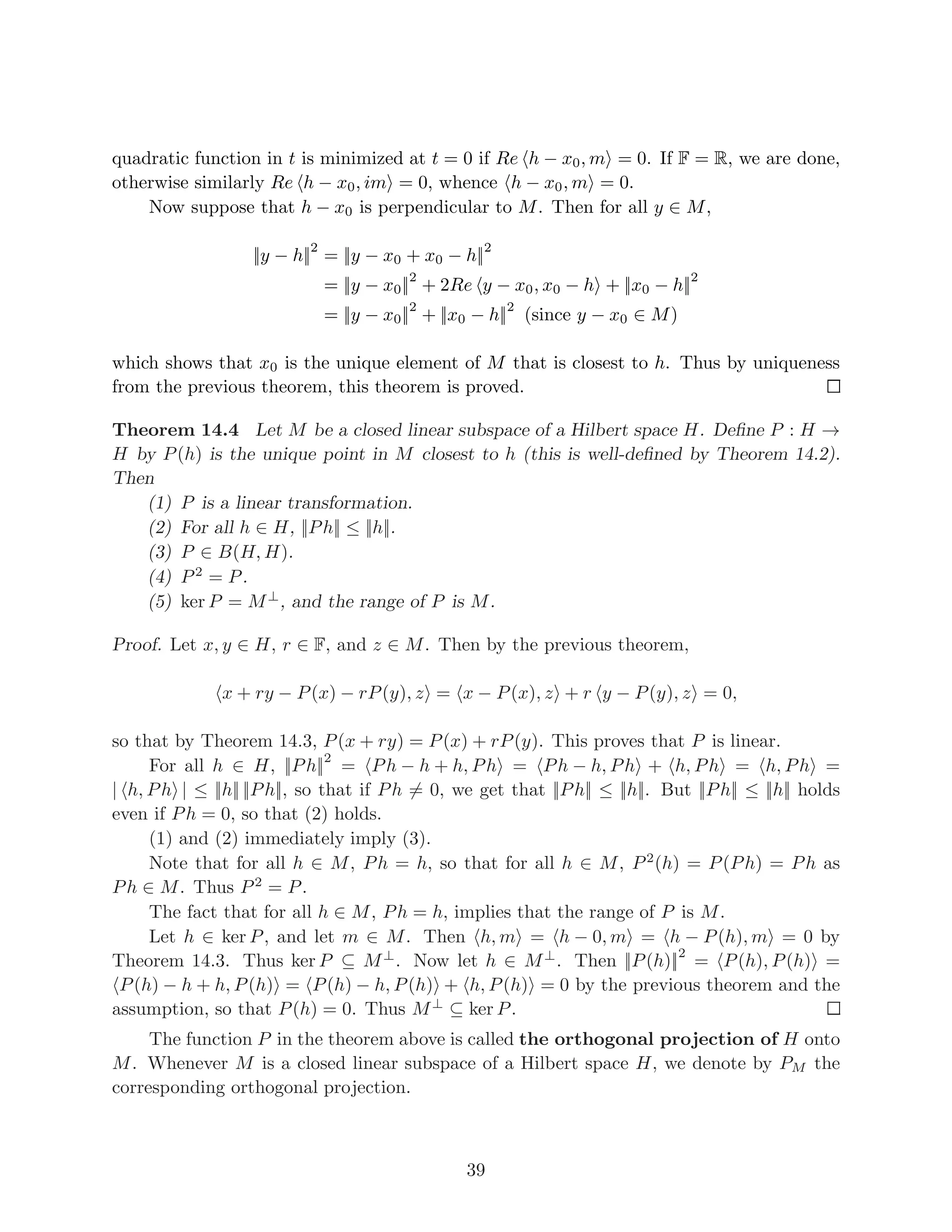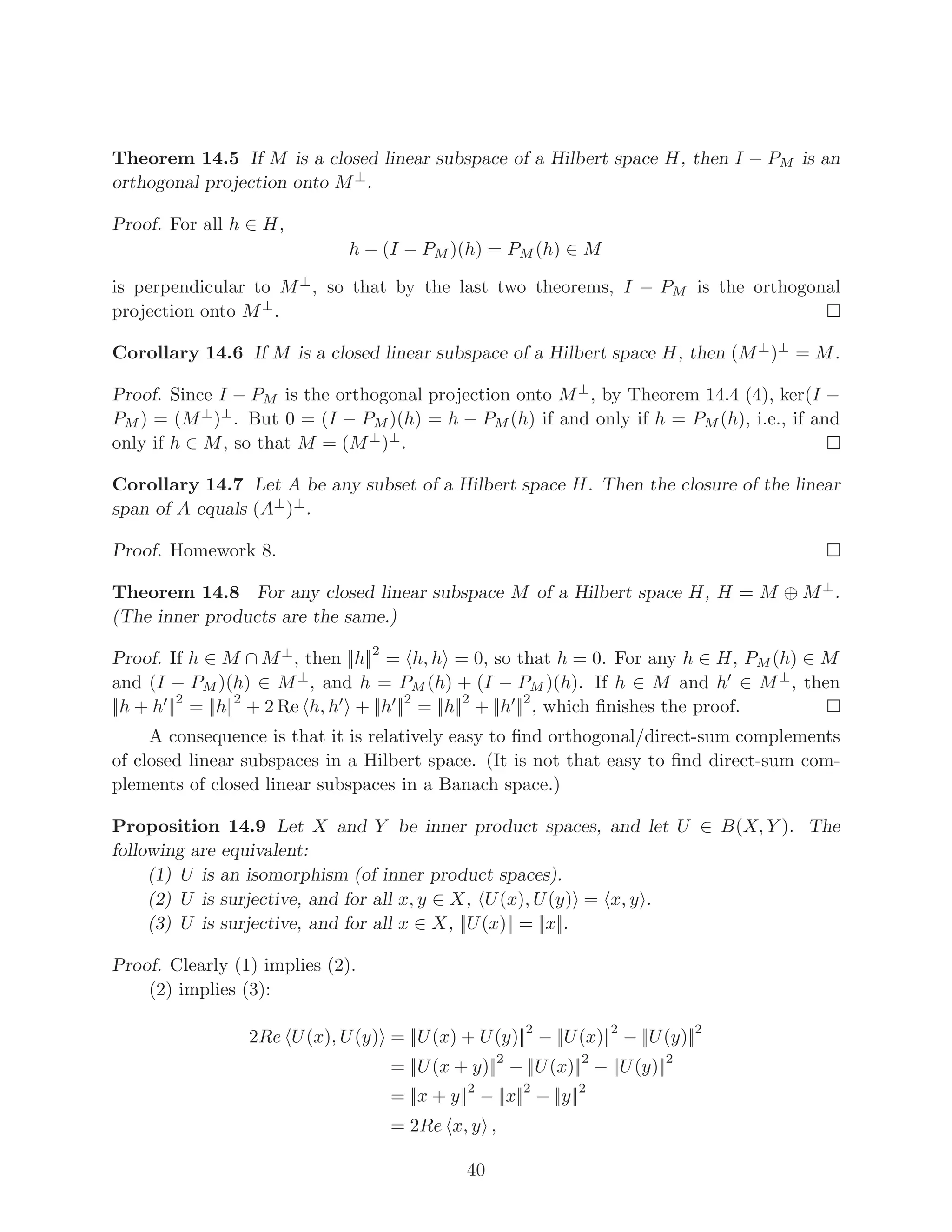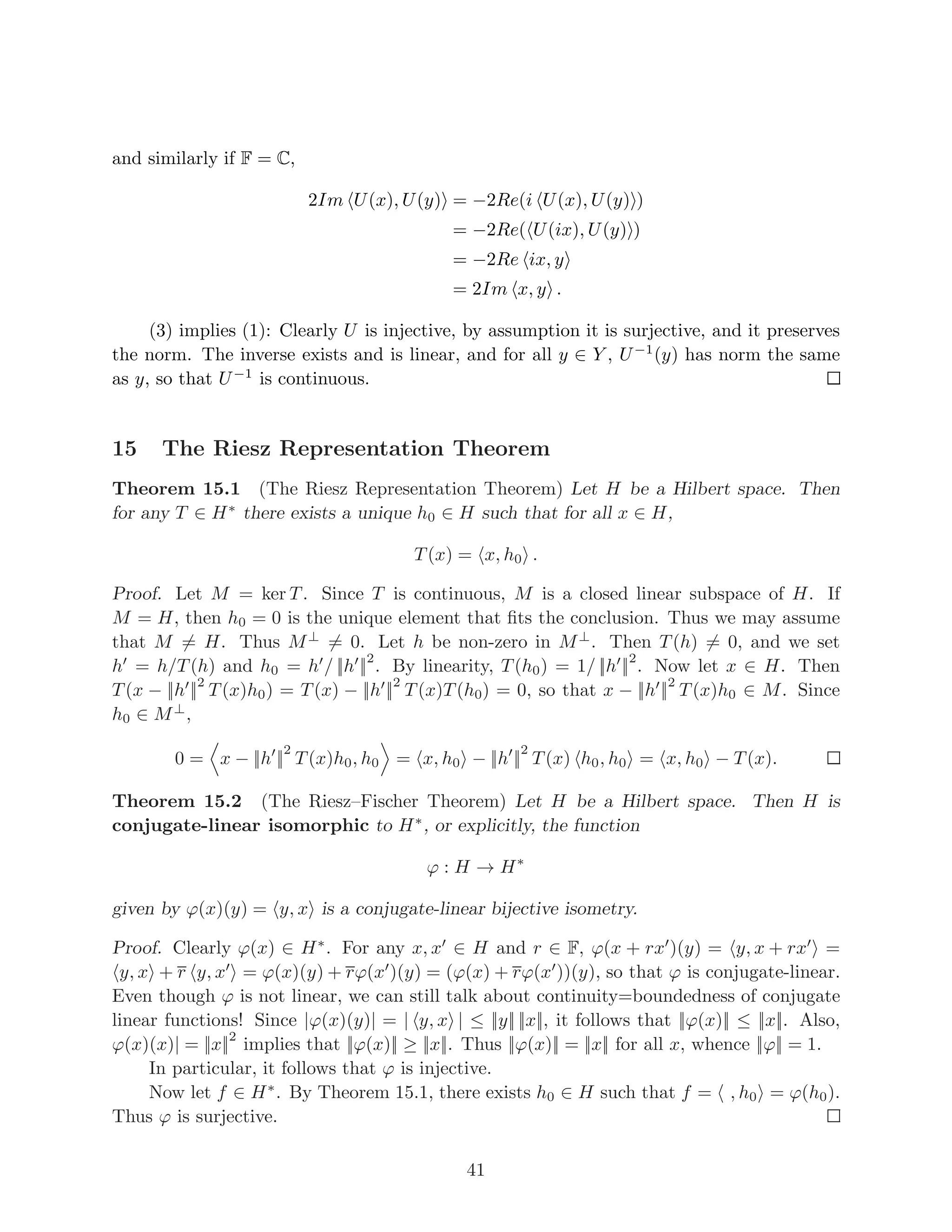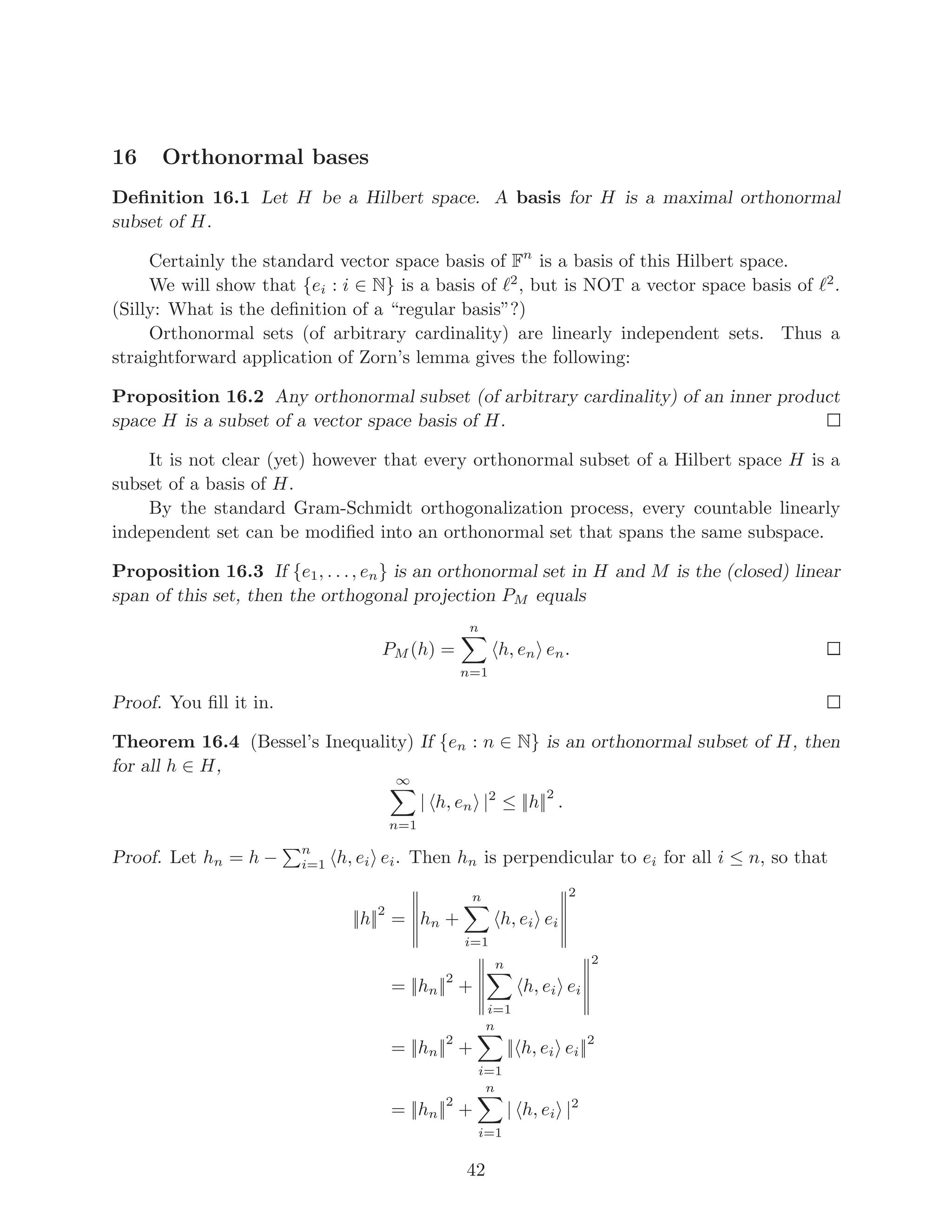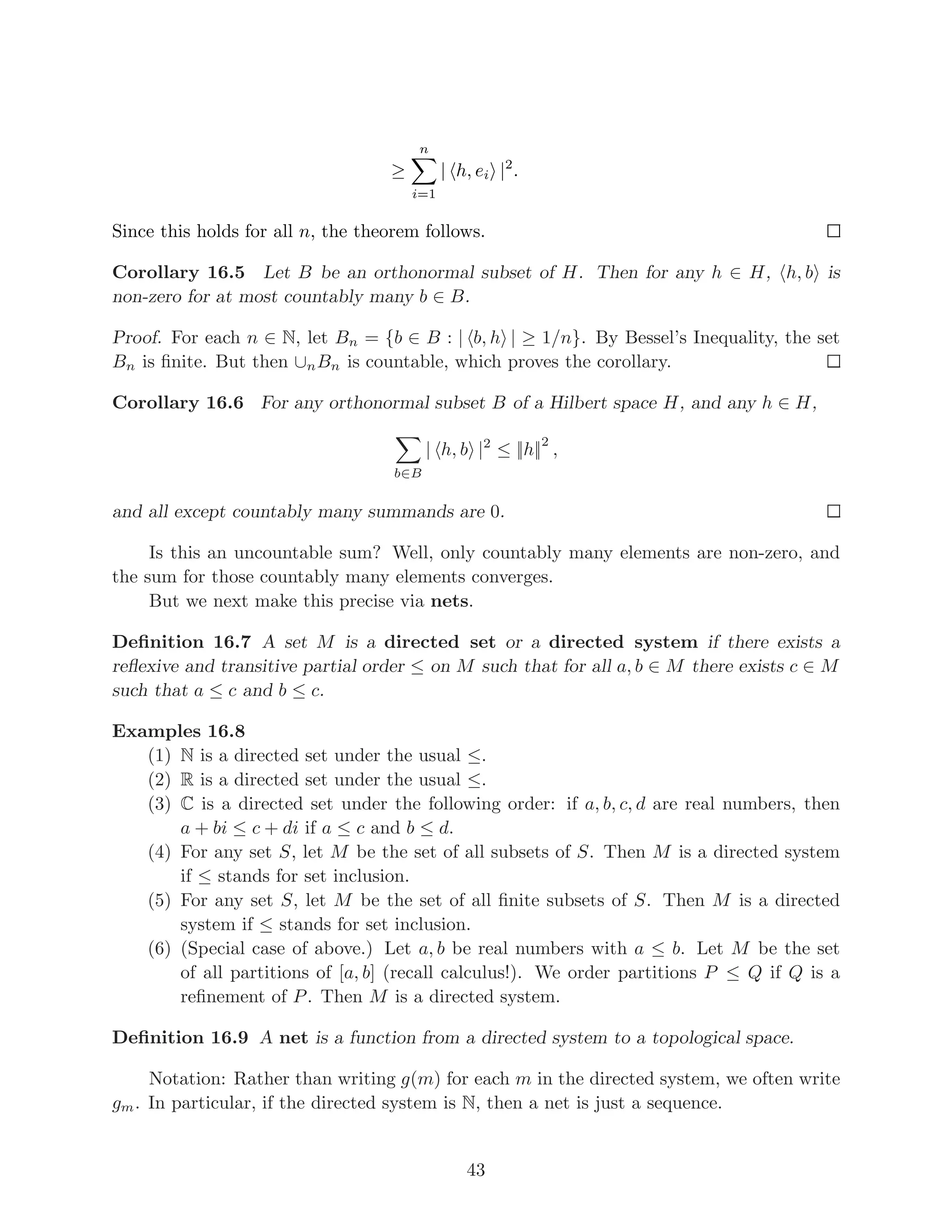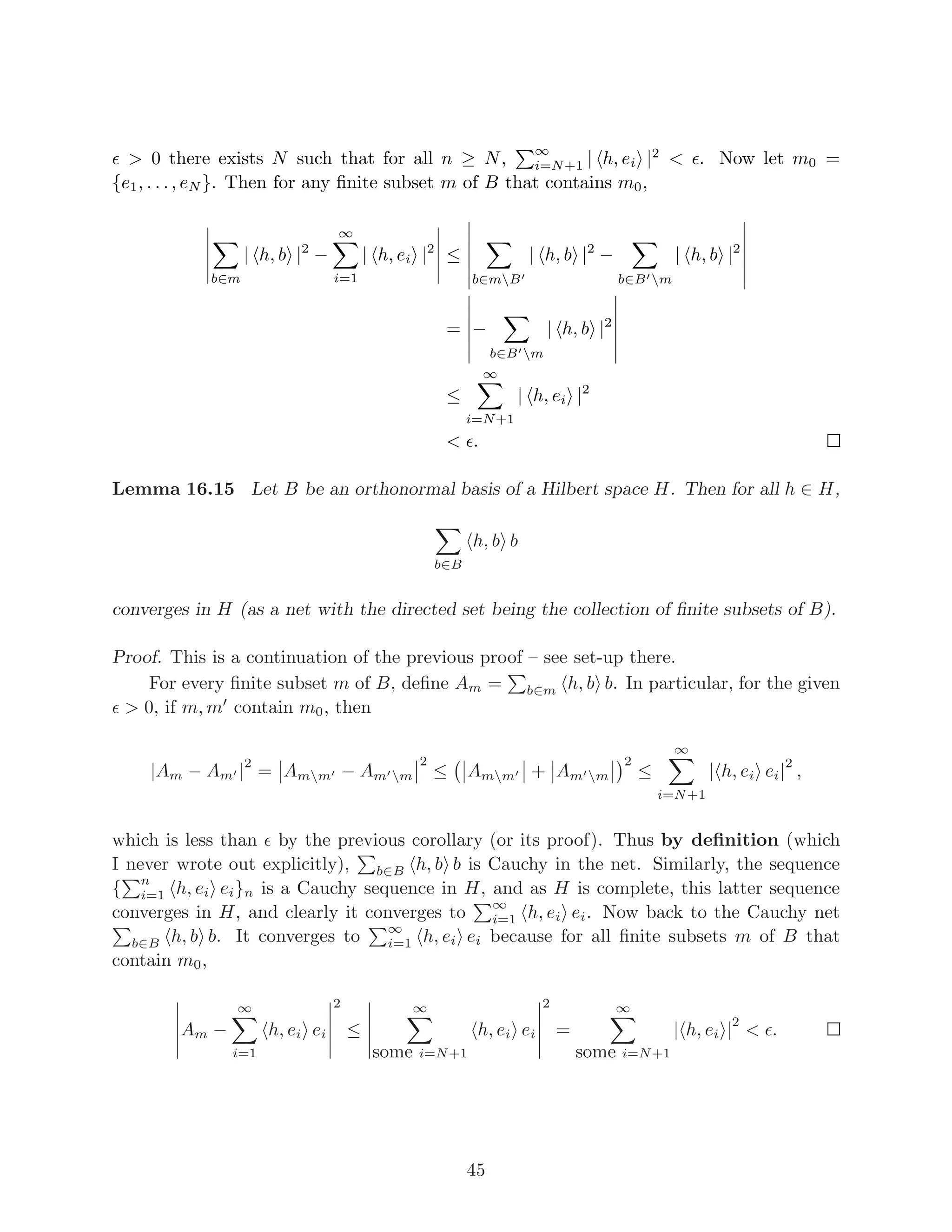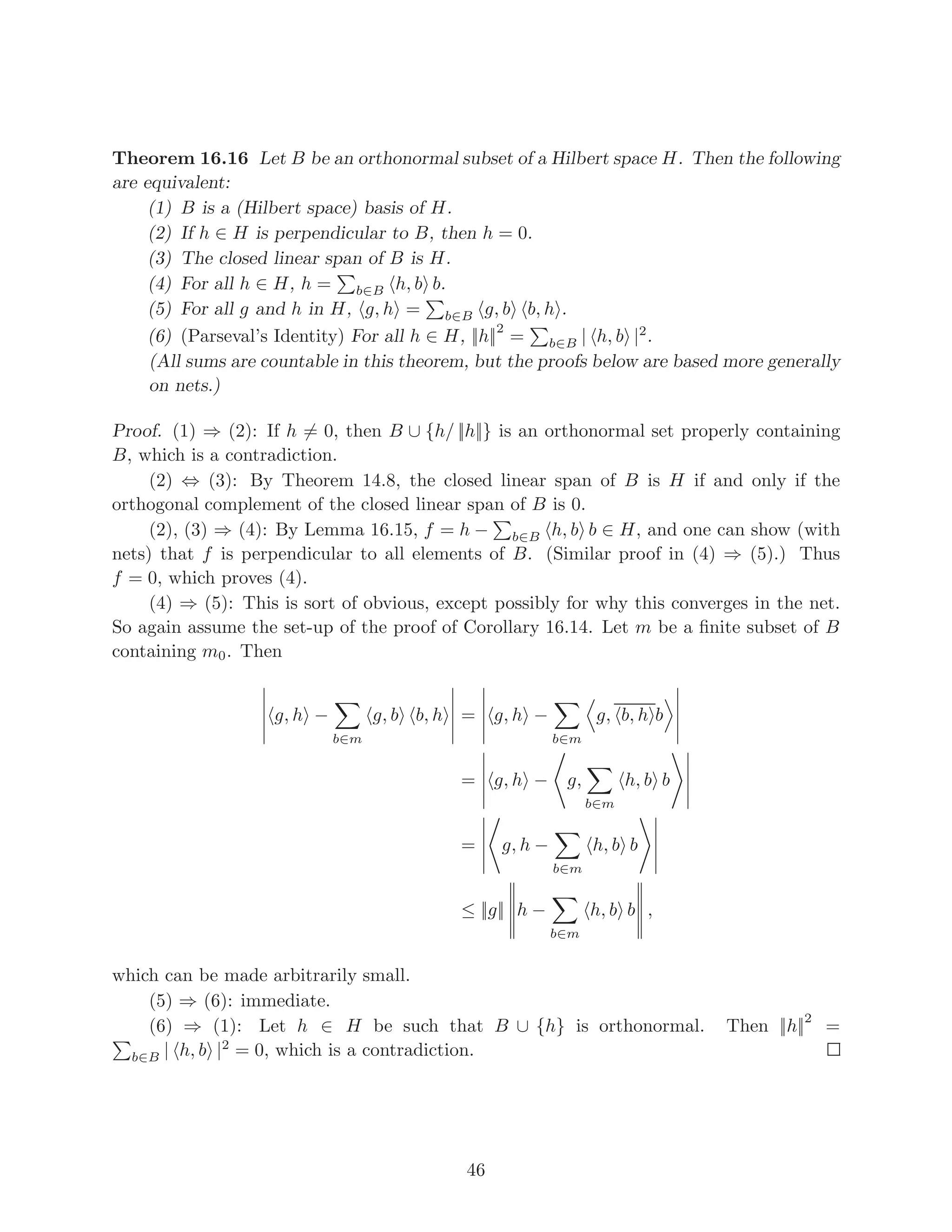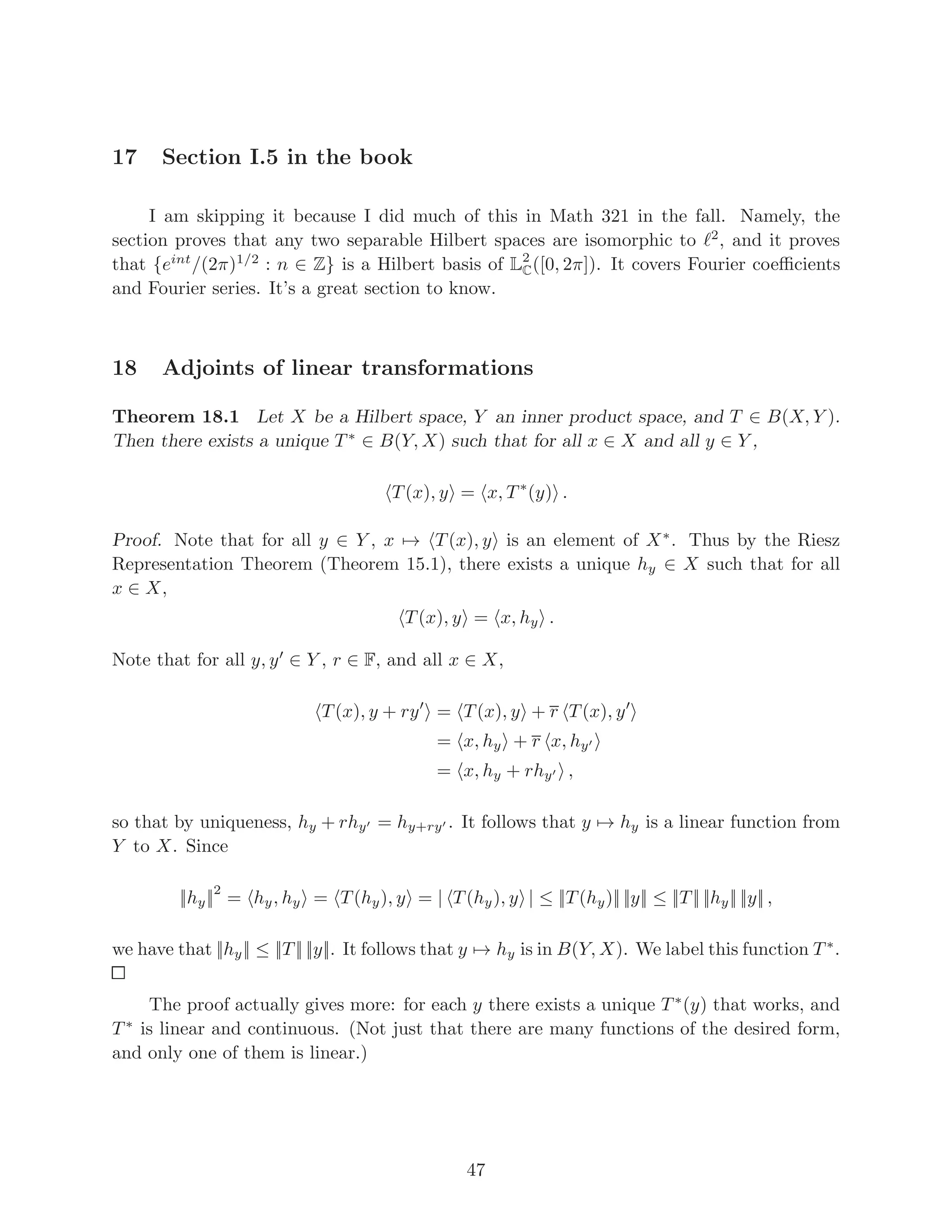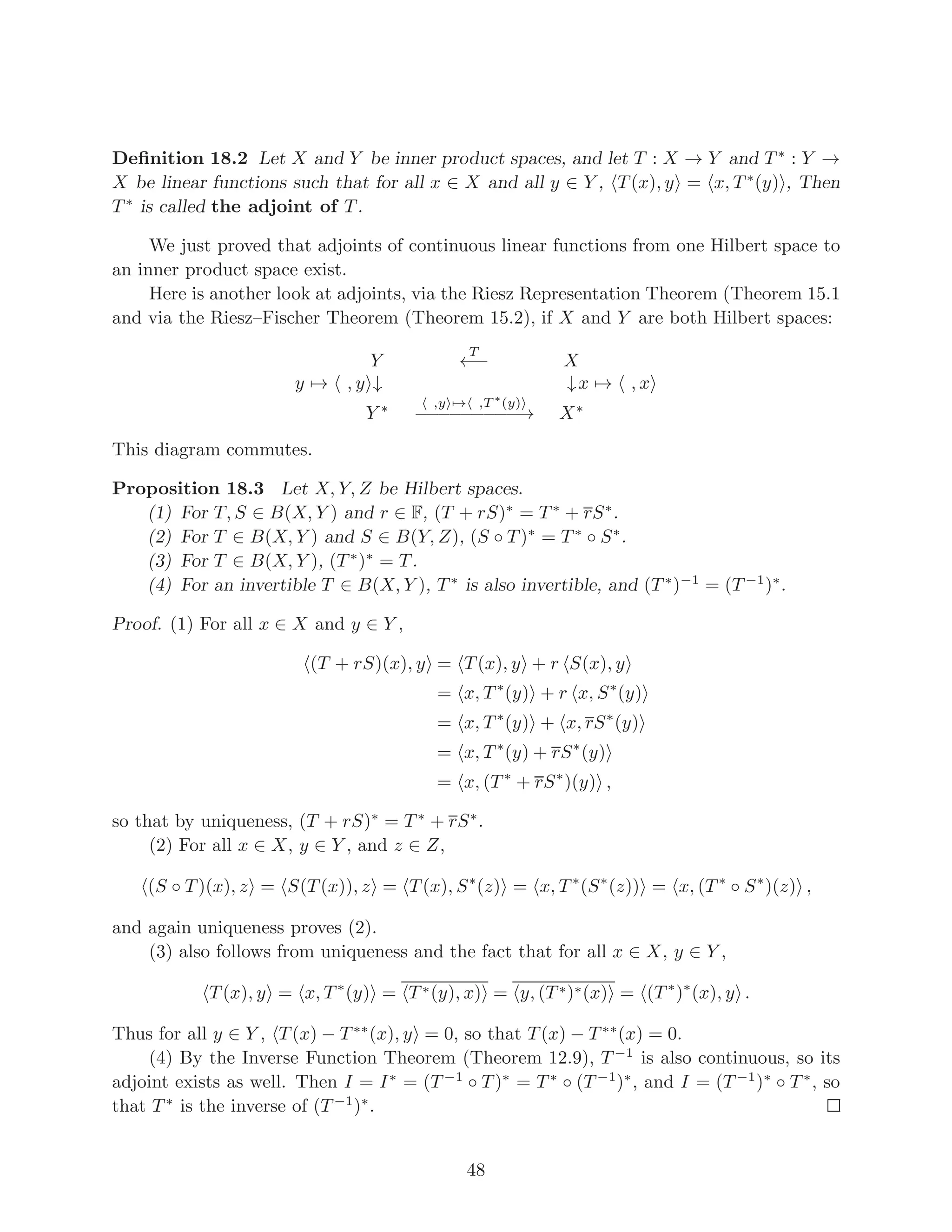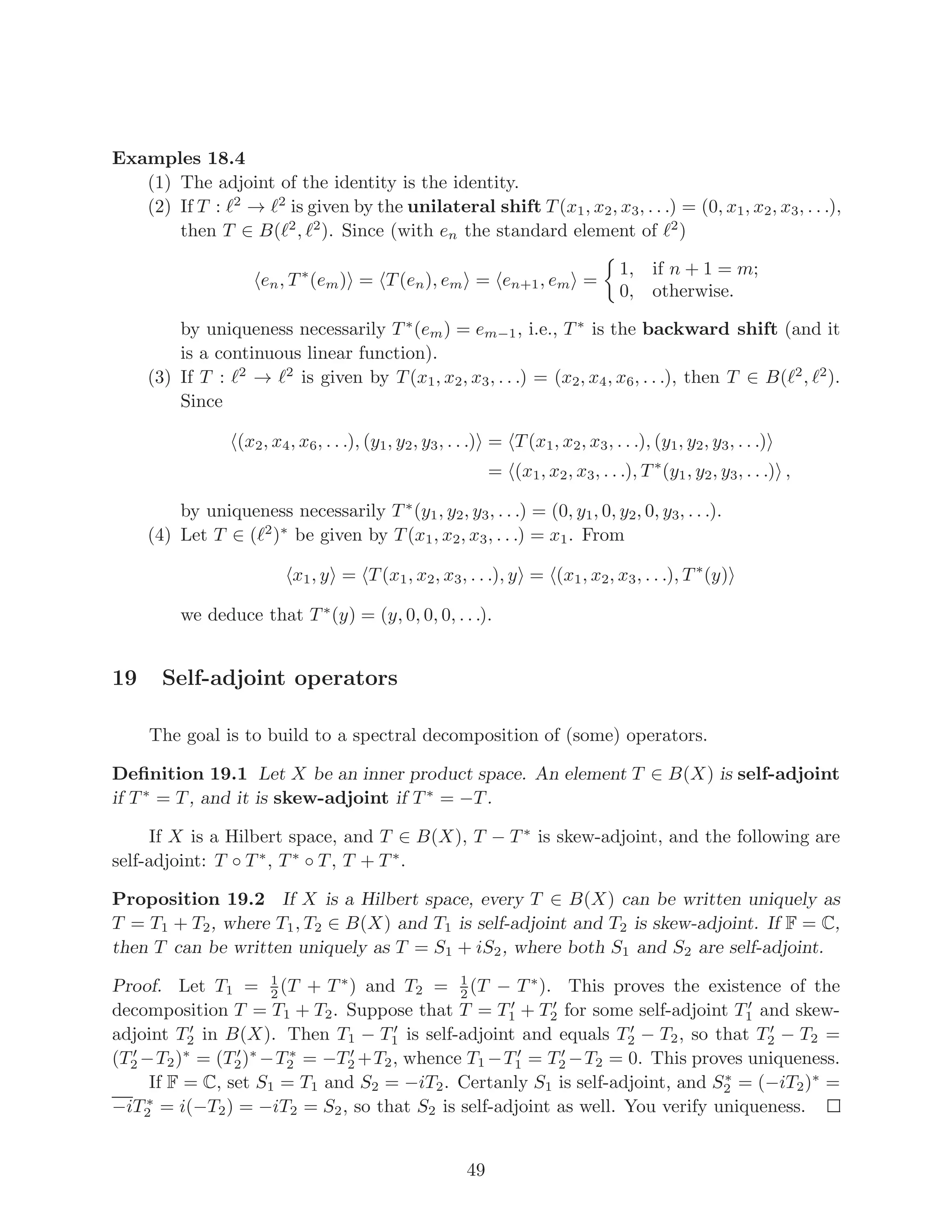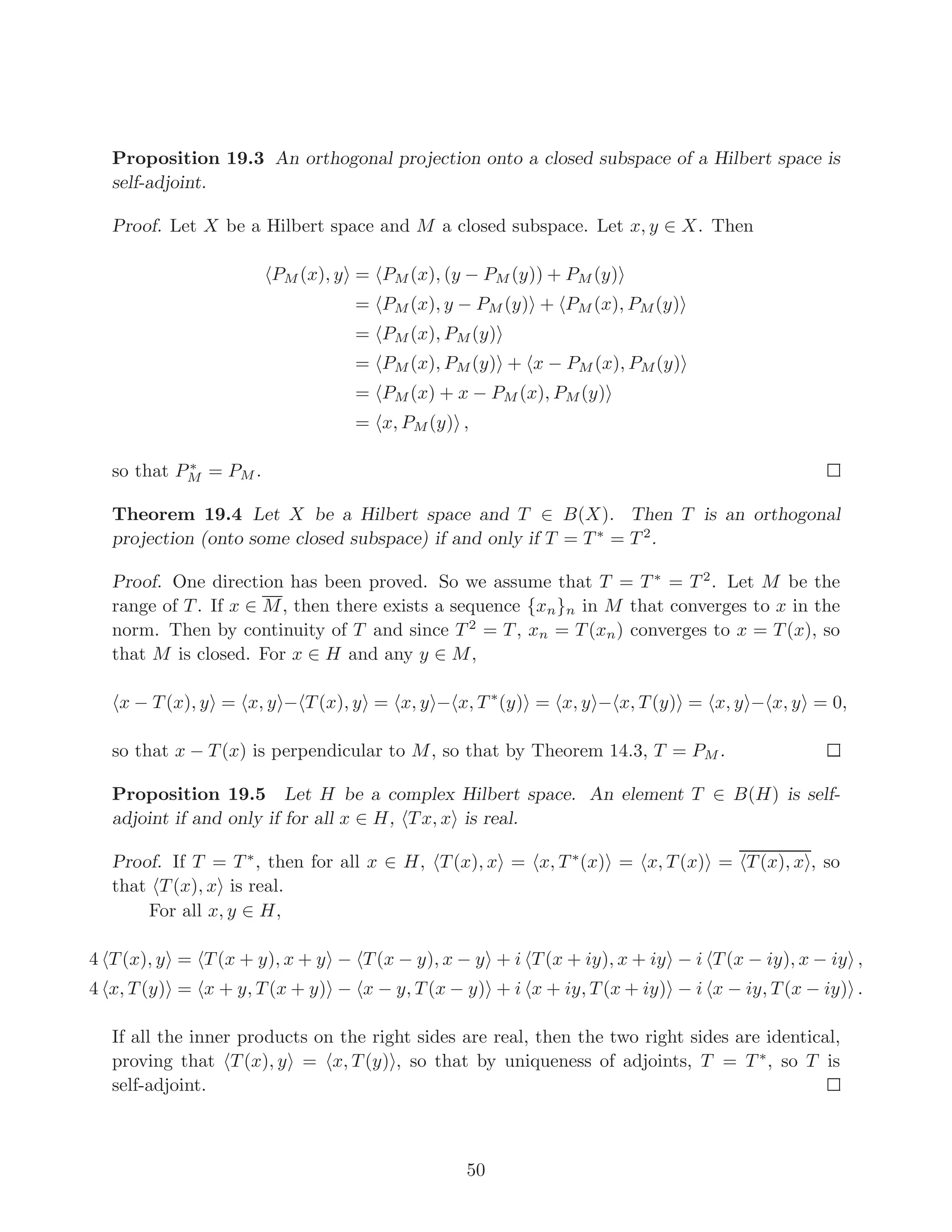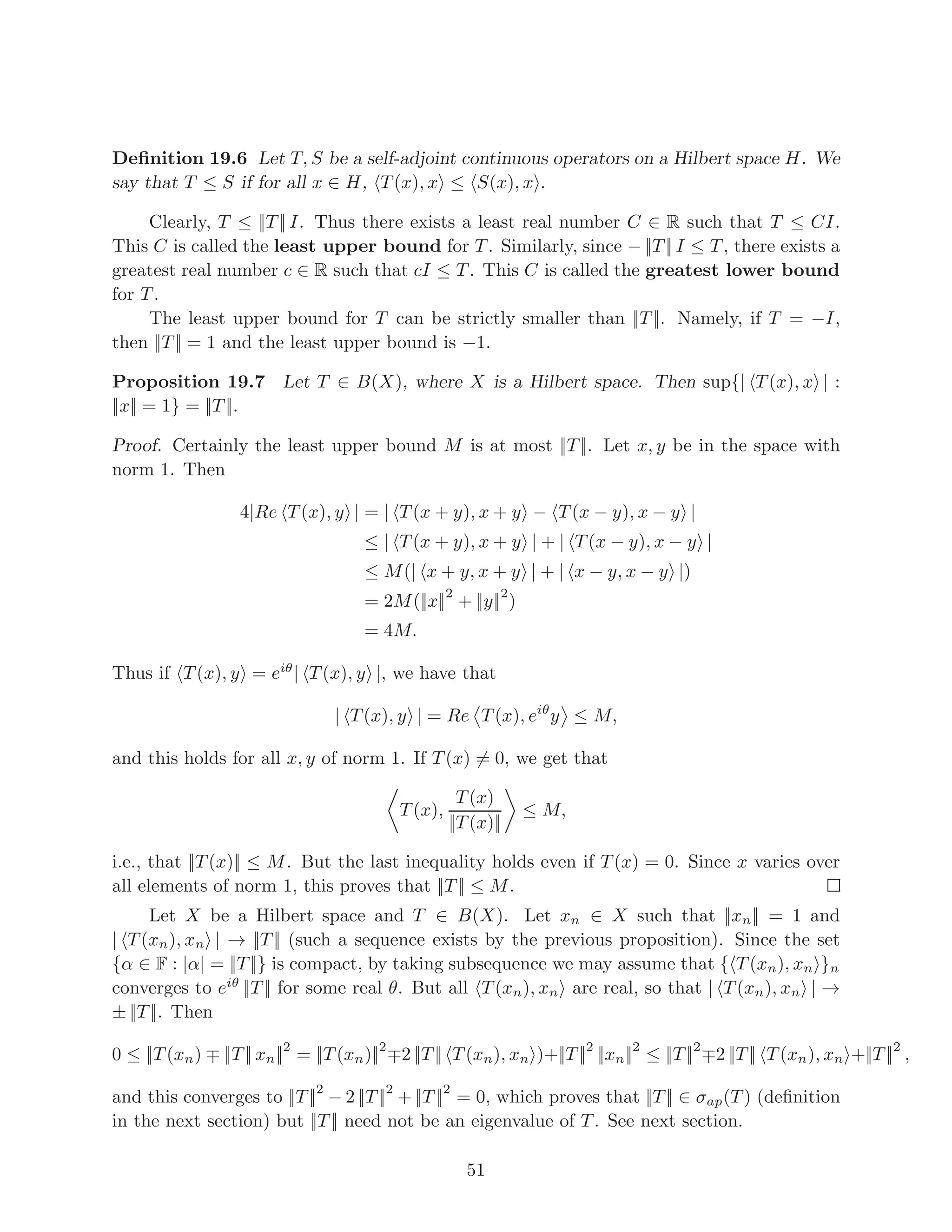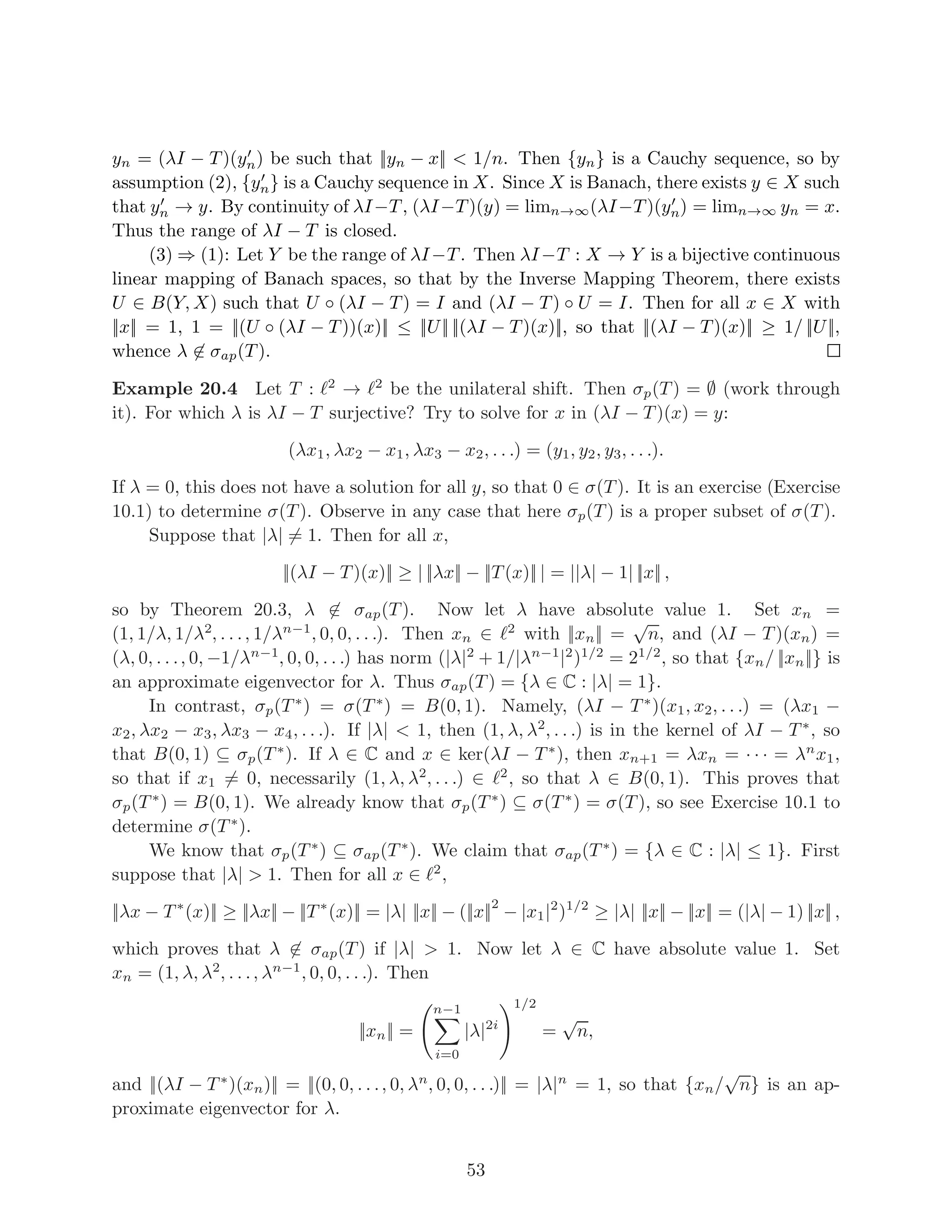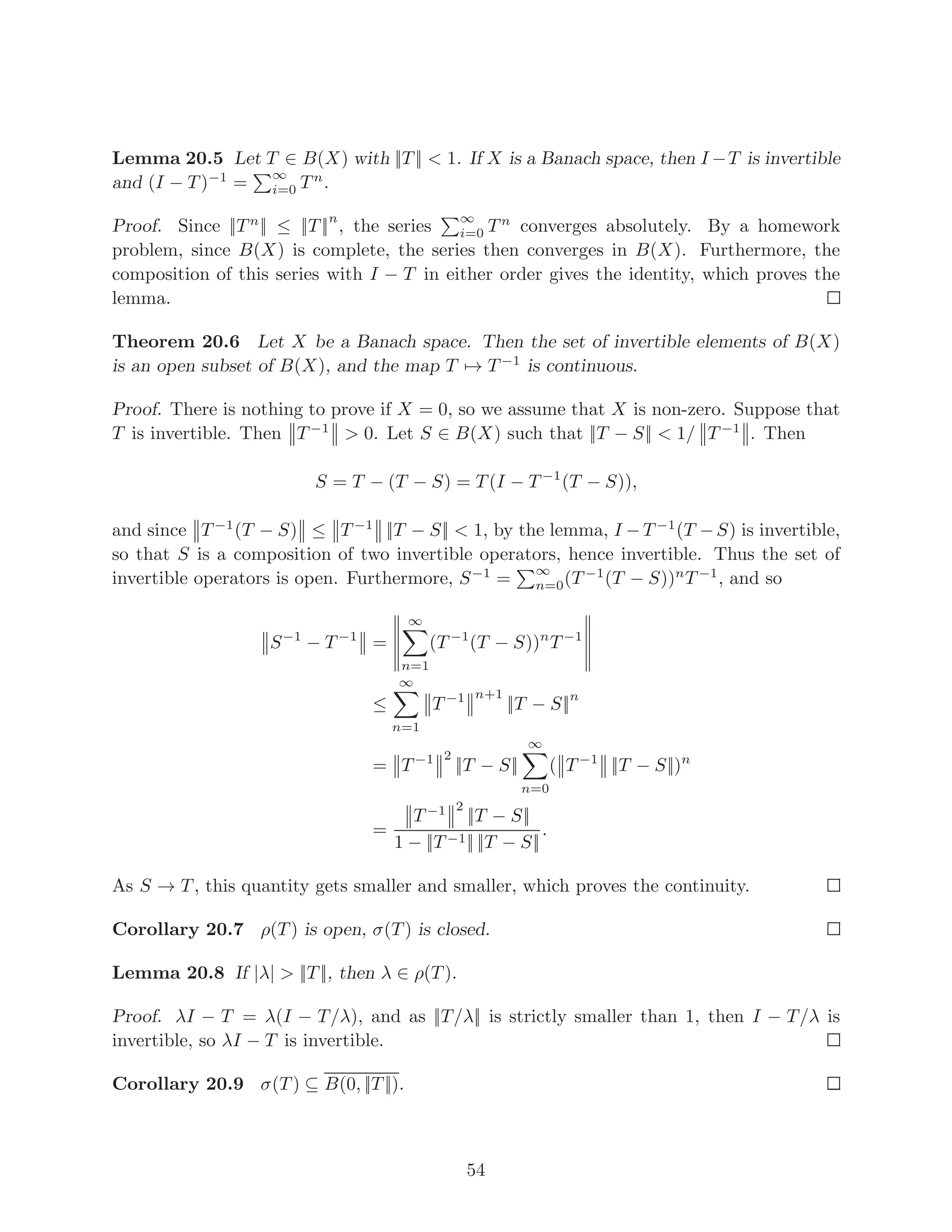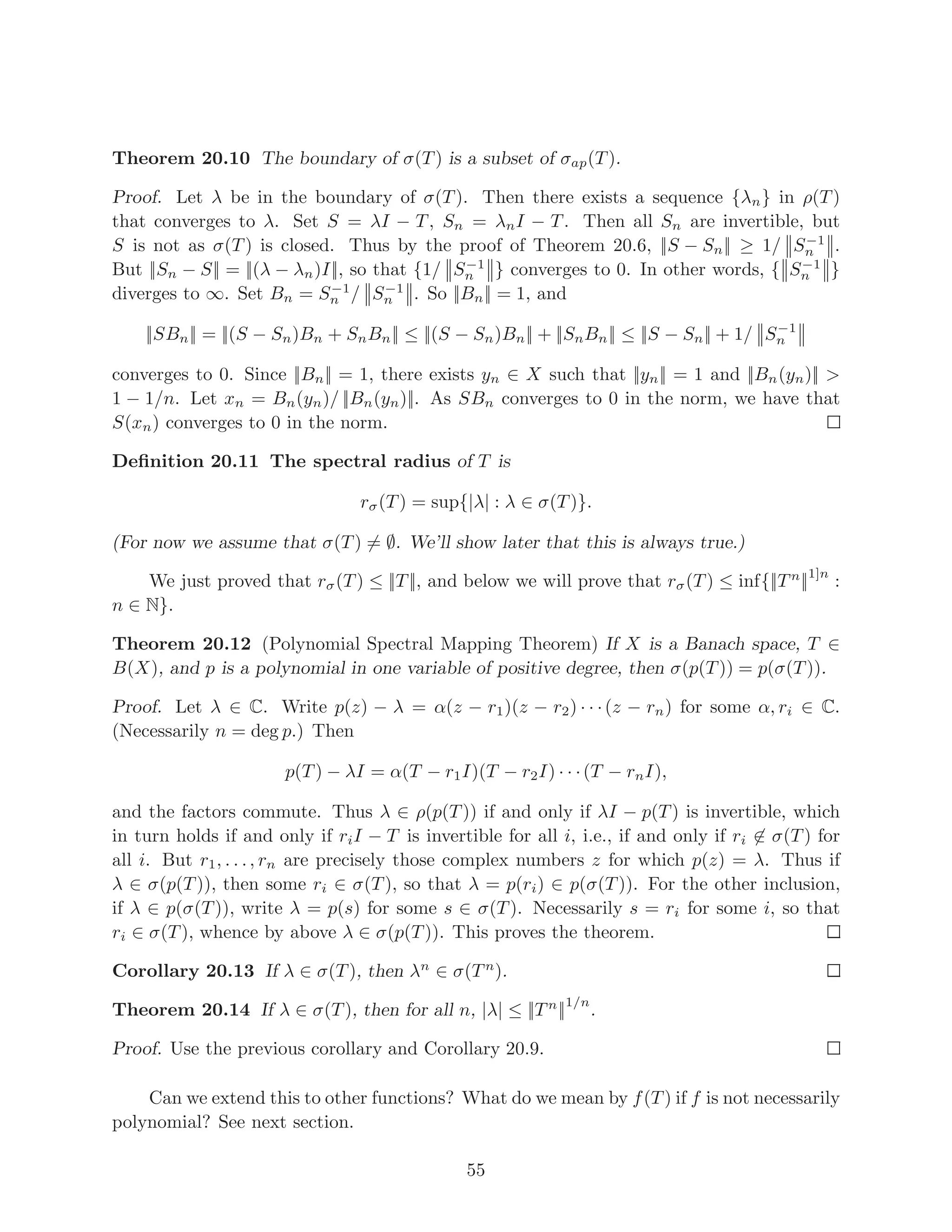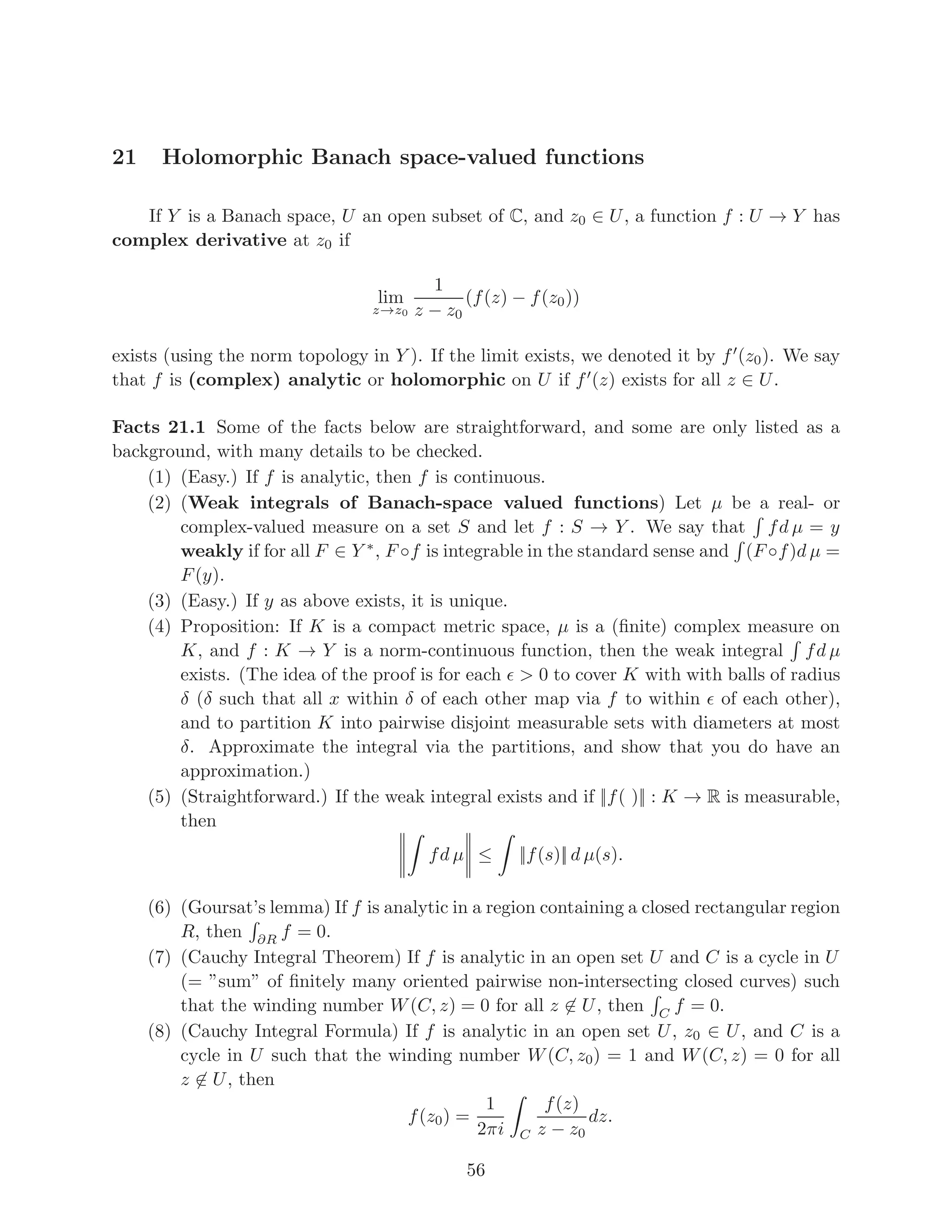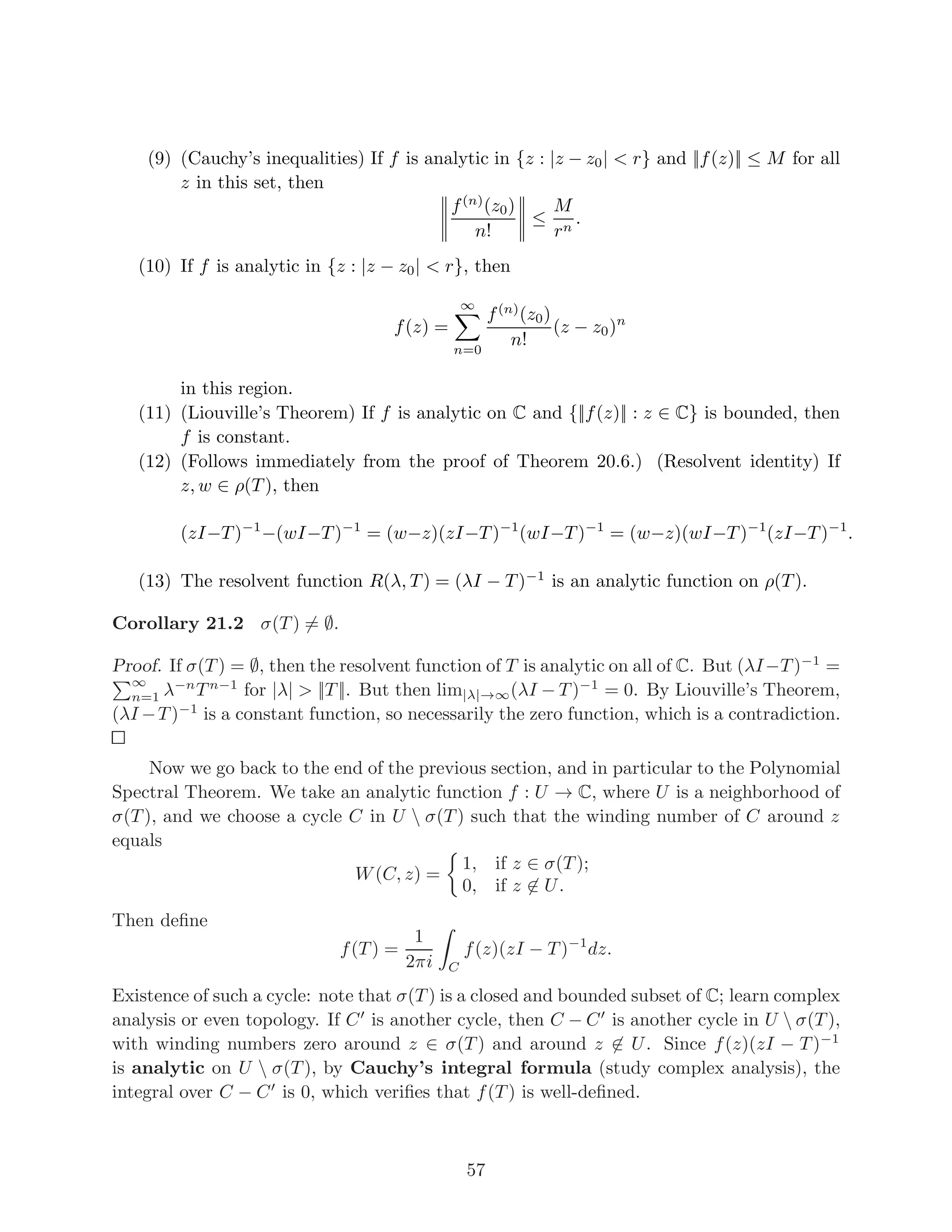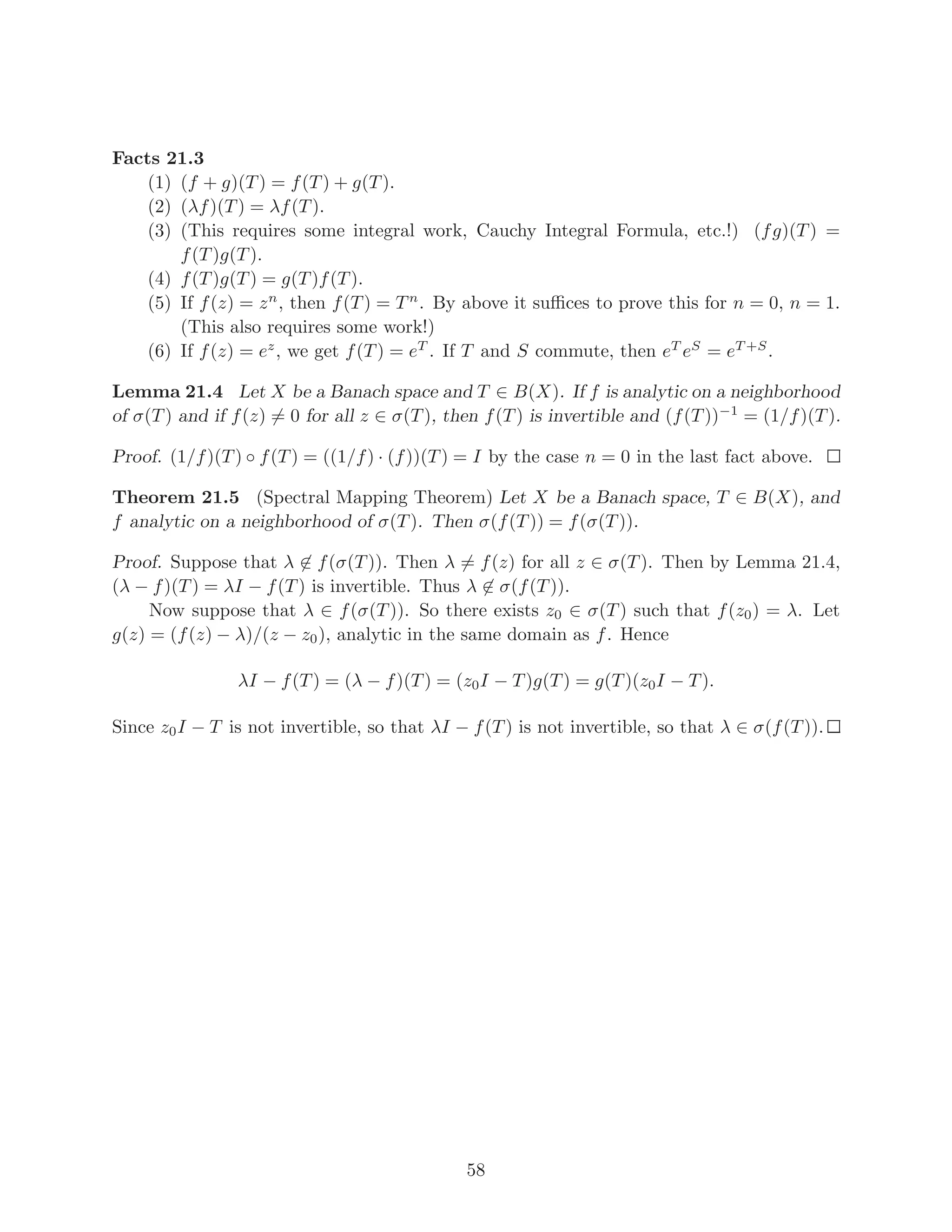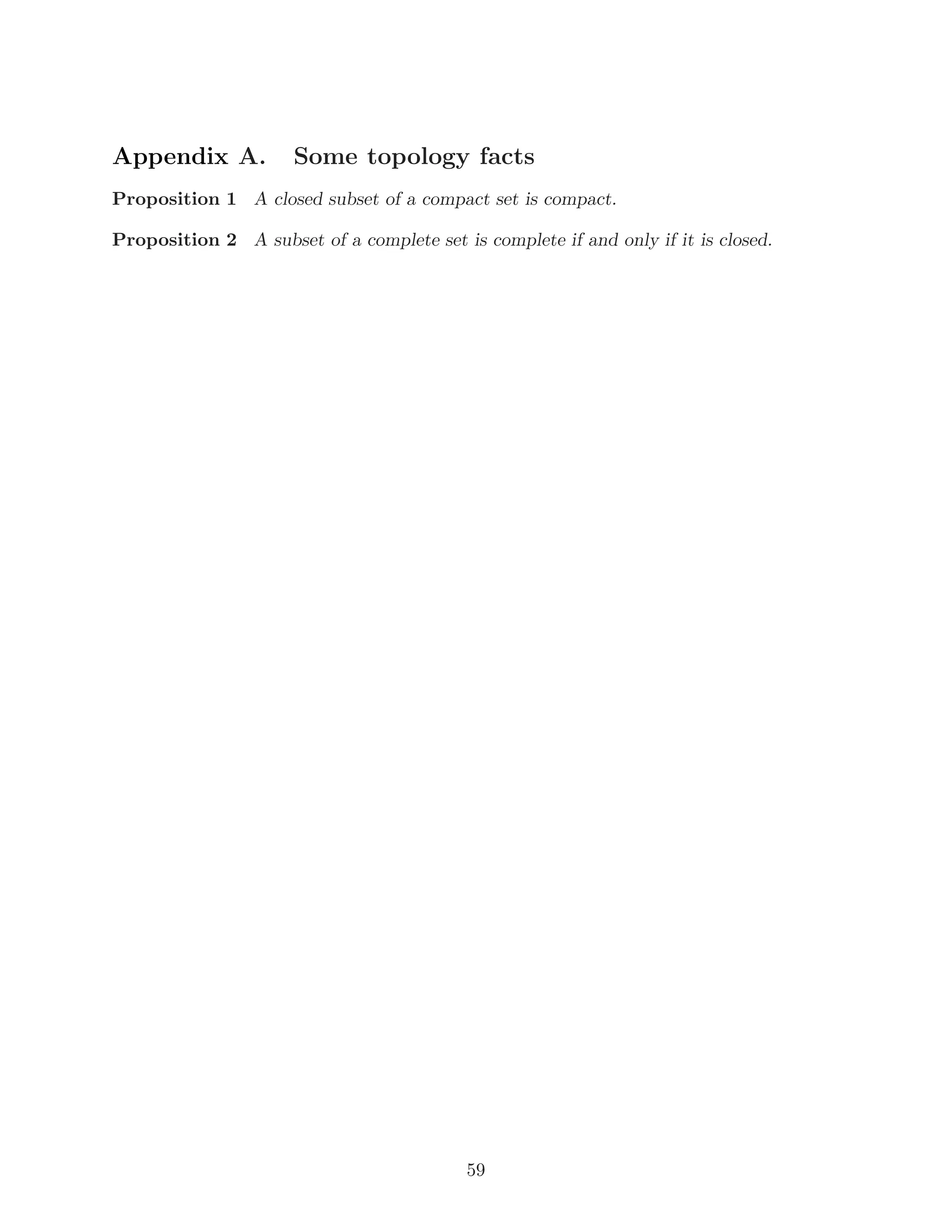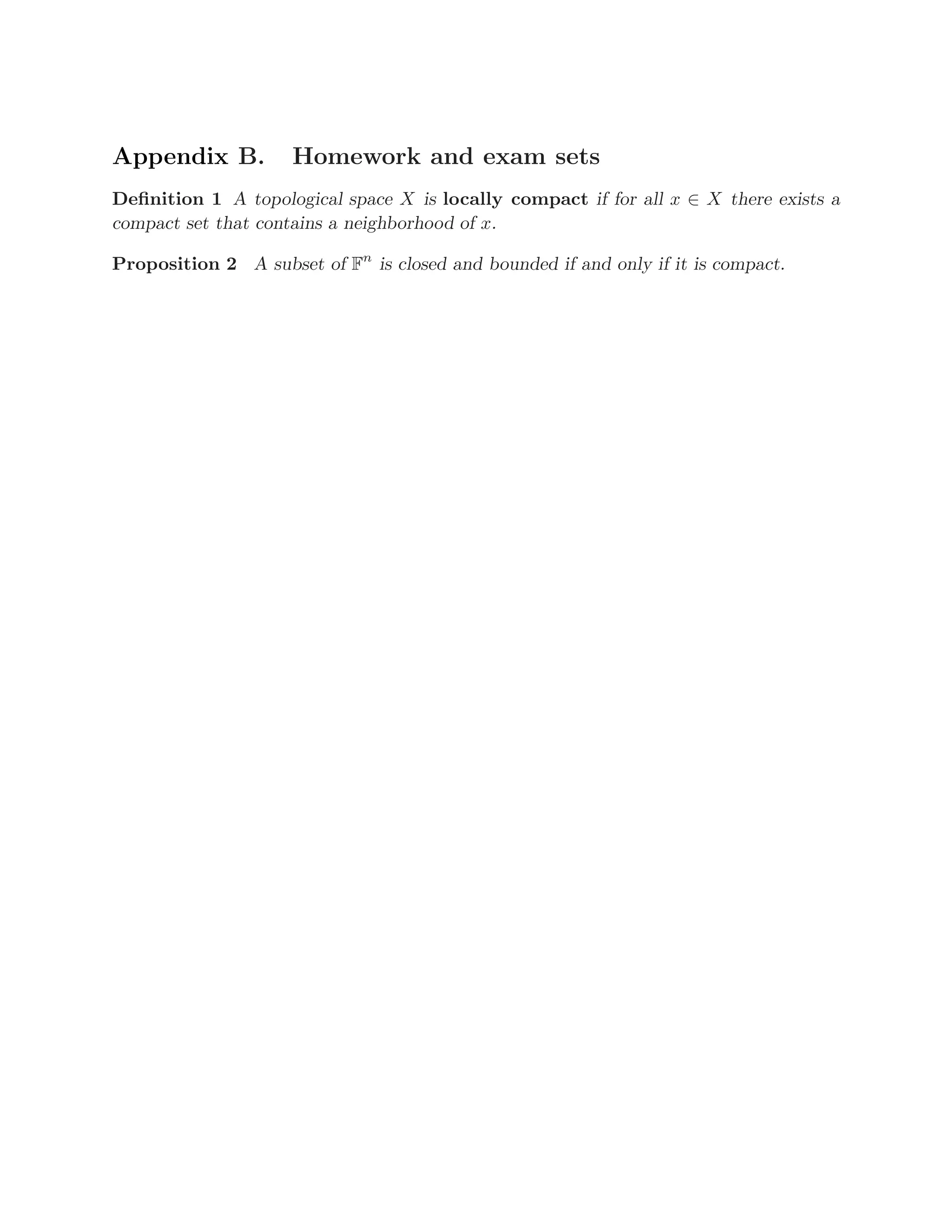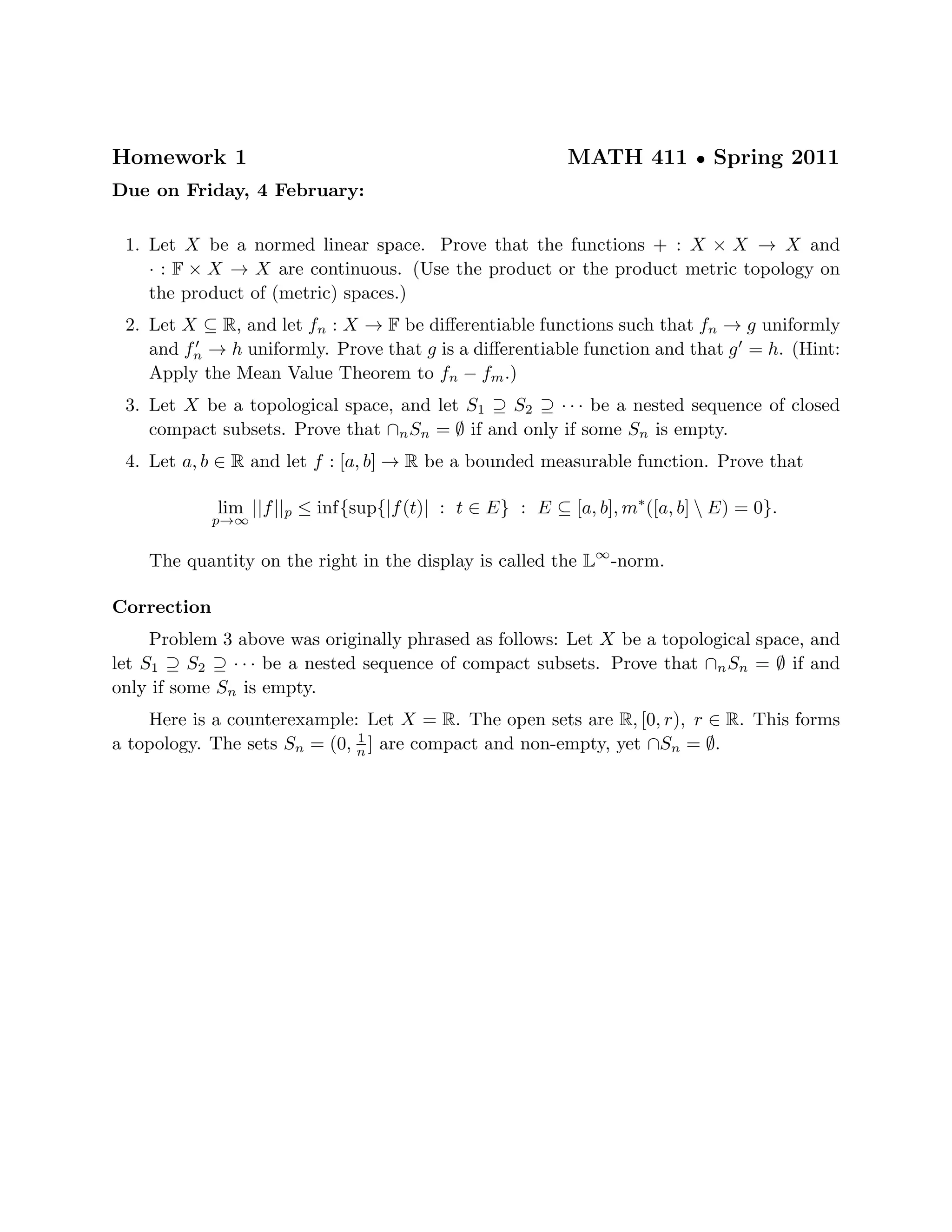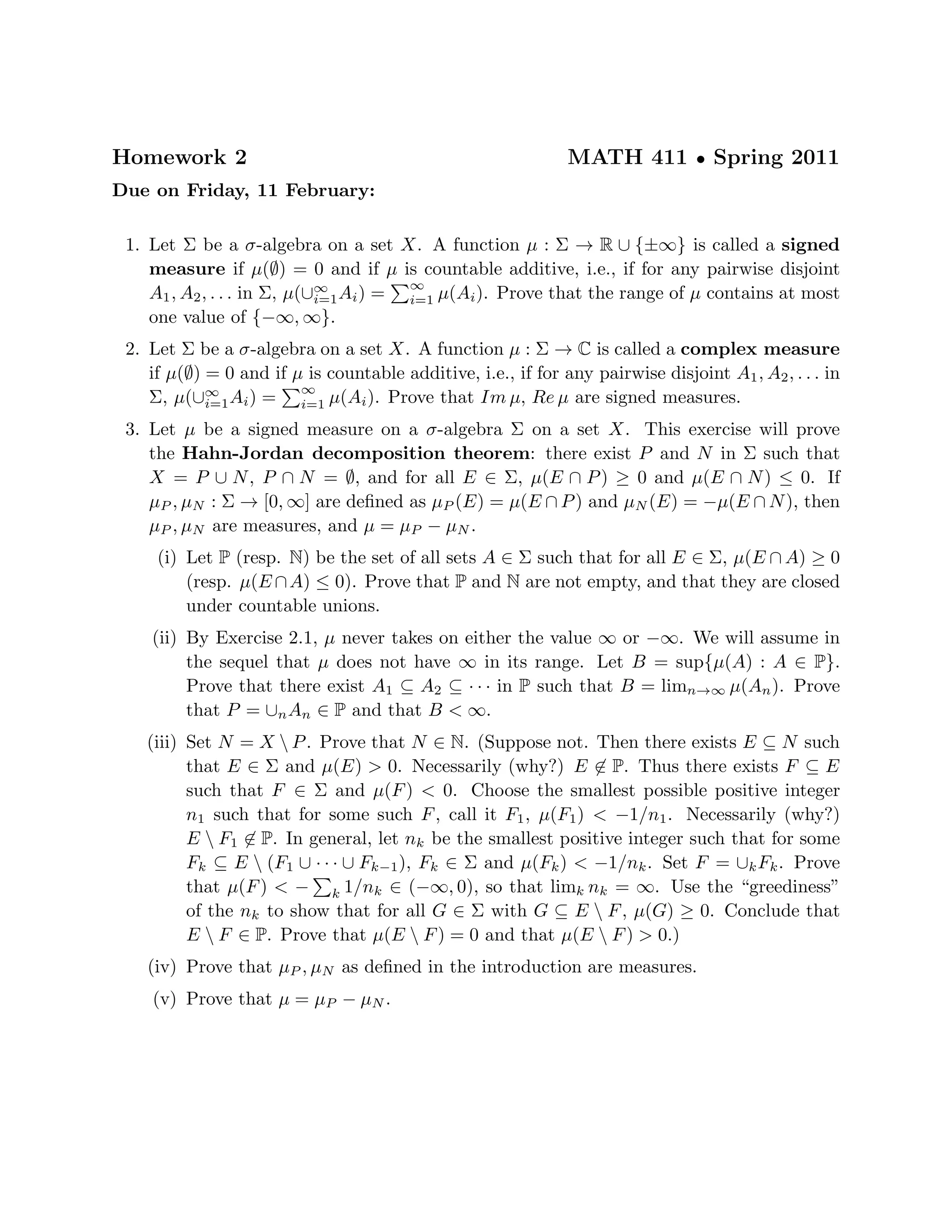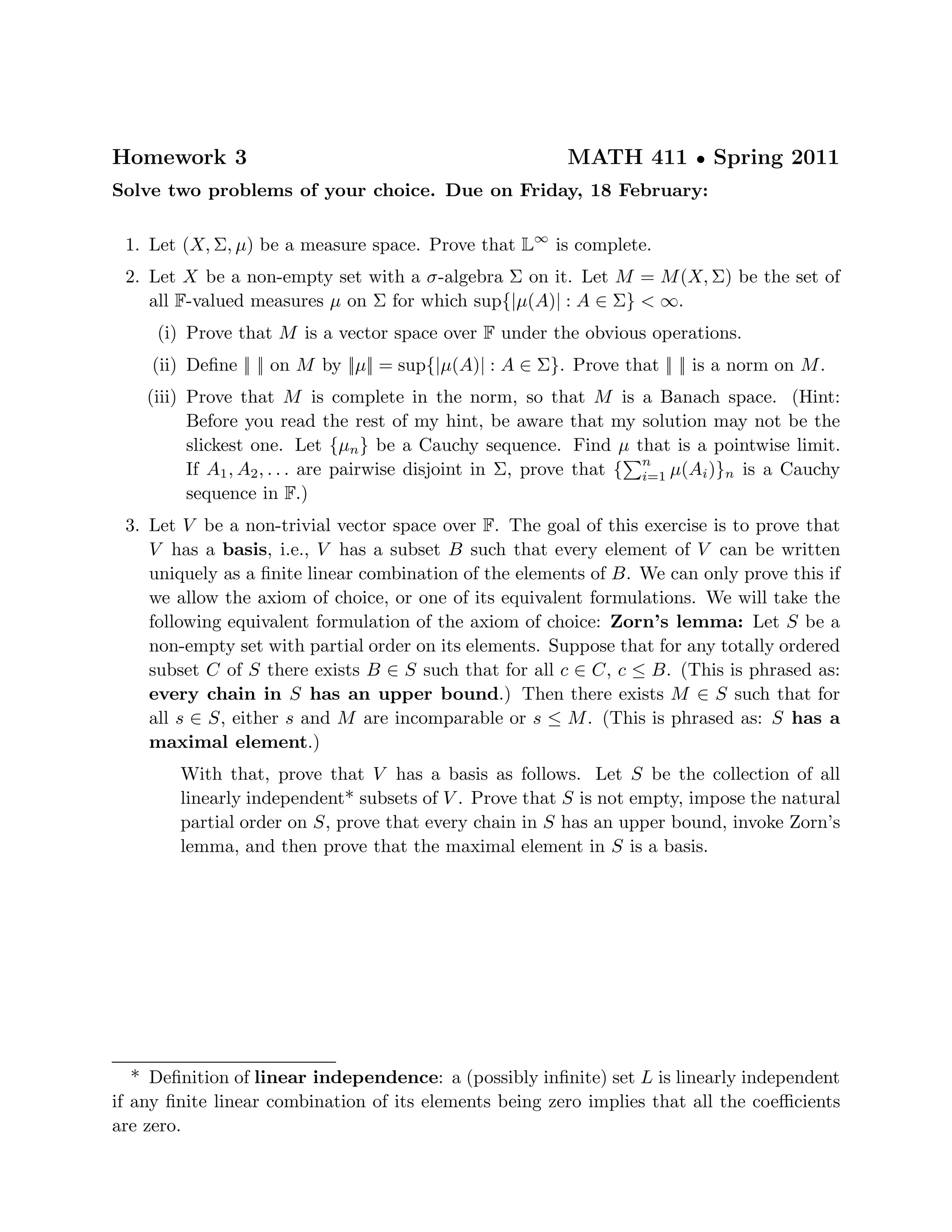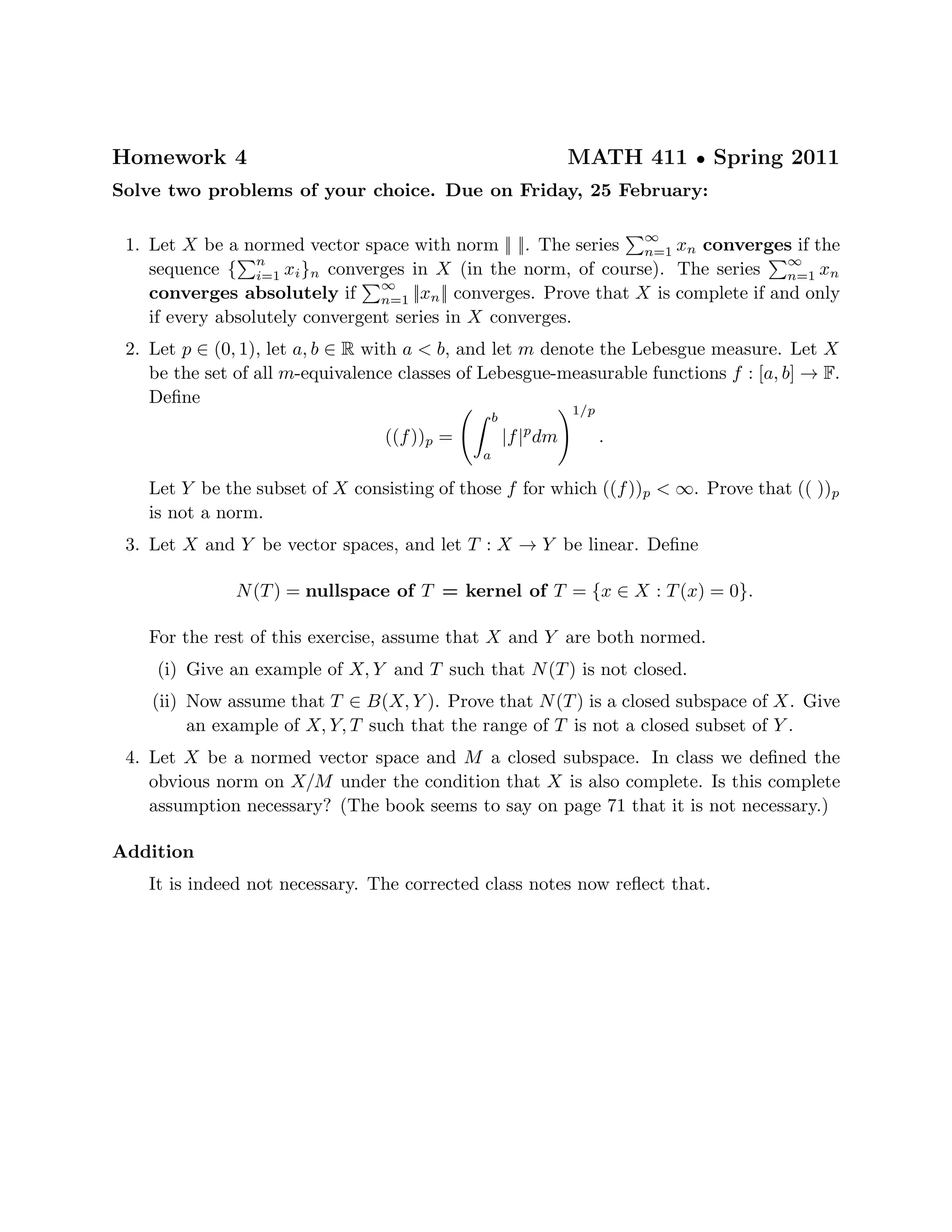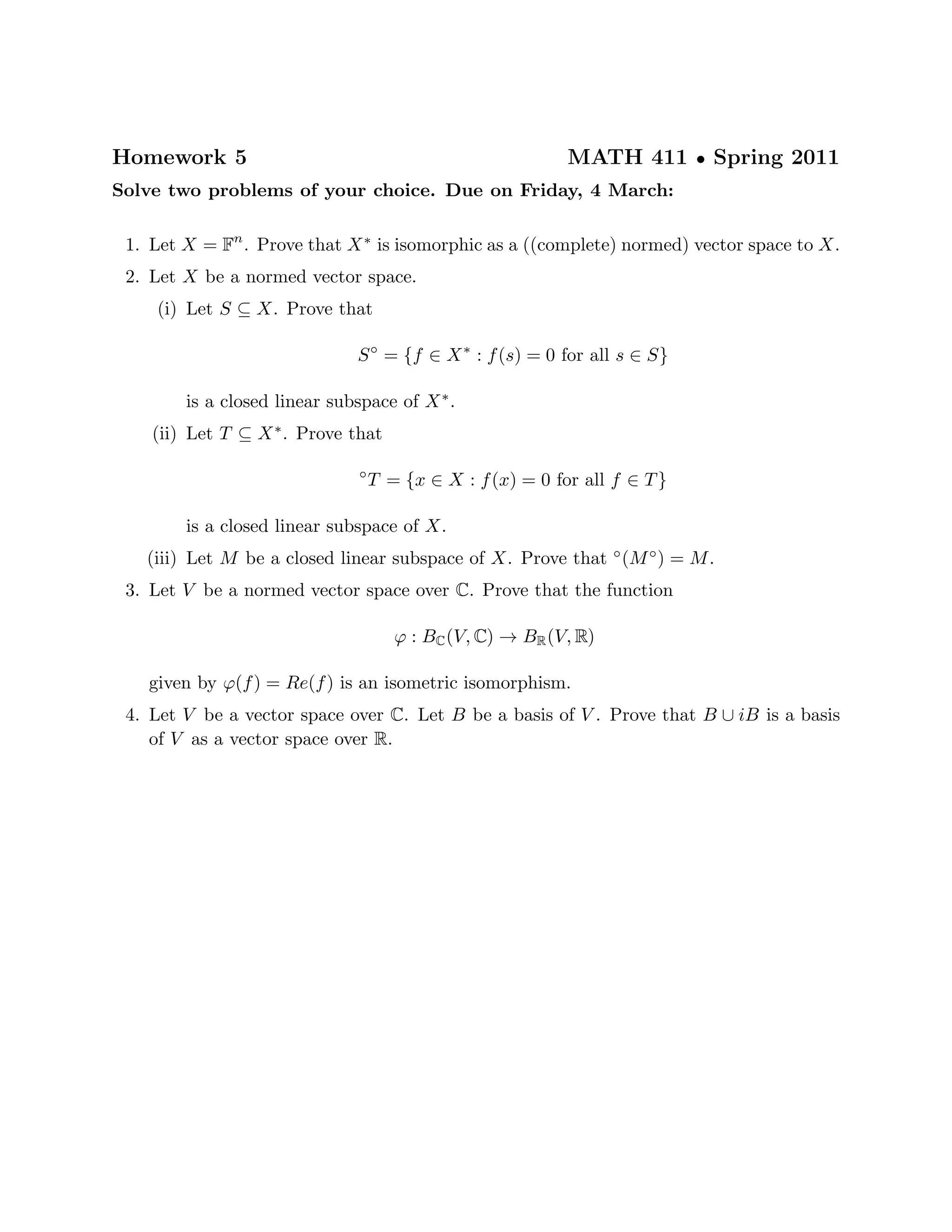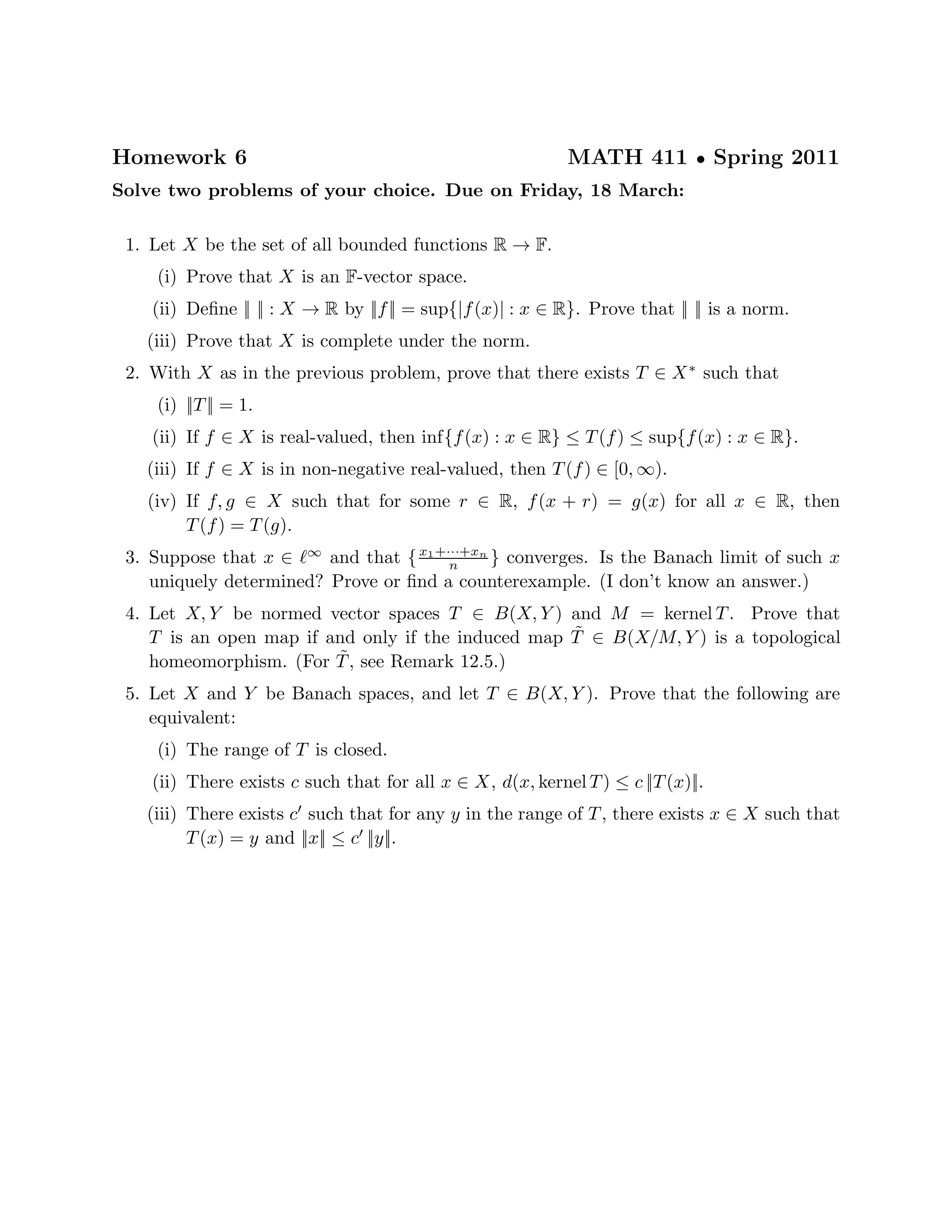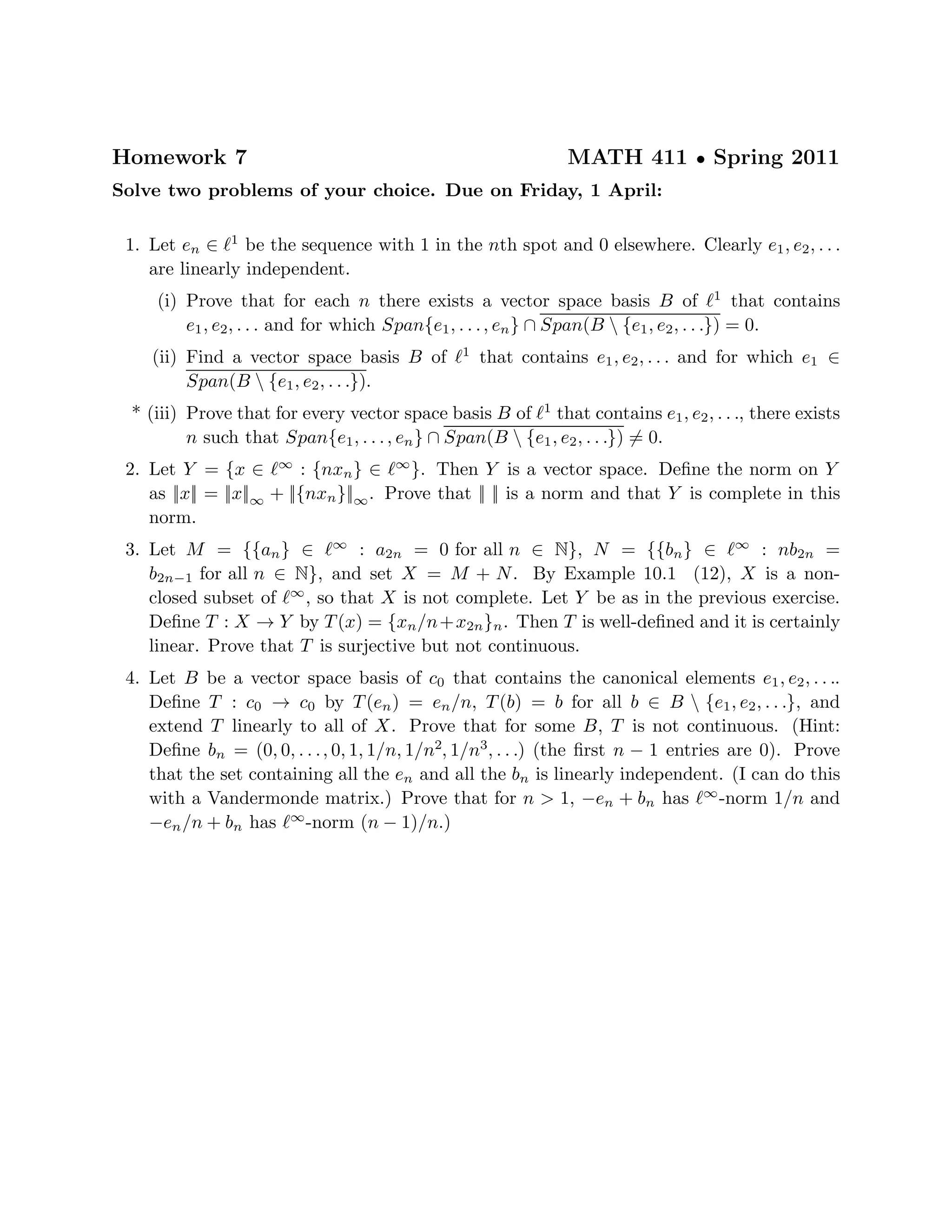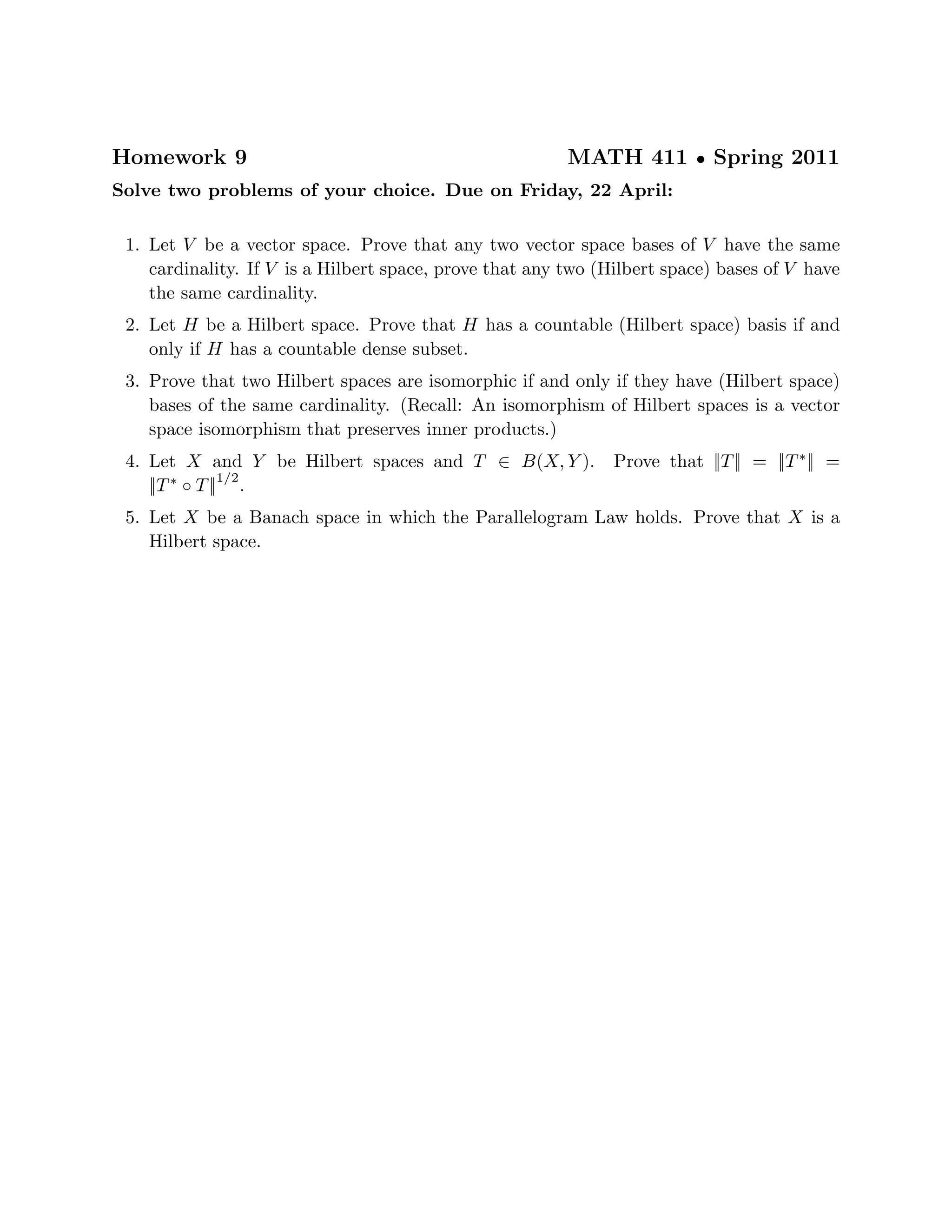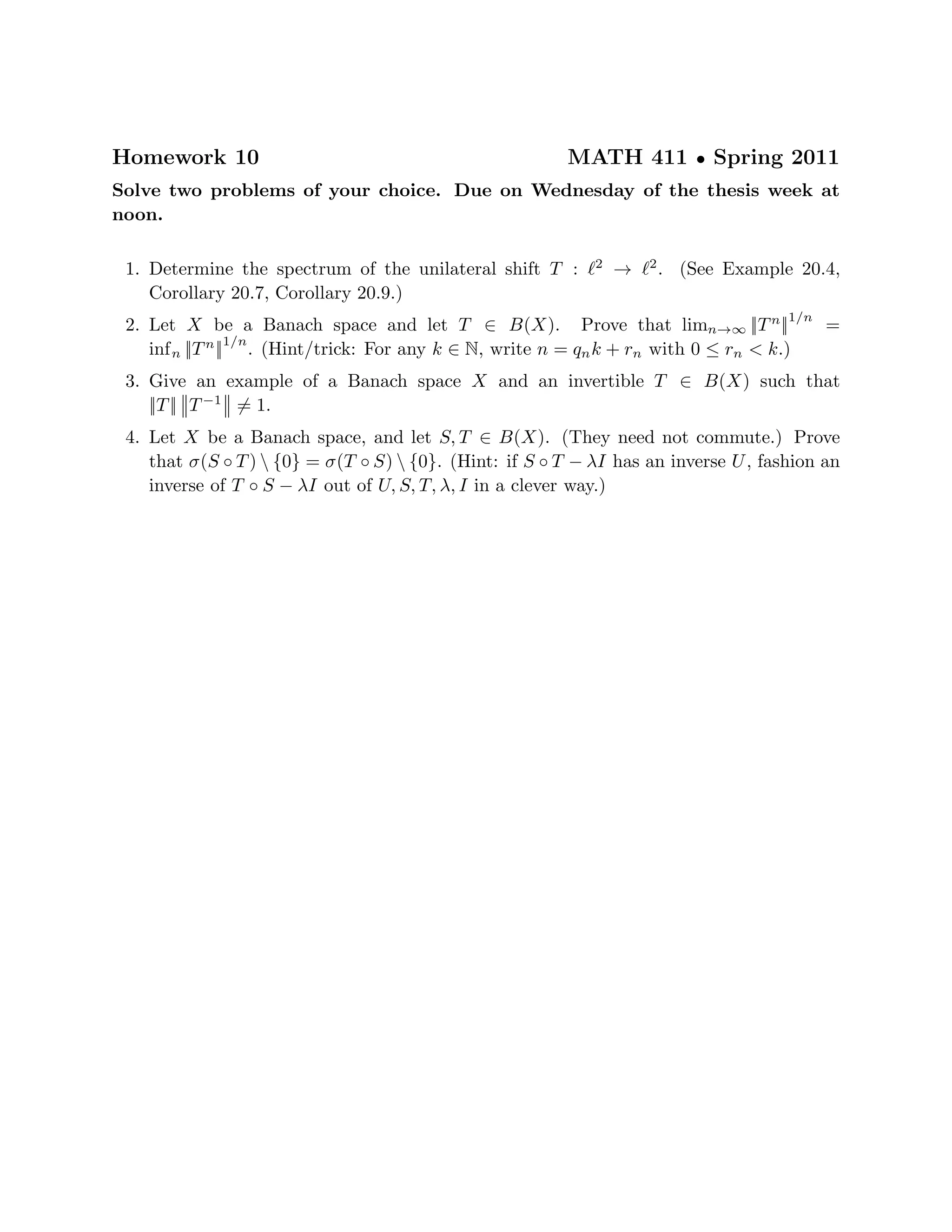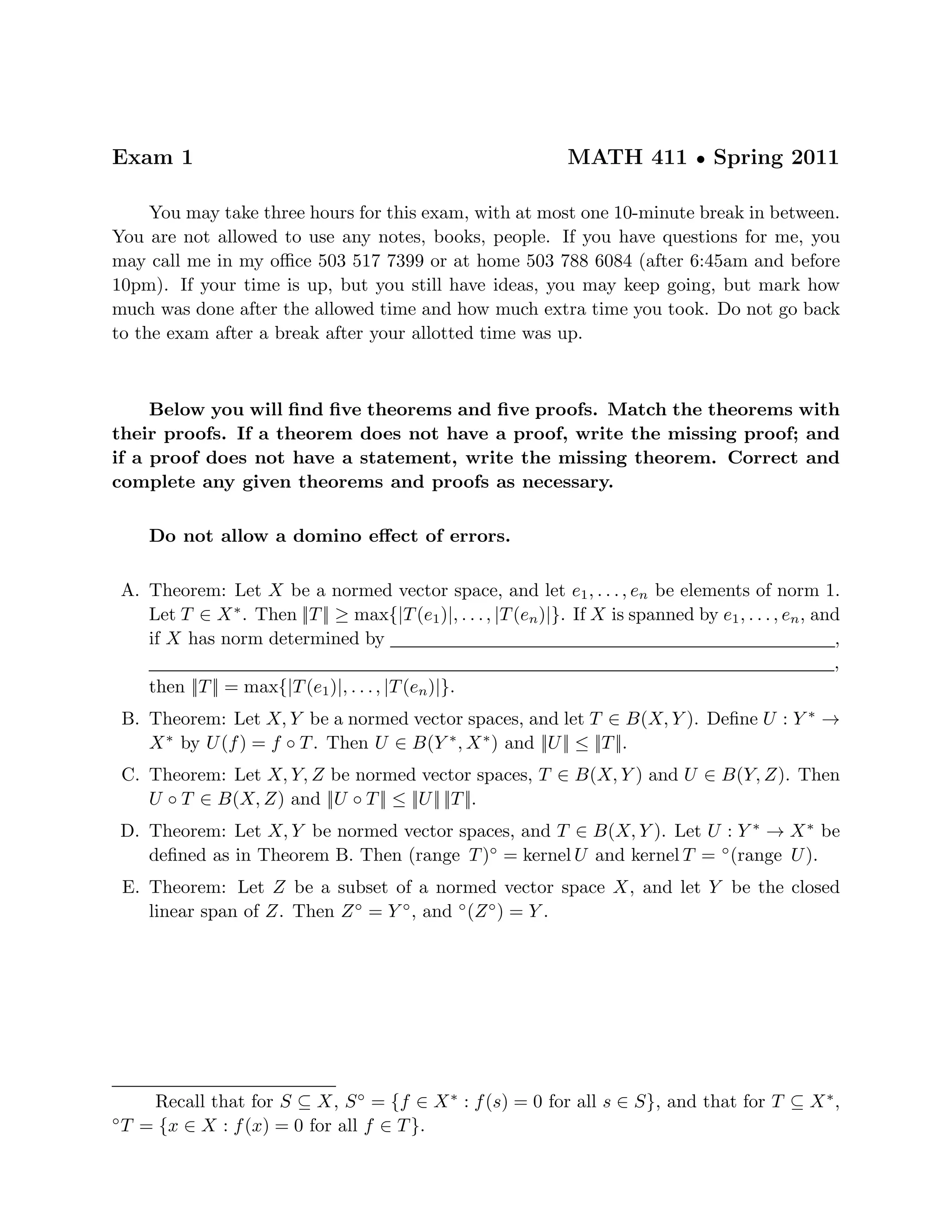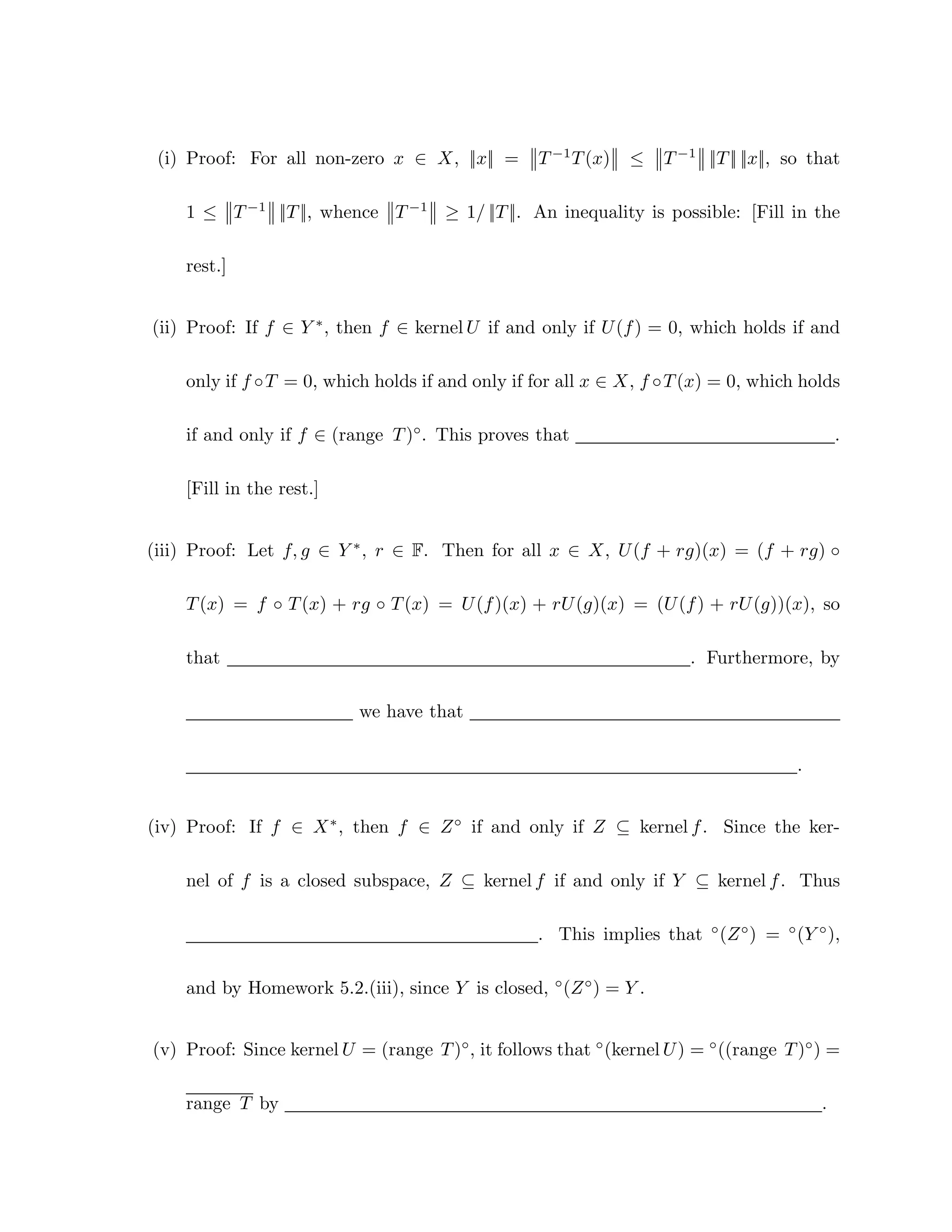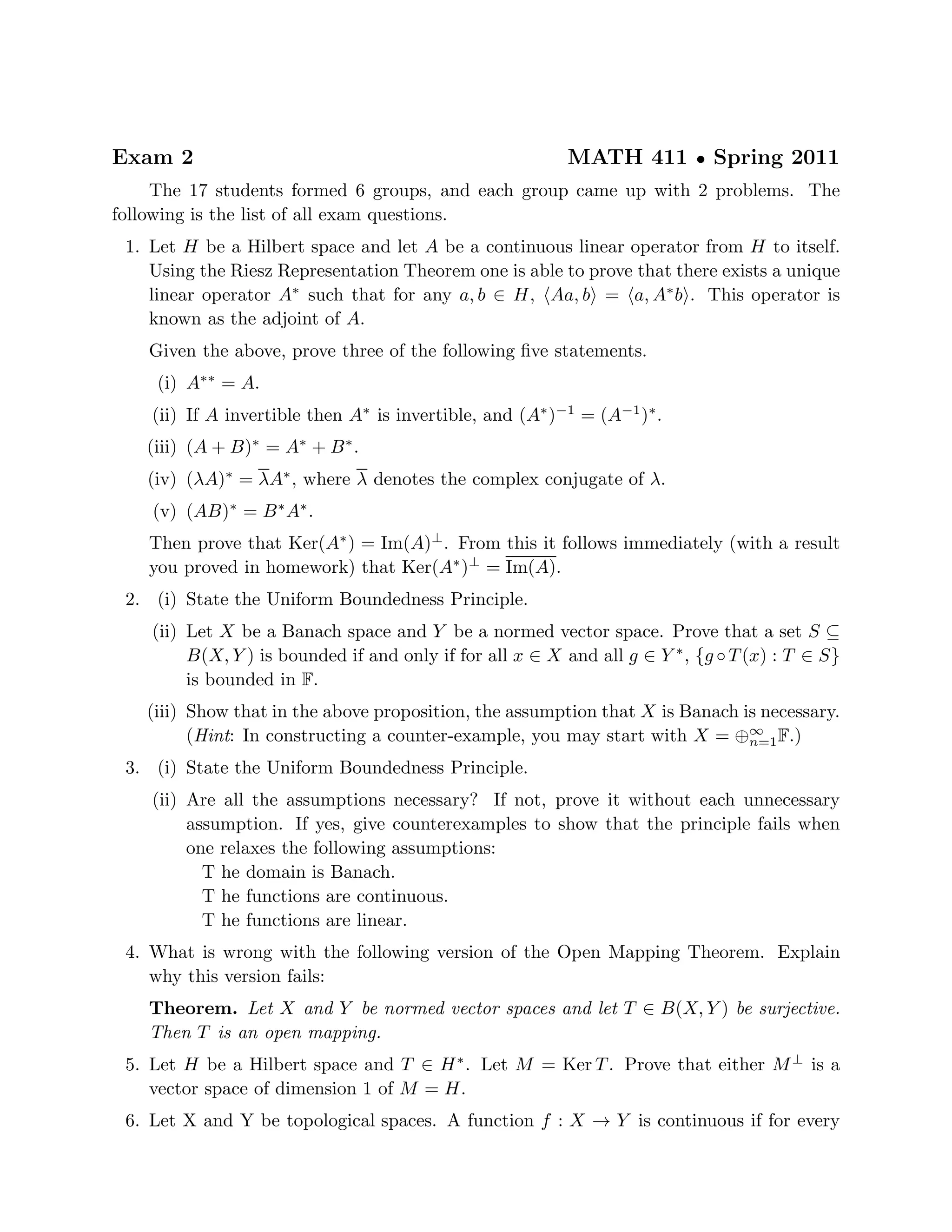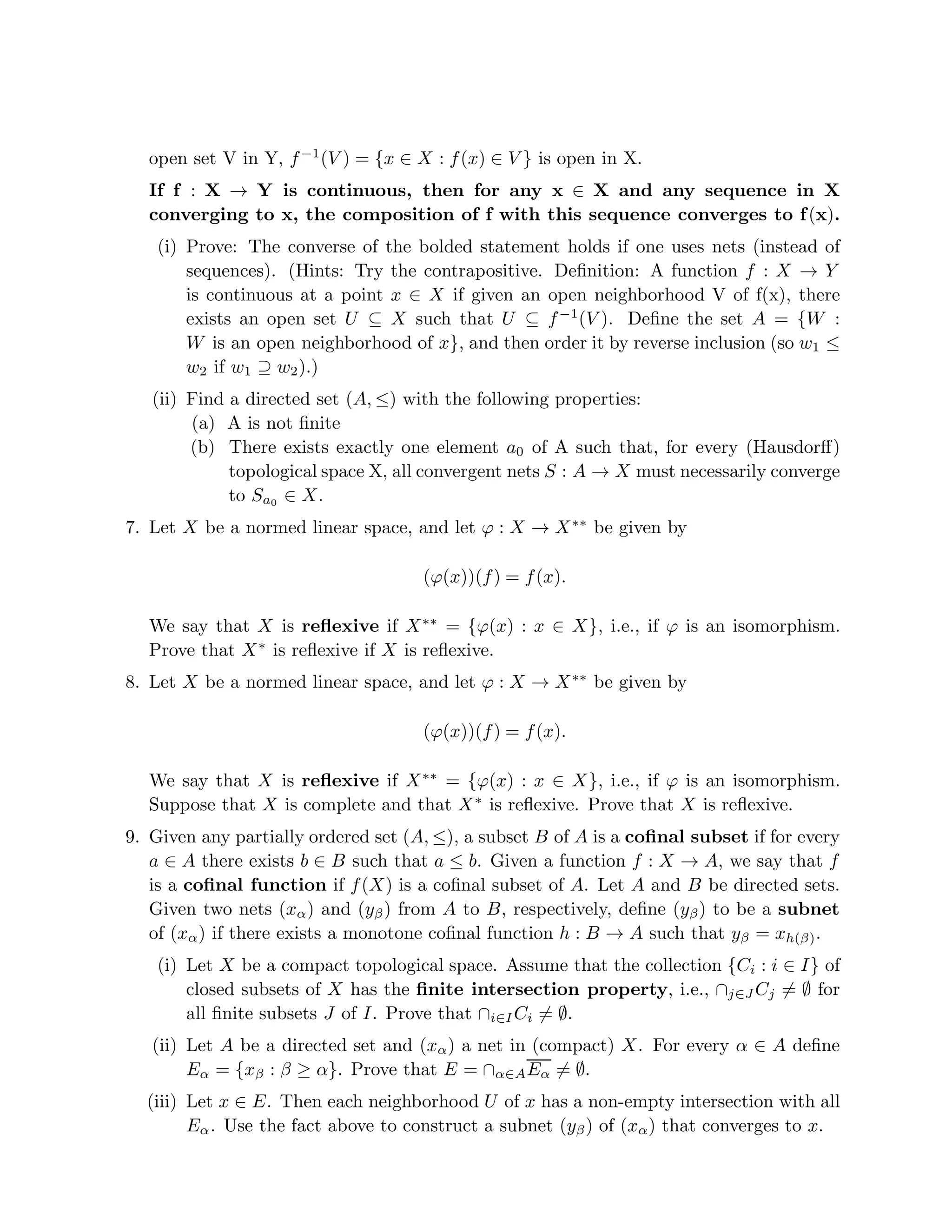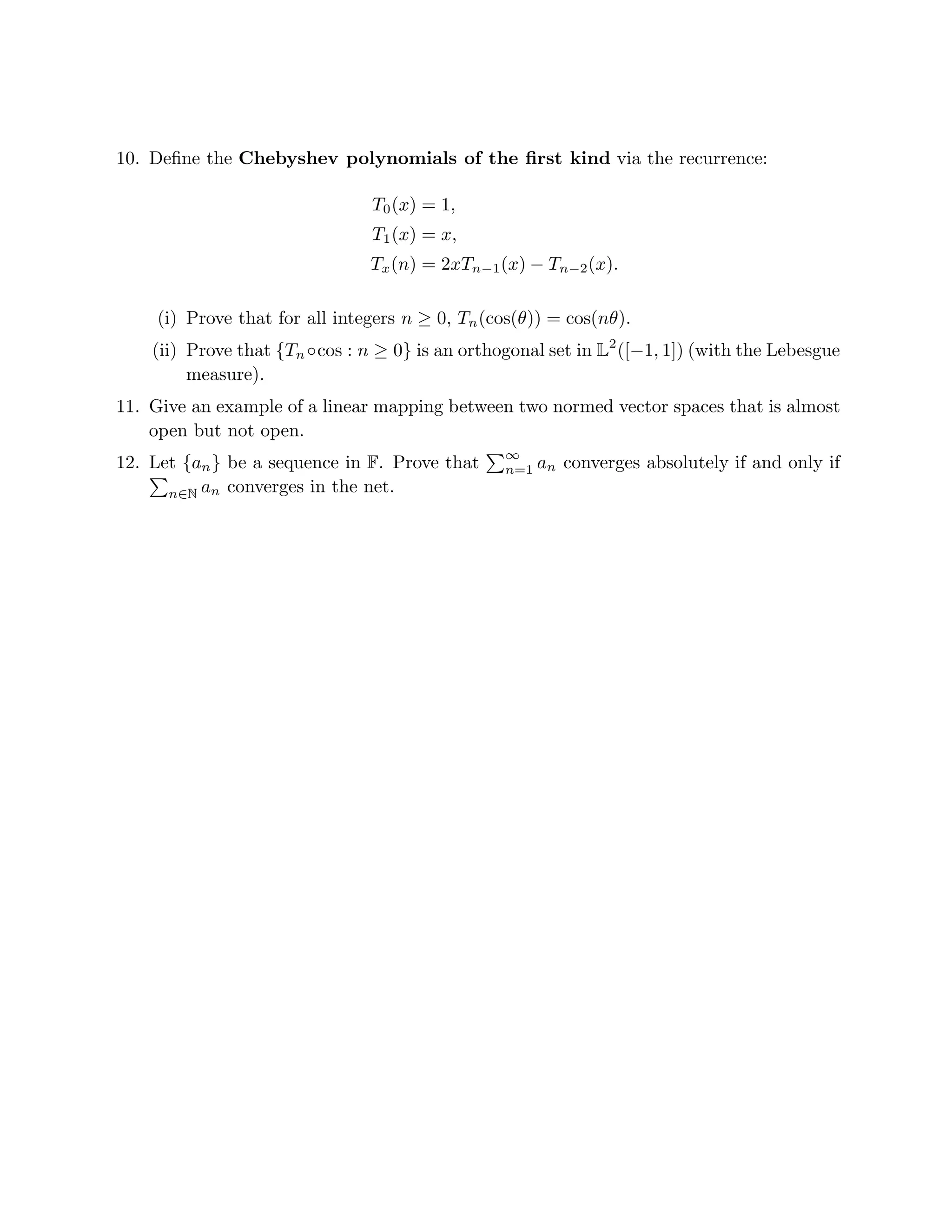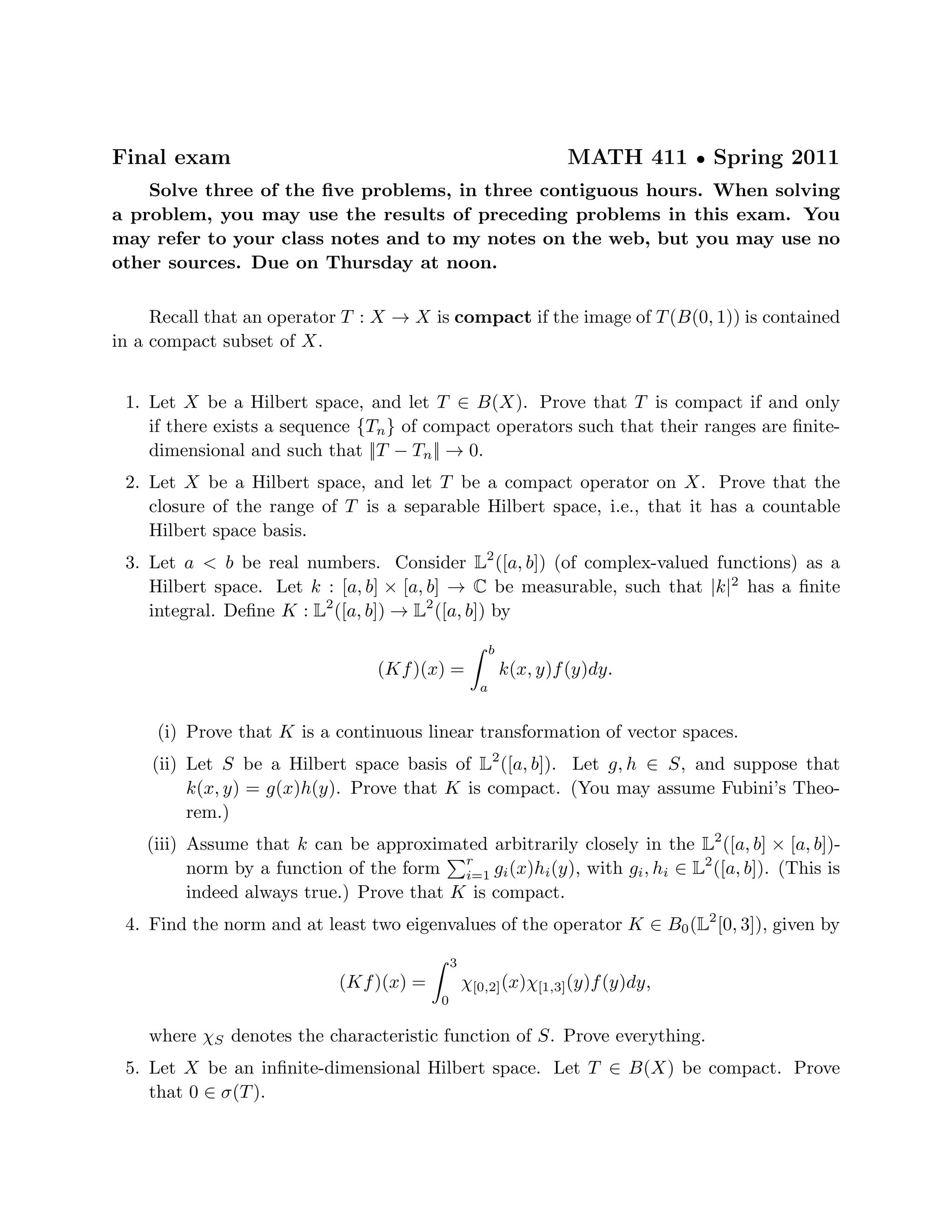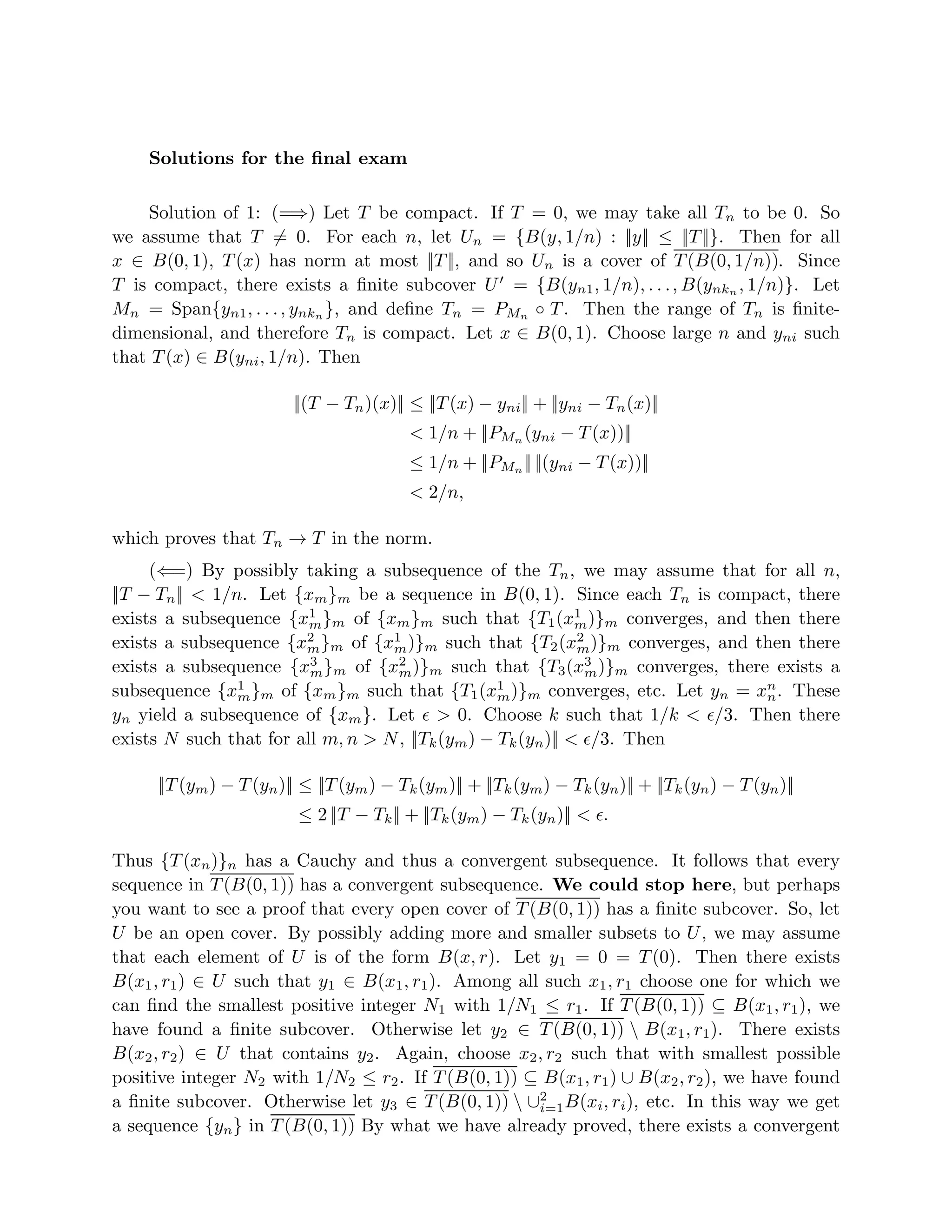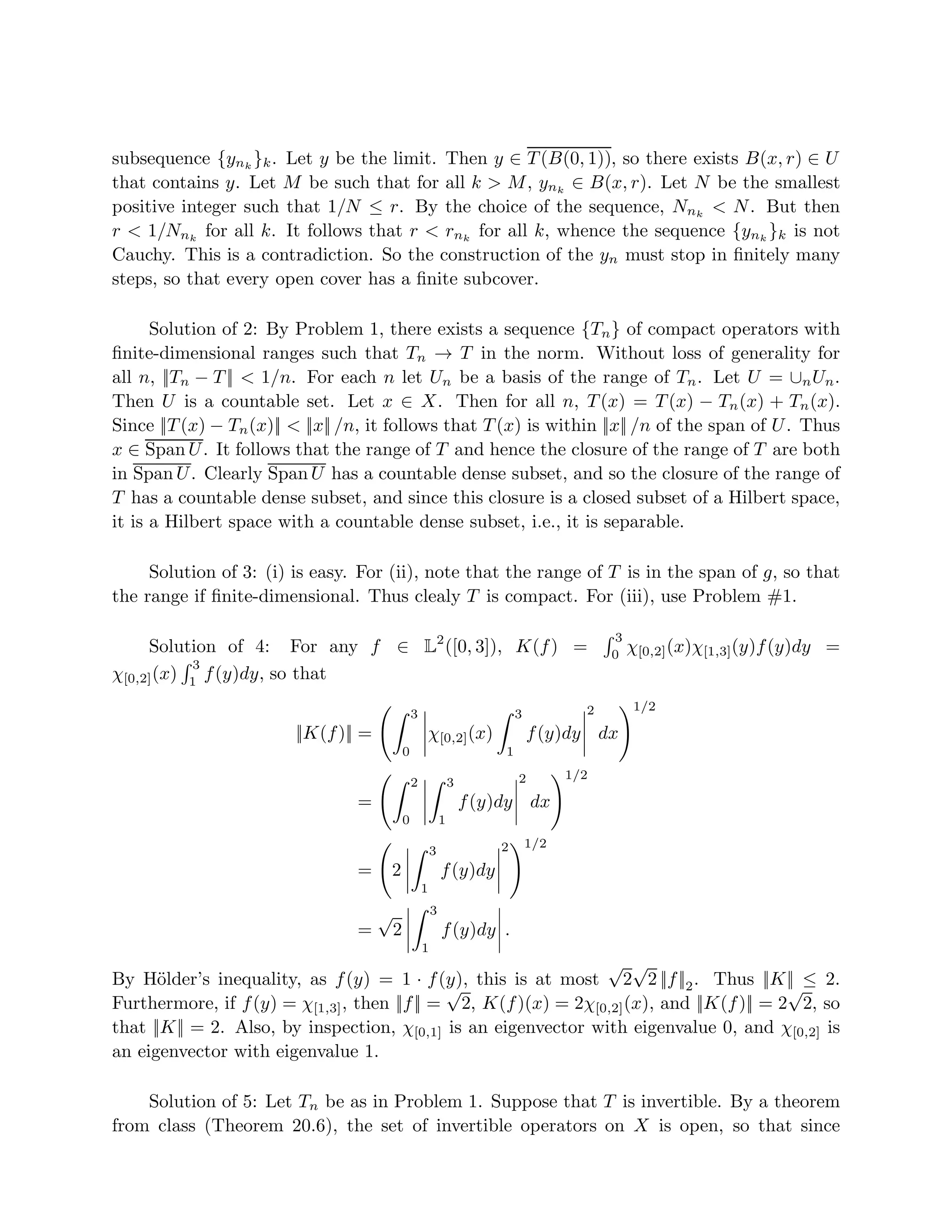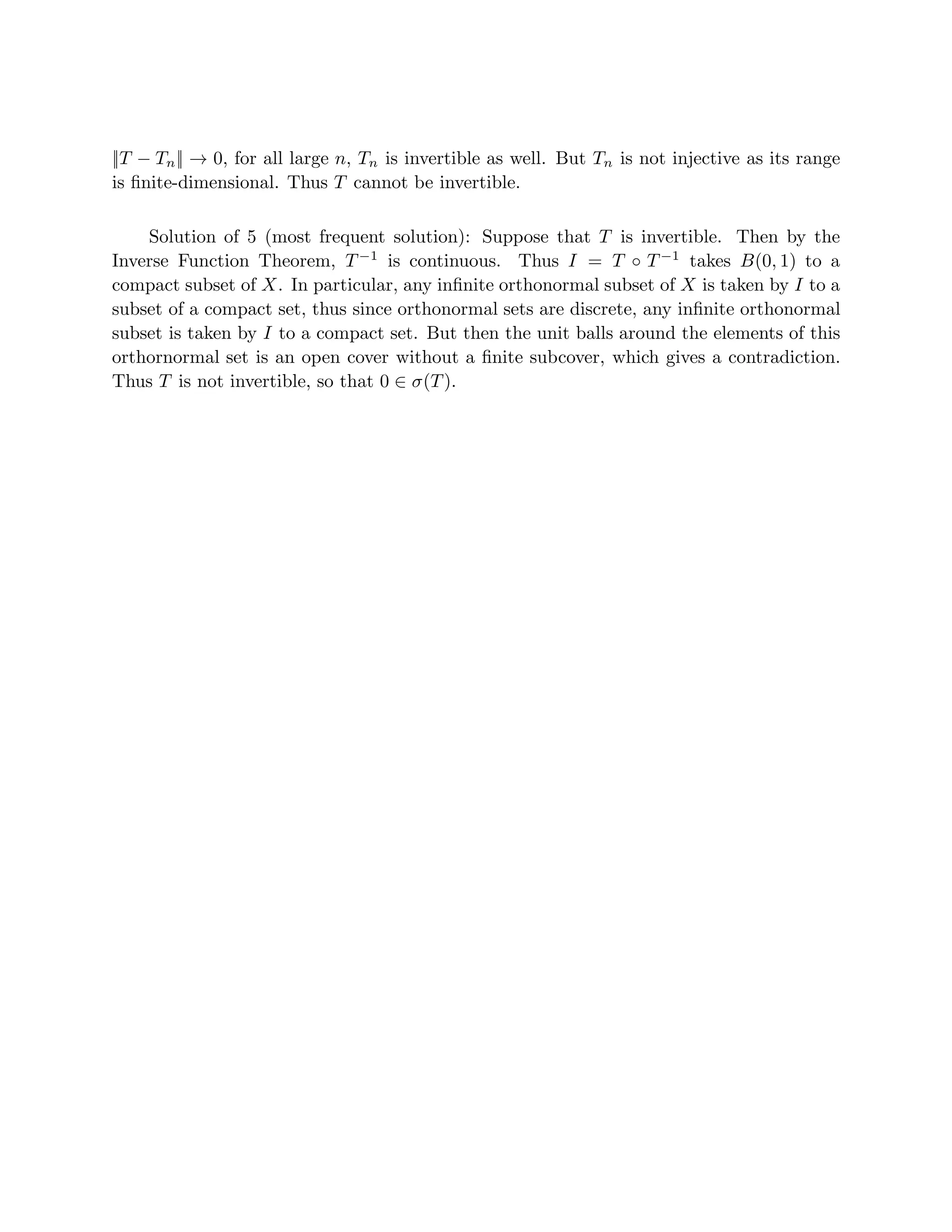This document provides an overview and definitions related to functional analysis and Banach spaces. It discusses:
1) The definition of a Banach space as a complete normed linear space where every Cauchy sequence converges.
2) Examples of Banach spaces including l^p spaces, C(X) for compact X, C_b(X) for any topological space X, and C^k([a,b]).
3) Measure spaces and the definition of measurable functions on a measure space. It notes the closure properties of measurable functions under scalar multiplication and (sometimes) addition.
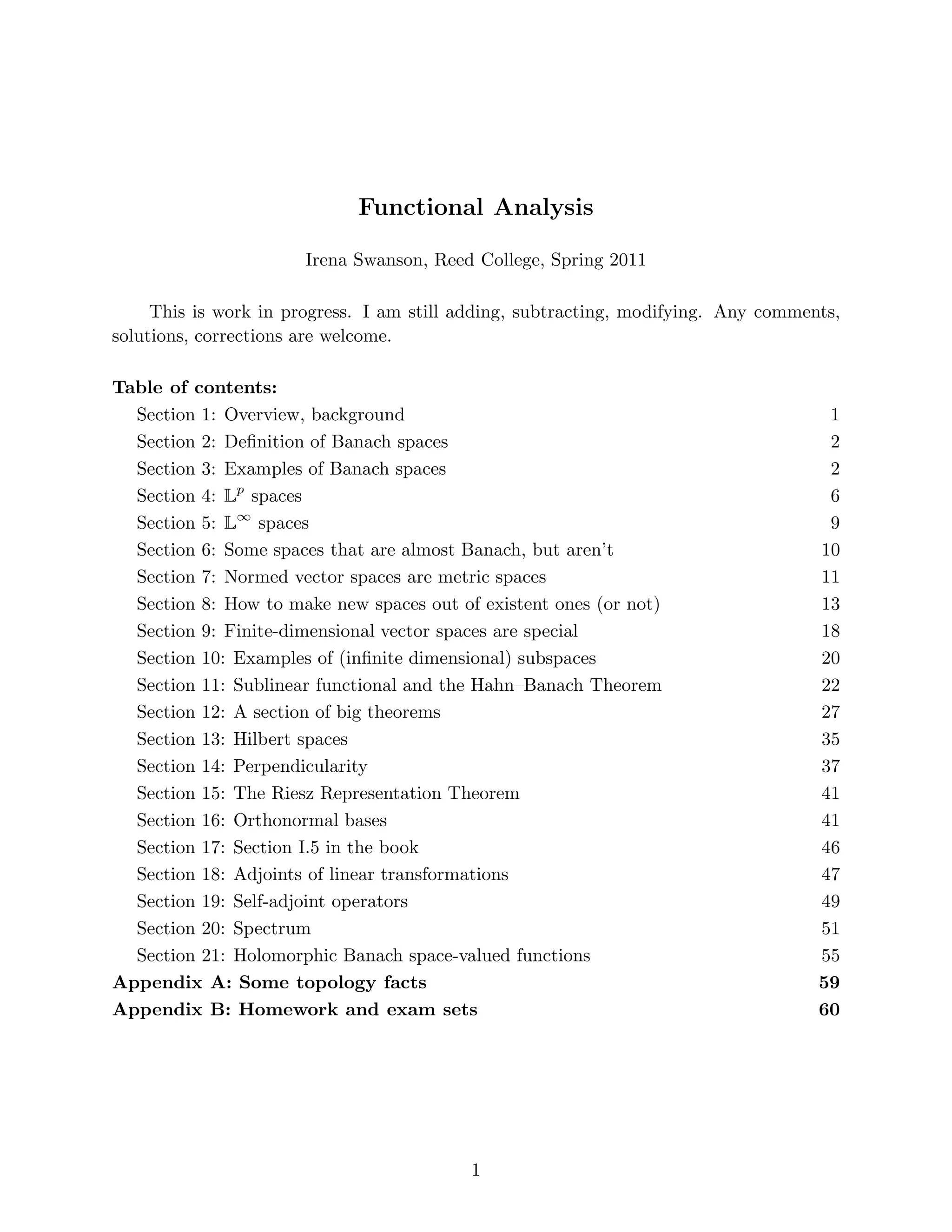
![1 Overview, background
Throughout, F will stand for either R or C. Thus F is a complete (normed) field.
[Conway’s book assumes that all topological spaces are Hausdorff. Let’s try to not
impose that unless needed.]
Much of the material and inspiration came from Larry Brown’s lectures on functional
analysis at Purdue University in the 1990s, and some came from my Reed thesis 1987.
Functional analysis is a wonderful blend of analysis and algebra, of finite-dimensional and
infinite-dimensional, so it is interesting, versatile, useful.
I will cover Banach spaces first, Hilbert spaces second, as Banach spaces are more
general.
2 Definition of Banach spaces
Definition 2.1 Let X be a vector space over F. A norm on X is a function || || : X →
[0, ∞) such that
(1) (Positive semidefiniteness) For all x ∈ X, ||x|| = 0 if and only if x = 0.
(2) ||rx|| = |r| ||x|| for all x ∈ X and all r ∈ F.
(3) (Triangle inequality) For all x, y ∈ X, ||x + y|| ≤ ||x|| + ||y||.
Is is easy to verify that for all x, y ∈ X, ||x − y|| ≤ ||x|| − ||y||, and that | ||x|| − ||y|| | ≤
||x ± y||.
Note that if X is a normed vector space, then X has a metric:
d(x, y) = ||x − y|| .
Definition 2.2 A vector space X with a norm || || is called a normed vector space or
a normed linear space. In a normed linear space, a sequence {fn} is Cauchy (in the
norm) if for all ǫ > 0 there exists N such that for all m, n ≥ N, ||fn − fm|| < ǫ. A sequence
{fn} converges (in the norm) to f if for all ǫ > 0 there exists N such that for all n ≥ N,
||fn − f|| < ǫ. A sequence {fn} in X is convergent (in the norm) if there exists f in X
such that {fn} converges in the norm to f. A Banach space is a normed linear space in
which every Cauchy sequence is convergent.
Silly/important fact of the day: On February 2, 2011, MathSciNet lists 20331 publications with
“Banach” in the title (and only 13539 publications with “Hilbert” in the title).
2](https://image.slidesharecdn.com/functionalanalysisejemplosinfinitos-210607191306/75/Functionalanalysis-ejemplos-infinitos-2-2048.jpg)

![Finally, we need to prove convergence in the norm. For all m ≥ N (with N as above),
||fm − f|| = sup{|fm(x) − f(x)| : x ∈ X}
= sup{|fm(x) − lim fn(x)| : x ∈ X}
≤ ǫ.
And we’re done, without needing to use the Hausdorff condition.
Definition 3.4 For any topological space X, define
Cb(X) = {f : X → F continuous and bounded}
with the metric ||f|| = sup{|f(x)| : x ∈ X}.
Proposition 3.5 For any topological space X, Cb(X) is a Banach space with the uniform
norm. [If X is compact, then Cb(X) is a subset of the already established Banach space
C(X).]
Proof. It is straightforward to see that Cb(X) is a normed linear space. If {fn} is a Cauchy
sequence in Cb(X), then there exists B such that for all n, ||fn|| ≤ B. Thus any pointwise
limit of {fn} is also bounded. The rest of this proof is just like for C(X).
Definition 3.6 Let X be a topological space. A function f : X → F is said to have
compact support if for all ǫ > 0, the set {x : |f(x)| ≥ ǫ} is compact. Define
C0(X) = {f : X → F continuous with compact support}.
Proposition 3.7 For any topological space X, C0(X) is a closed linear subspace of Cb(X),
and hence a Banach space (under the uniform norm).
Proof. We first show that C0(X) ⊆ Cb(X). Let f ∈ C0(x). For all n, define Sn{x ∈ X :
|f(x)| ≥ n}. By assumption, Sn is compact, and since f is continuous, Sn is closed. Since
f is F-valued, ∩Sn = ∅. Thus by HW 1.3, there exists n such that Sn = ∅, which means
that f is bounded.
Clearly C0(X) is closed under scalar multiplication. Now let f, g ∈ C0(X). Let ǫ > 0.
Then
{x : |f(x) + g(x)| ≥ ǫ} ⊆ {x : |f(x)| ≥ ǫ/2} ∪ {x : |g(x)| ≥ ǫ/2},
and since f + g is continuous, this says that {x : |f(x) + g(x)| ≥ ǫ} is a closed subset of
a compact set, whence compact itself by Proposition 1, which proves that C0(X) is closed
under addition. Since 0 ∈ C0(X), it follows that C0(X) is a vector subspace of Cb(X).
We next prove that C0(X) is a closed subset of Cb(X). If {fn} is a Cauchy sequence
in C0(X) in the norm, then {fn} is a Cauchy sequence in Cb(X) in the norm. Since Cb(X)
is Banach, there exists f ∈ Cb(X) such that fn → f in the norm. Let ǫ > 0. Then there
4](https://image.slidesharecdn.com/functionalanalysisejemplosinfinitos-210607191306/75/Functionalanalysis-ejemplos-infinitos-4-2048.jpg)
![exists N such that for all n ≥ N, ||fn − f|| < ǫ/2. If |f(x)| ≥ ǫ, then by the triangle
inequality,
ǫ ≤ |f(x)| ≤ |f(x) − fN (x)| + |fN (x)| ≤ ||f − fN || + |fN (x)| < ǫ/2 + |fN (x)|.
Thus |fN (x)| ≥ ǫ/2. Thus {x : |f(x)| ≥ ǫ} ⊆ {x : |fN (x)| ≥ ǫ/2}. Again by continuity of
f, {x : |f(x)| ≥ ǫ} is a closed subset of the compact set {x : |fN (x)| ≥ ǫ/2}, so that by
Proposition 1, {x : |f(x)| ≥ ǫ} is compact. Thus f ∈ C0(X), and we have convergence in
the norm: ||fn − f|| → 0 ∈ C0(X).
Finally, by Propositions 3.5 and 2, C0(X) is complete.
Proposition 3.8 Here are some special cases of Banach spaces Cb(X), C0(X), all with
the sup norm.
(1) Let X be an arbitrary set with discrete topology. Then any function X → F is
continuous. We write
ℓ∞
(X) = Cb(X) = {bounded functions X → F},
c0(X) = C0(X) = {functions X → F with compact support},
(2) If X = N, we also write
ℓ∞
= ℓ∞
(N) = Cb(N) = the set of all bounded F-valued sequences,
c0(N) = C0(N) = the set of all sequences in F with limit 0.
(3) Let X = {0} ∪ { 1
n : n ∈ N}, with the topology inherited from R. Then
c = Cb(X) = C(X) = the set of all convergent F-valued sequences,
c0 = C0(X) = the set of all convergent sequences in F with limit 0.
Definition 3.9 For a, b ∈ R, define
Ck
([a, b]) = the set of all functions [a, b] → F with k continuous derivatives.
Proposition 3.10 Ck
([a, b]) is a Banach space with the norm
Norm (f) =
k
X
i=0](https://image.slidesharecdn.com/functionalanalysisejemplosinfinitos-210607191306/75/Functionalanalysis-ejemplos-infinitos-5-2048.jpg)
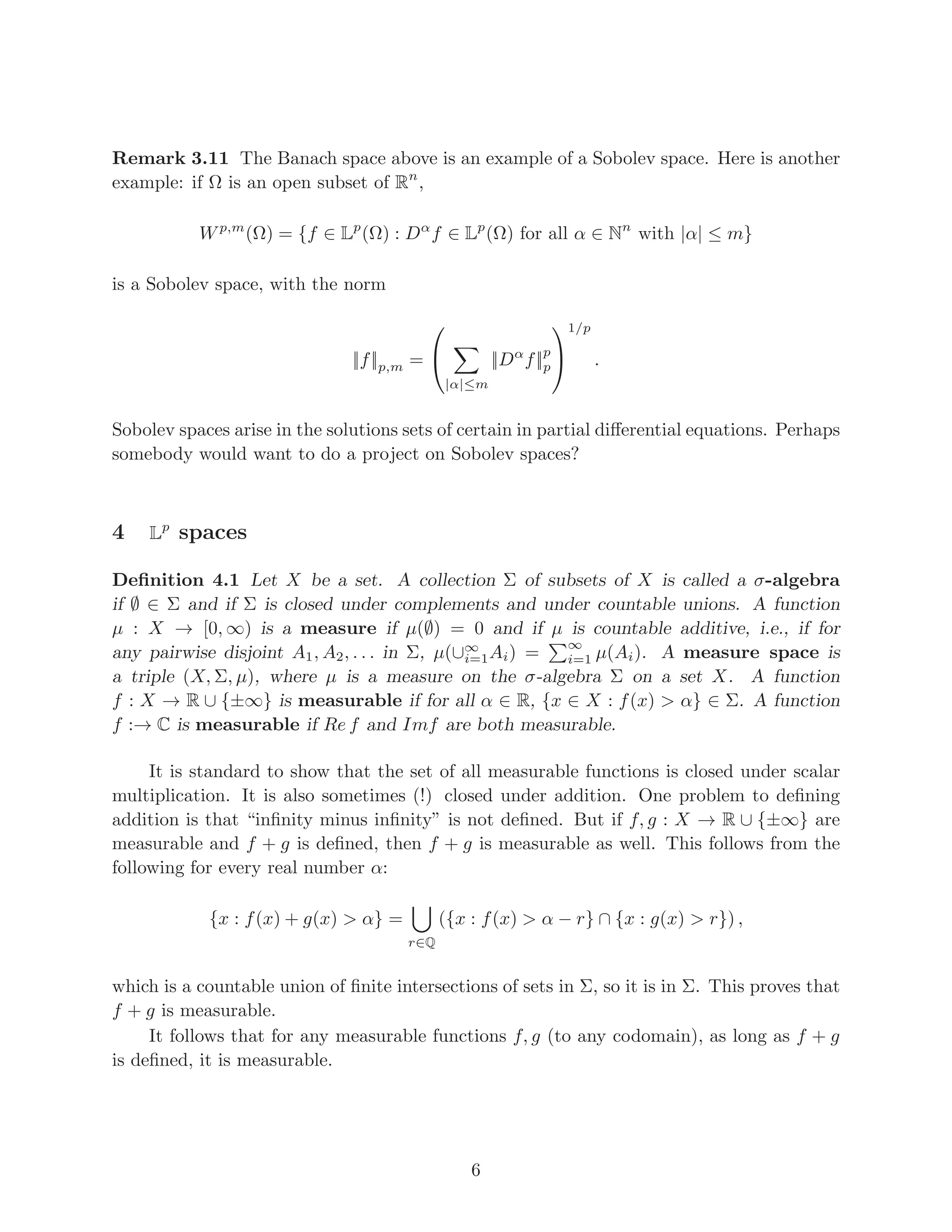
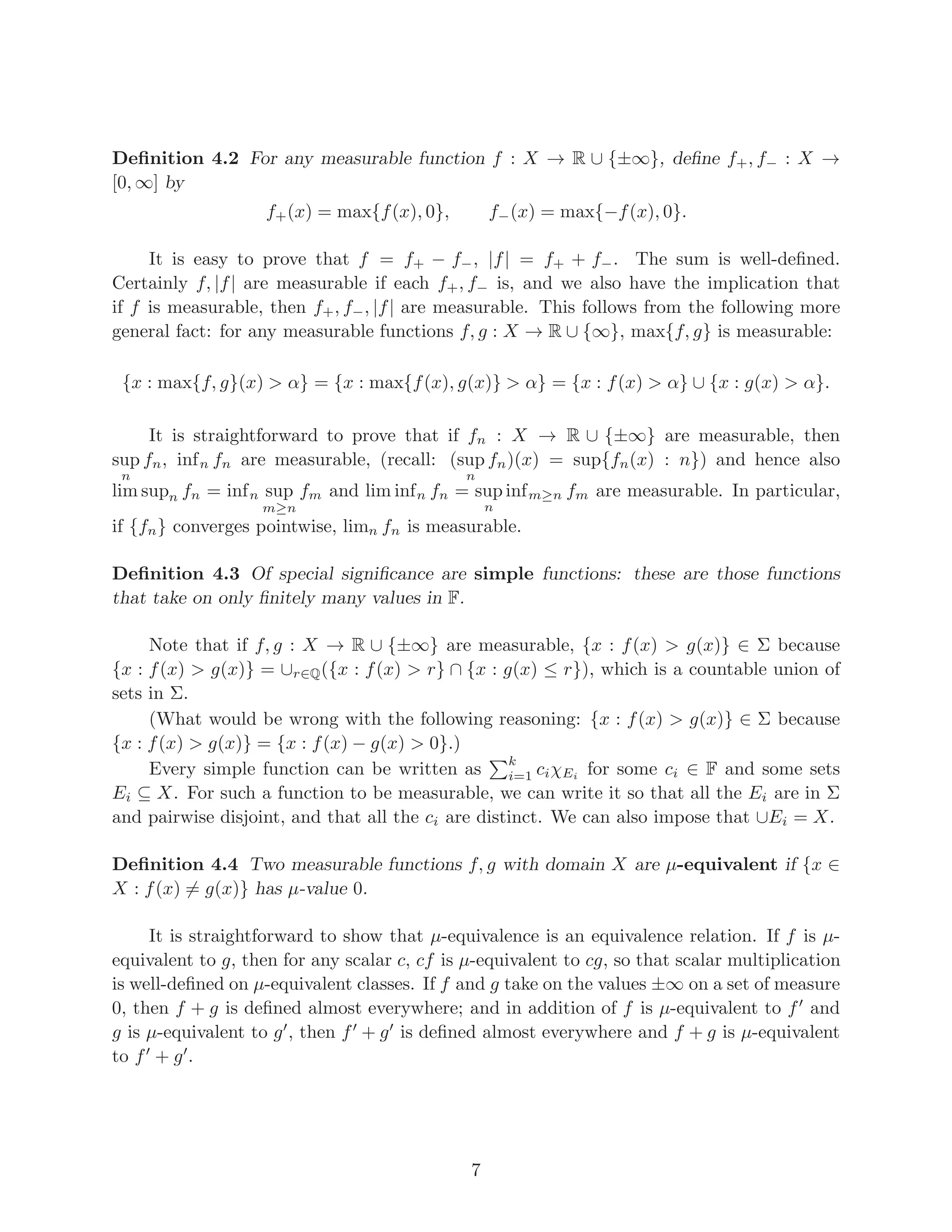
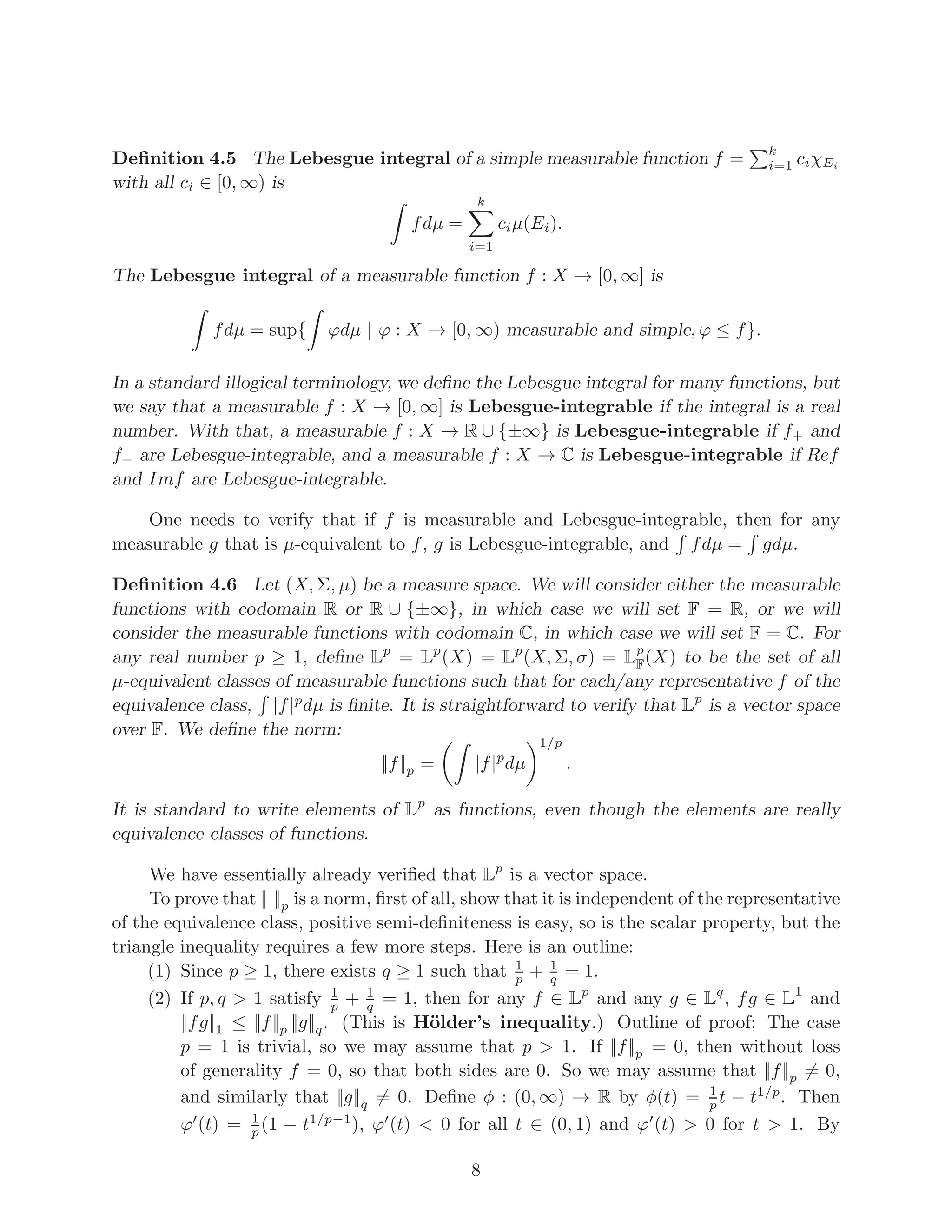
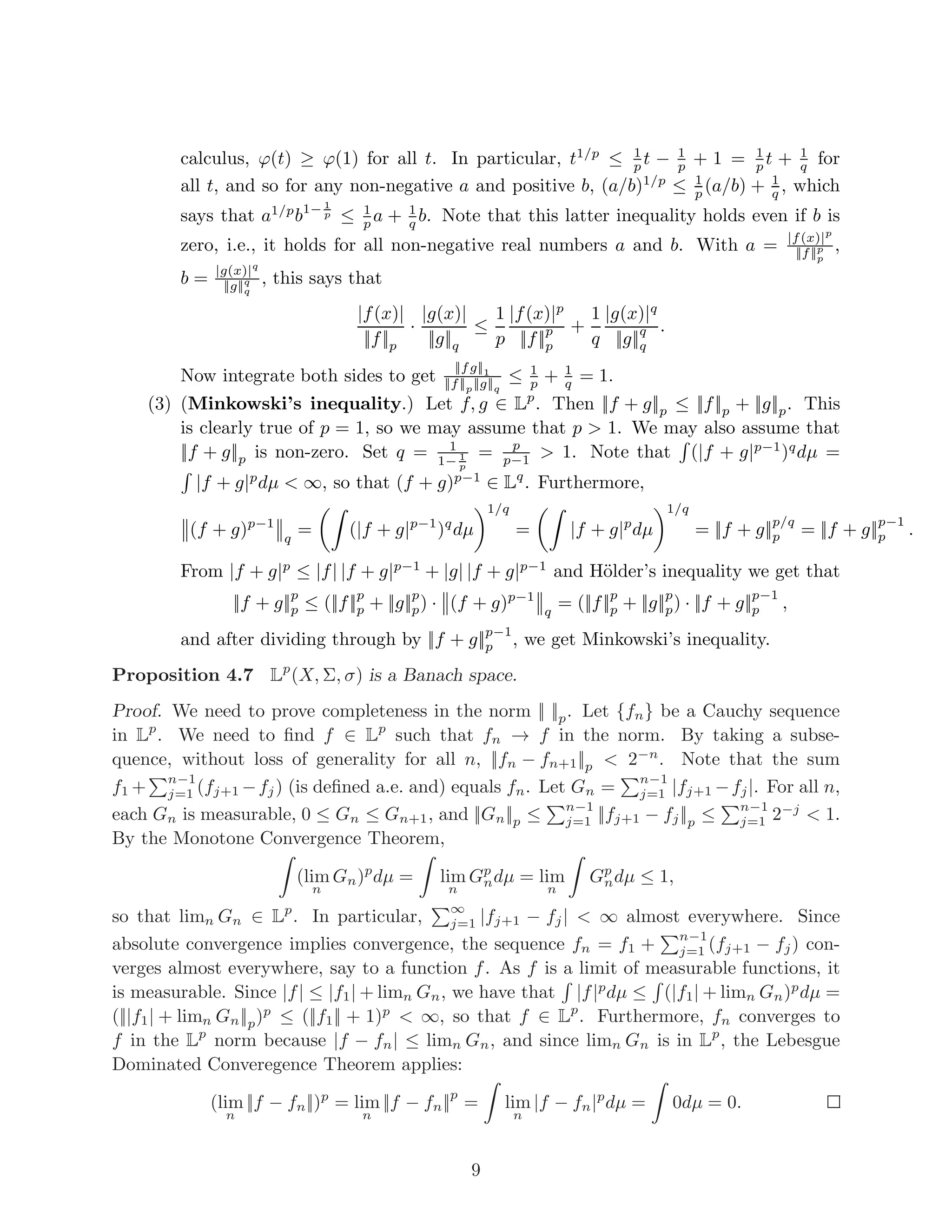

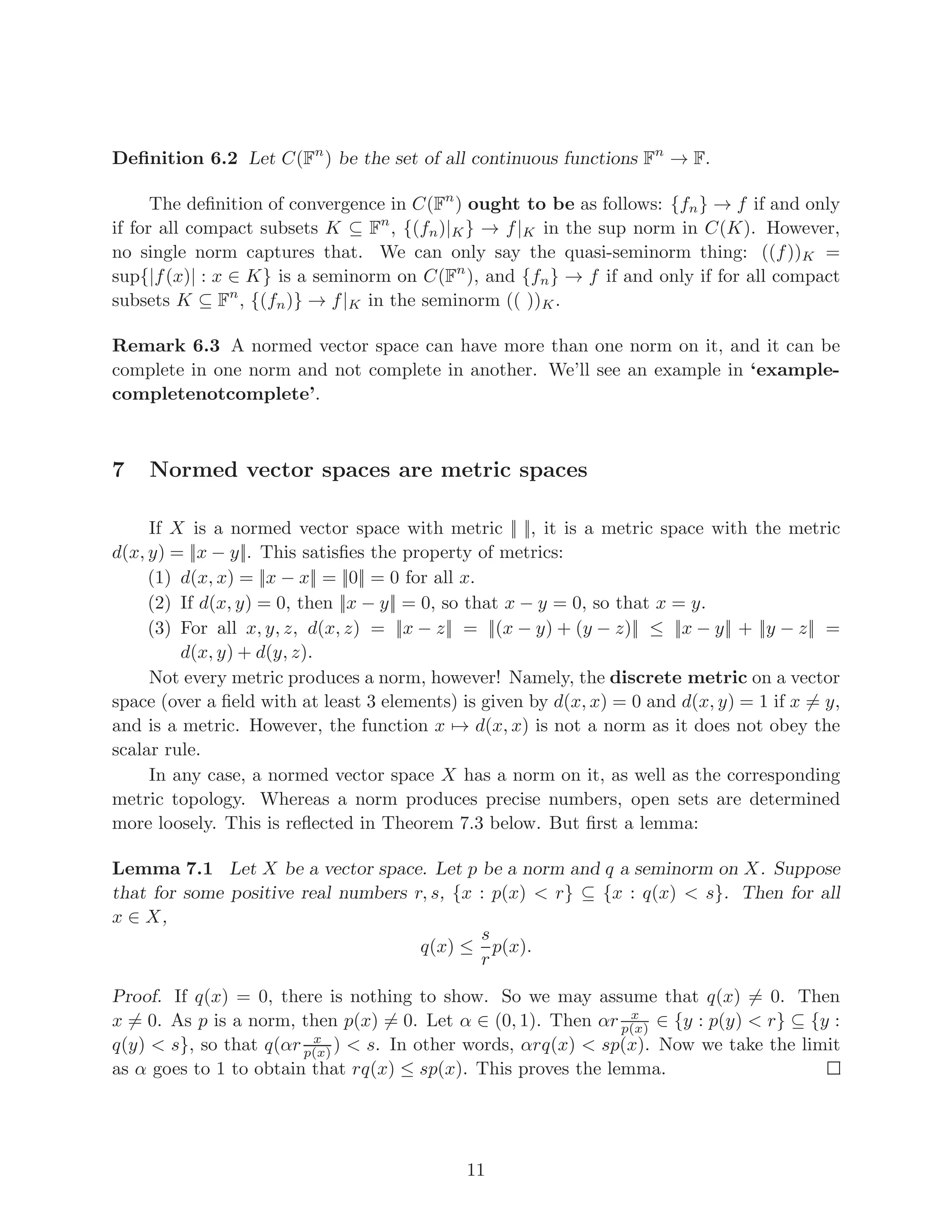
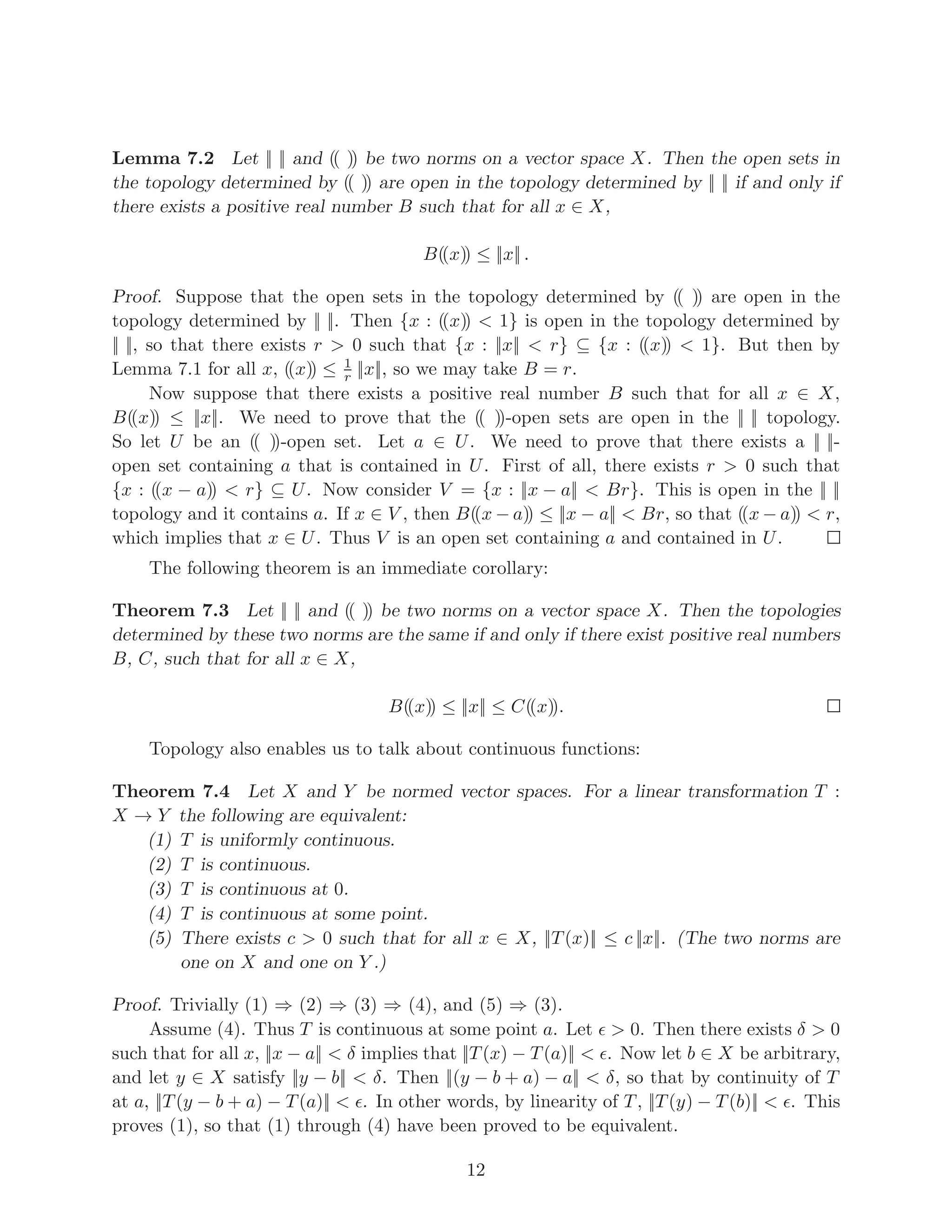

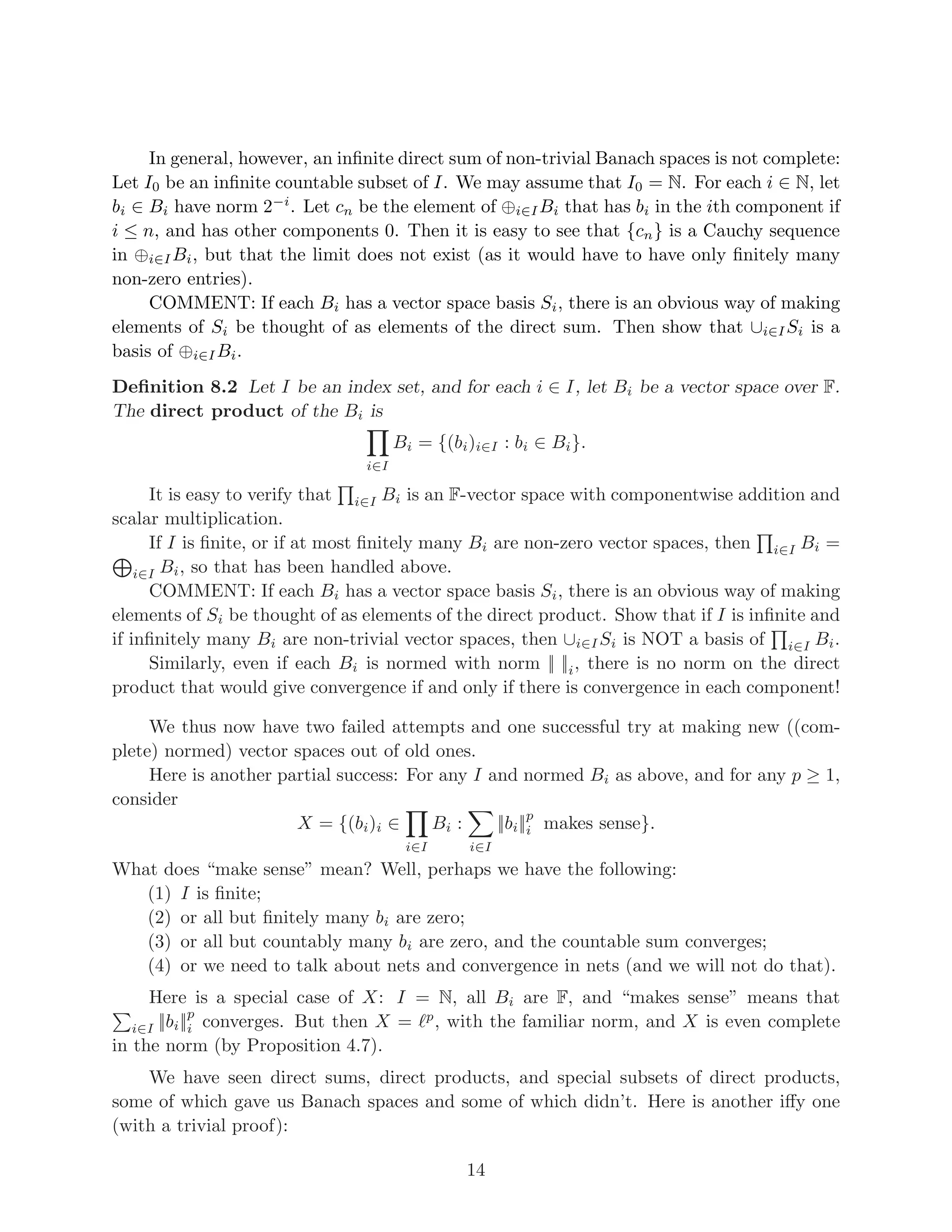
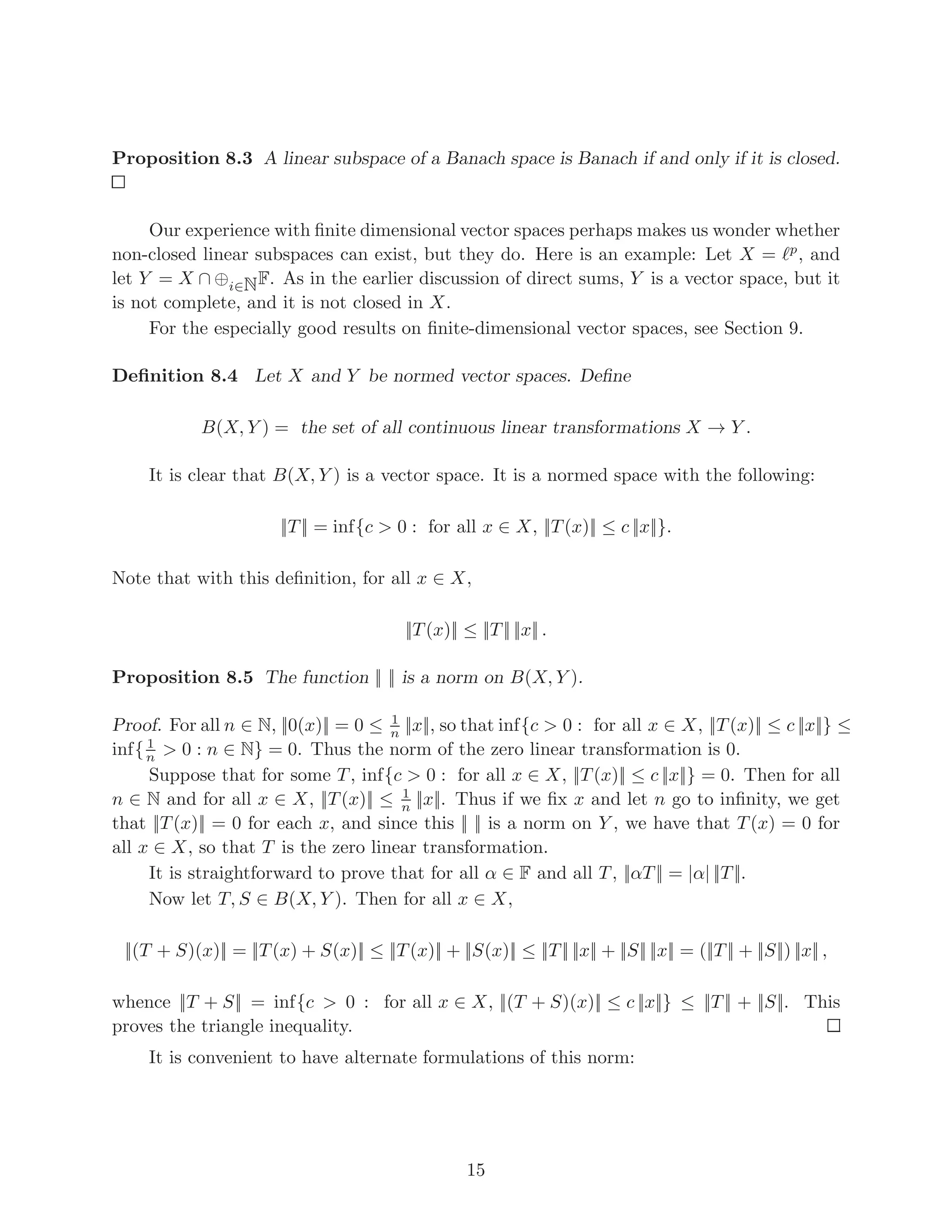
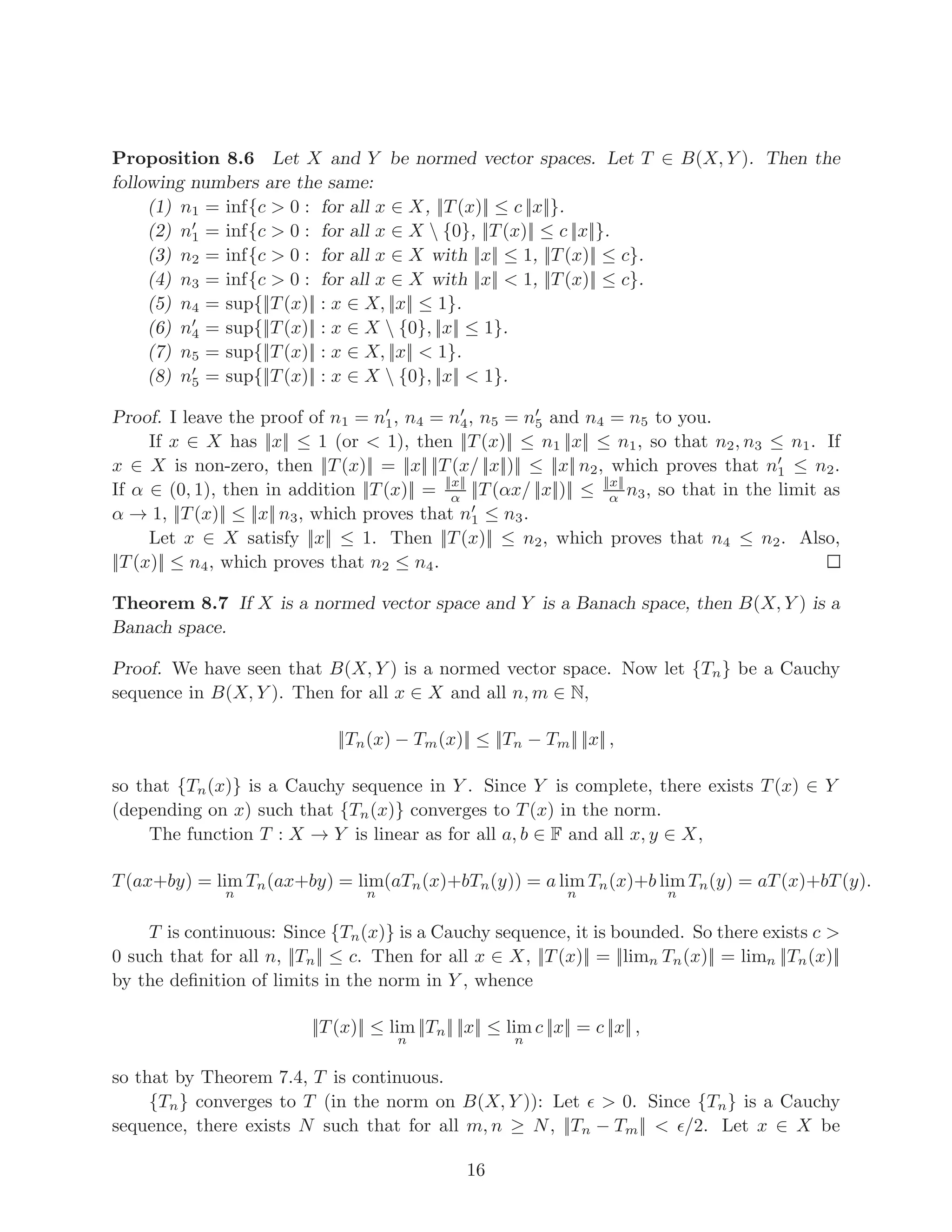
![,
where the norm of the derivatives is the sup norm.
Proof. It is straightforward to verify that Ck
([a, b]) is a vector space and that Norm is a
norm.
Let {fn} be a Cauchy sequence in the norm Norm. Then for each i = 0, . . ., k, {f
(i)
n }
is a Cauchy sequence in C([a, b]) in the sup norm. Thus by Proposition 3.3, for each
i = 0, . . ., k, there exists gi ∈ C([a, b]) such that {f
(i)
n converges to gi uniformly on [a, b].
By Homework 1.2, g0, g1, . . ., gk−1 are differentiable, and g′
i = gi+1. This proves that {fn}
converges to g0 in the norm Norm. This finishes the proof.
5](https://image.slidesharecdn.com/functionalanalysisejemplosinfinitos-210607191306/75/Functionalanalysis-ejemplos-infinitos-17-2048.jpg)
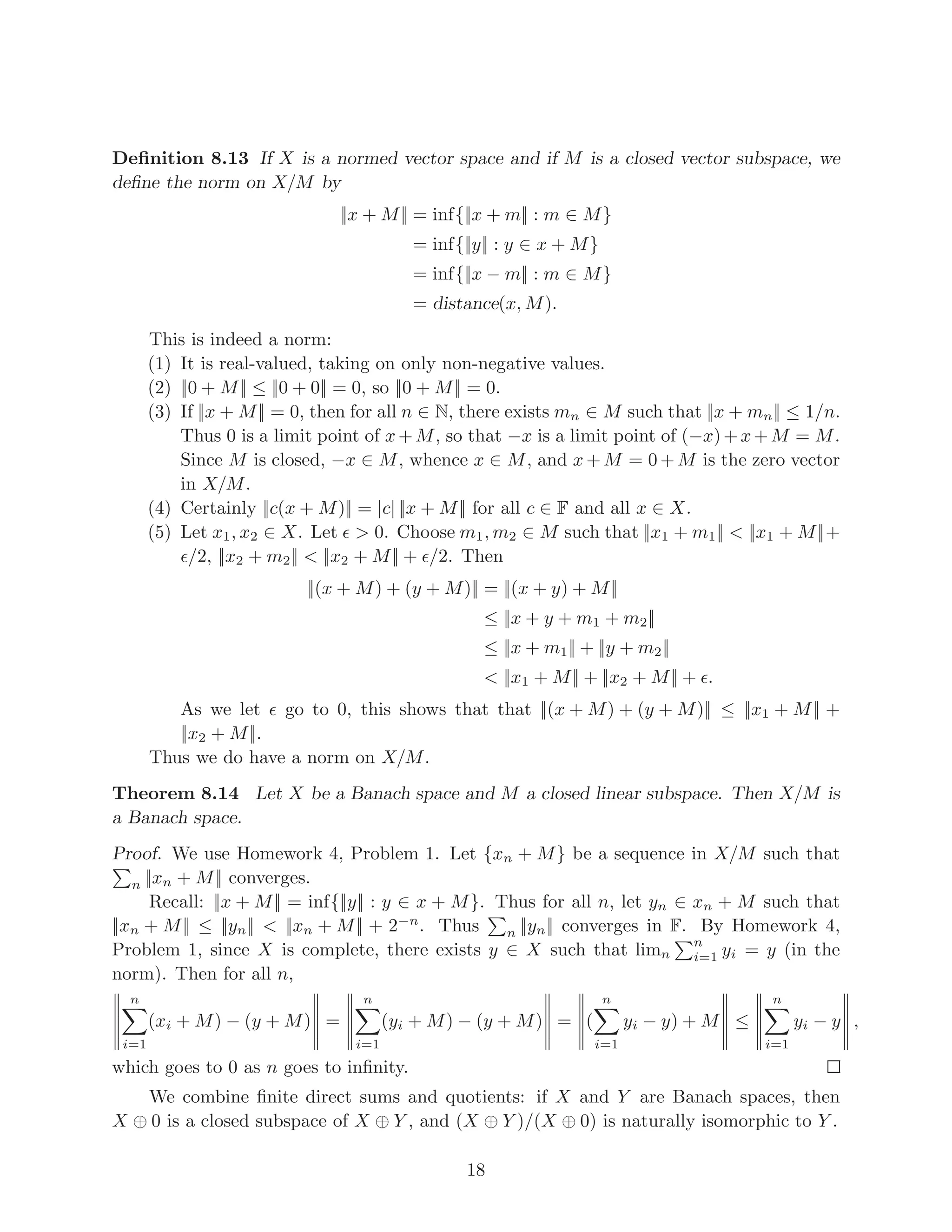
![Definition 4.2 For any measurable function f : X → R ∪ {±∞}, define f+, f− : X →
[0, ∞] by
f+(x) = max{f(x), 0}, f−(x) = max{−f(x), 0}.
It is easy to prove that f = f+ − f−, |f| = f+ + f−. The sum is well-defined.
Certainly f, |f| are measurable if each f+, f− is, and we also have the implication that
if f is measurable, then f+, f−, |f| are measurable. This follows from the following more
general fact: for any measurable functions f, g : X → R ∪ {∞}, max{f, g} is measurable:
{x : max{f, g}(x) > α} = {x : max{f(x), g(x)} > α} = {x : f(x) > α} ∪ {x : g(x) > α}.
It is straightforward to prove that if fn : X → R ∪ {±∞} are measurable, then
sup
n
fn, infn fn are measurable, (recall: (sup
n
fn)(x) = sup{fn(x) : n}) and hence also
lim supn fn = infn sup
m≥n
fm and lim infn fn = sup
n
infm≥n fm are measurable. In particular,
if {fn} converges pointwise, limn fn is measurable.
Definition 4.3 Of special significance are simple functions: these are those functions
that take on only finitely many values in F.
Note that if f, g : X → R ∪ {±∞} are measurable, {x : f(x) > g(x)} ∈ Σ because
{x : f(x) > g(x)} = ∪r∈Q({x : f(x) > r} ∩ {x : g(x) ≤ r}), which is a countable union of
sets in Σ.
(What would be wrong with the following reasoning: {x : f(x) > g(x)} ∈ Σ because
{x : f(x) > g(x)} = {x : f(x) − g(x) > 0}.)
Every simple function can be written as
Pk
i=1 ciχEi
for some ci ∈ F and some sets
Ei ⊆ X. For such a function to be measurable, we can write it so that all the Ei are in Σ
and pairwise disjoint, and that all the ci are distinct. We can also impose that ∪Ei = X.
Definition 4.4 Two measurable functions f, g with domain X are µ-equivalent if {x ∈
X : f(x) 6= g(x)} has µ-value 0.
It is straightforward to show that µ-equivalence is an equivalence relation. If f is µ-
equivalent to g, then for any scalar c, cf is µ-equivalent to cg, so that scalar multiplication
is well-defined on µ-equivalent classes. If f and g take on the values ±∞ on a set of measure
0, then f + g is defined almost everywhere; and in addition of f is µ-equivalent to f′
and
g is µ-equivalent to g′
, then f′
+ g′
is defined almost everywhere and f + g is µ-equivalent
to f′
+ g′
.
7](https://image.slidesharecdn.com/functionalanalysisejemplosinfinitos-210607191306/75/Functionalanalysis-ejemplos-infinitos-19-2048.jpg)
![Definition 4.5 The Lebesgue integral of a simple measurable function f =
Pk
i=1 ciχEi
with all ci ∈ [0, ∞) is
Z
fdµ =
k
X
i=1
ciµ(Ei).
The Lebesgue integral of a measurable function f : X → [0, ∞] is
Z
fdµ = sup{
Z
ϕdµ | ϕ : X → [0, ∞) measurable and simple, ϕ ≤ f}.
In a standard illogical terminology, we define the Lebesgue integral for many functions, but
we say that a measurable f : X → [0, ∞] is Lebesgue-integrable if the integral is a real
number. With that, a measurable f : X → R ∪ {±∞} is Lebesgue-integrable if f+ and
f− are Lebesgue-integrable, and a measurable f : X → C is Lebesgue-integrable if Ref
and Imf are Lebesgue-integrable.
One needs to verify that if f is measurable and Lebesgue-integrable, then for any
measurable g that is µ-equivalent to f, g is Lebesgue-integrable, and
R
fdµ =
R
gdµ.
Definition 4.6 Let (X, Σ, µ) be a measure space. We will consider either the measurable
functions with codomain R or R ∪ {±∞}, in which case we will set F = R, or we will
consider the measurable functions with codomain C, in which case we will set F = C. For
any real number p ≥ 1, define Lp
= Lp
(X) = Lp
(X, Σ, σ) = Lp
F(X) to be the set of all
µ-equivalent classes of measurable functions such that for each/any representative f of the
equivalence class,
R
|f|p
dµ is finite. It is straightforward to verify that Lp
is a vector space
over F. We define the norm:
||f||p =
Z
|f|p
dµ
1/p
.
It is standard to write elements of Lp
as functions, even though the elements are really
equivalence classes of functions.
We have essentially already verified that Lp
is a vector space.
To prove that || ||p is a norm, first of all, show that it is independent of the representative
of the equivalence class, positive semi-definiteness is easy, so is the scalar property, but the
triangle inequality requires a few more steps. Here is an outline:
(1) Since p ≥ 1, there exists q ≥ 1 such that 1
p + 1
q = 1.
(2) If p, q 1 satisfy 1
p + 1
q = 1, then for any f ∈ Lp
and any g ∈ Lq
, fg ∈ L1
and
||fg||1 ≤ ||f||p ||g||q. (This is Hölder’s inequality.) Outline of proof: The case
p = 1 is trivial, so we may assume that p 1. If ||f||p = 0, then without loss
of generality f = 0, so that both sides are 0. So we may assume that ||f||p 6= 0,
and similarly that ||g||q 6= 0. Define φ : (0, ∞) → R by φ(t) = 1
p t − t1/p
. Then
ϕ′
(t) = 1
p (1 − t1/p−1
), ϕ′
(t) 0 for all t ∈ (0, 1) and ϕ′
(t) 0 for t 1. By
8](https://image.slidesharecdn.com/functionalanalysisejemplosinfinitos-210607191306/75/Functionalanalysis-ejemplos-infinitos-20-2048.jpg)

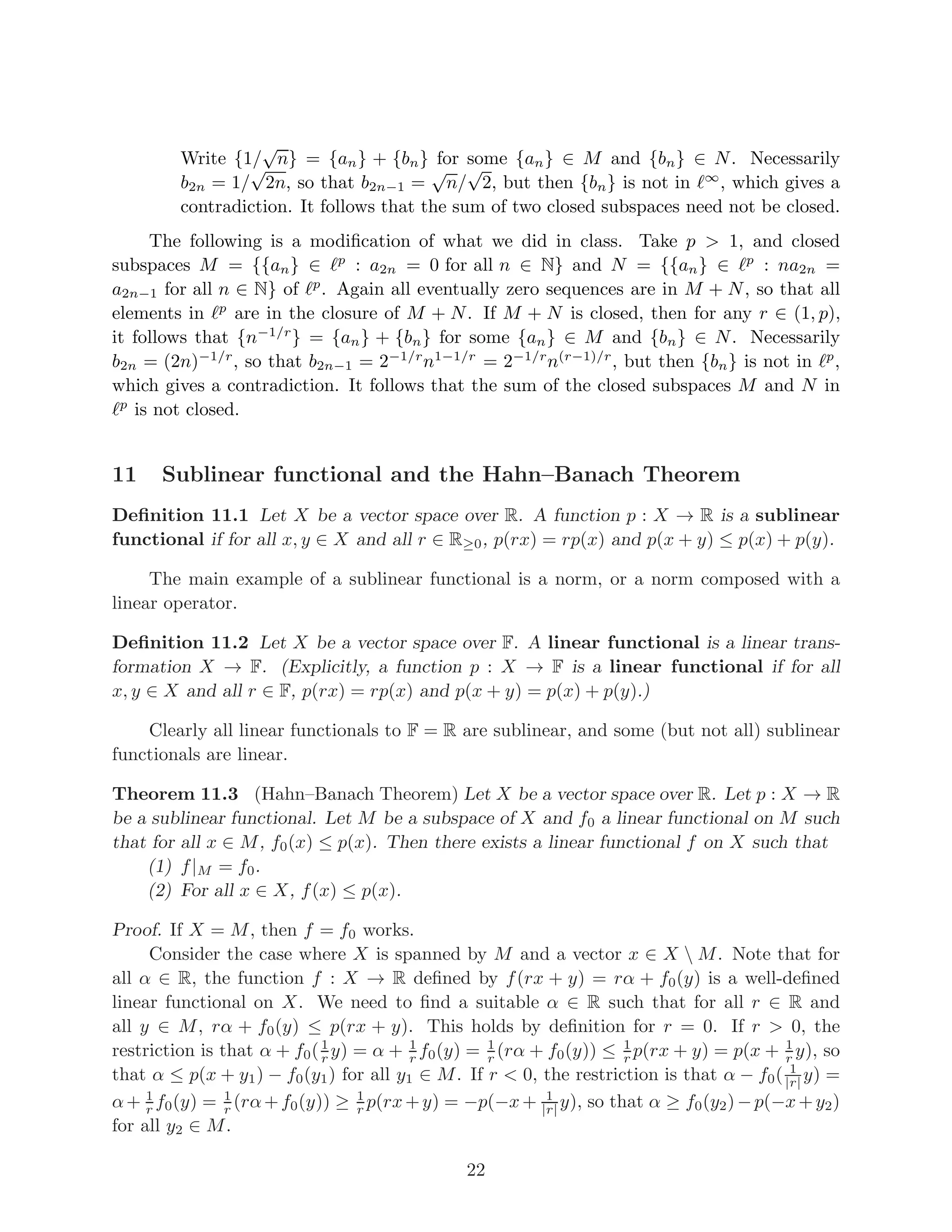

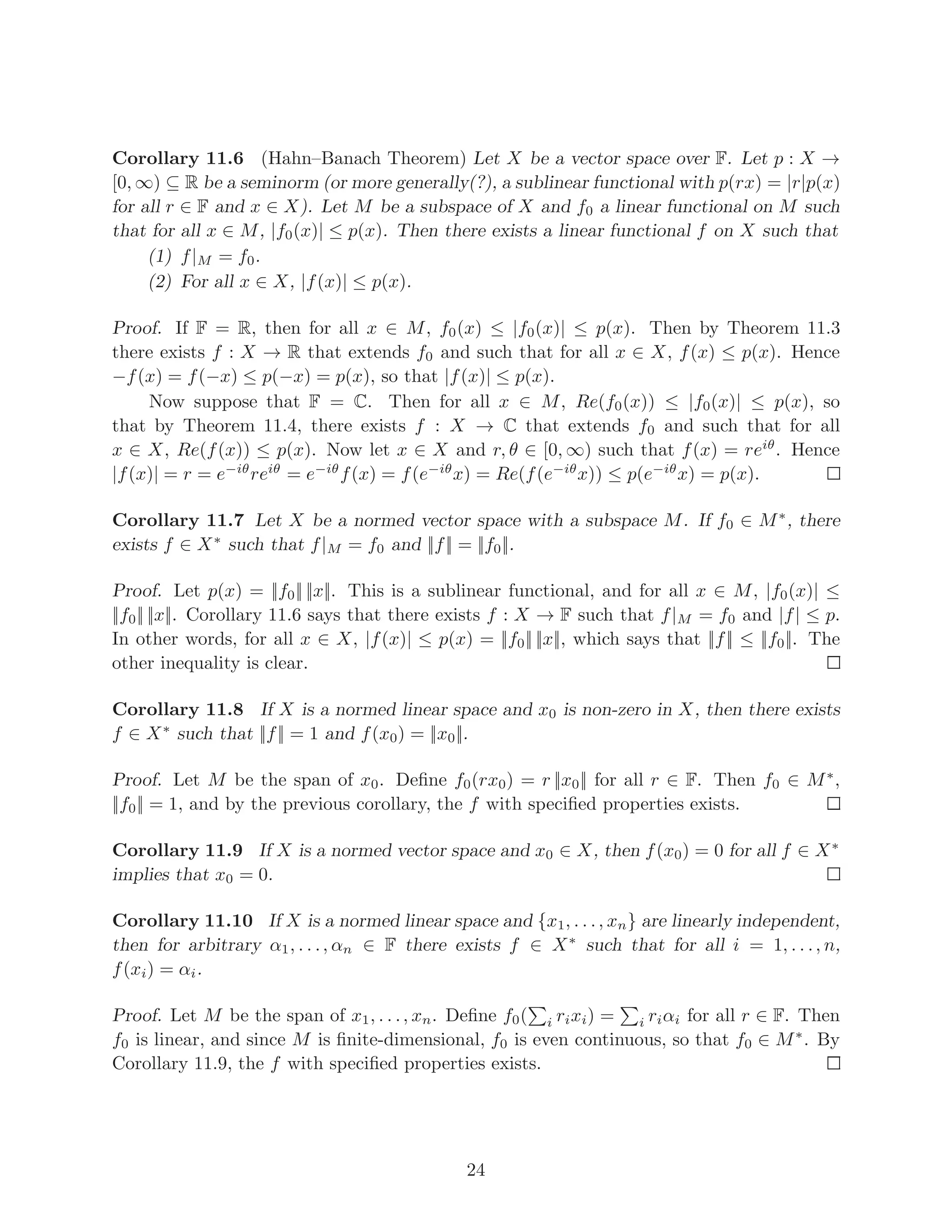
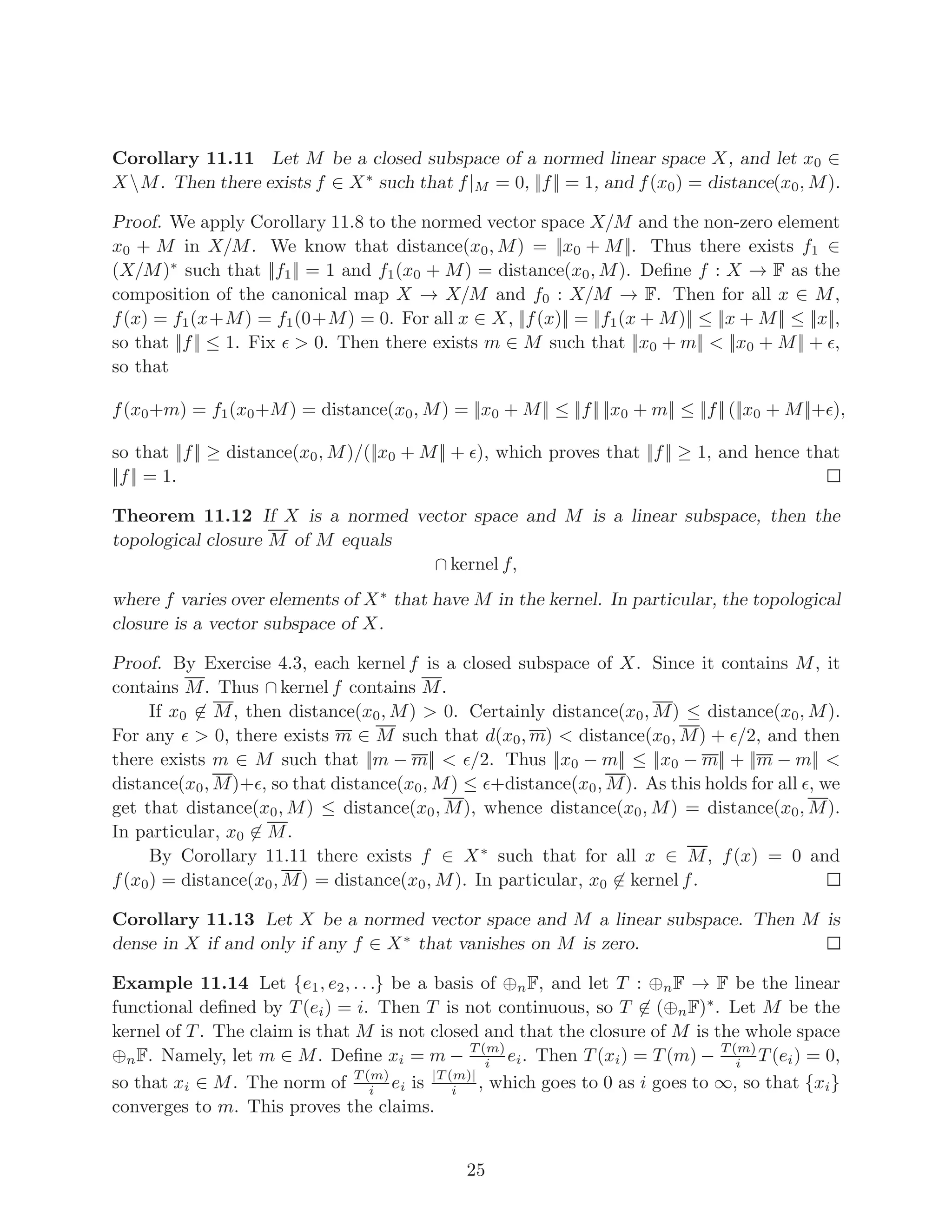
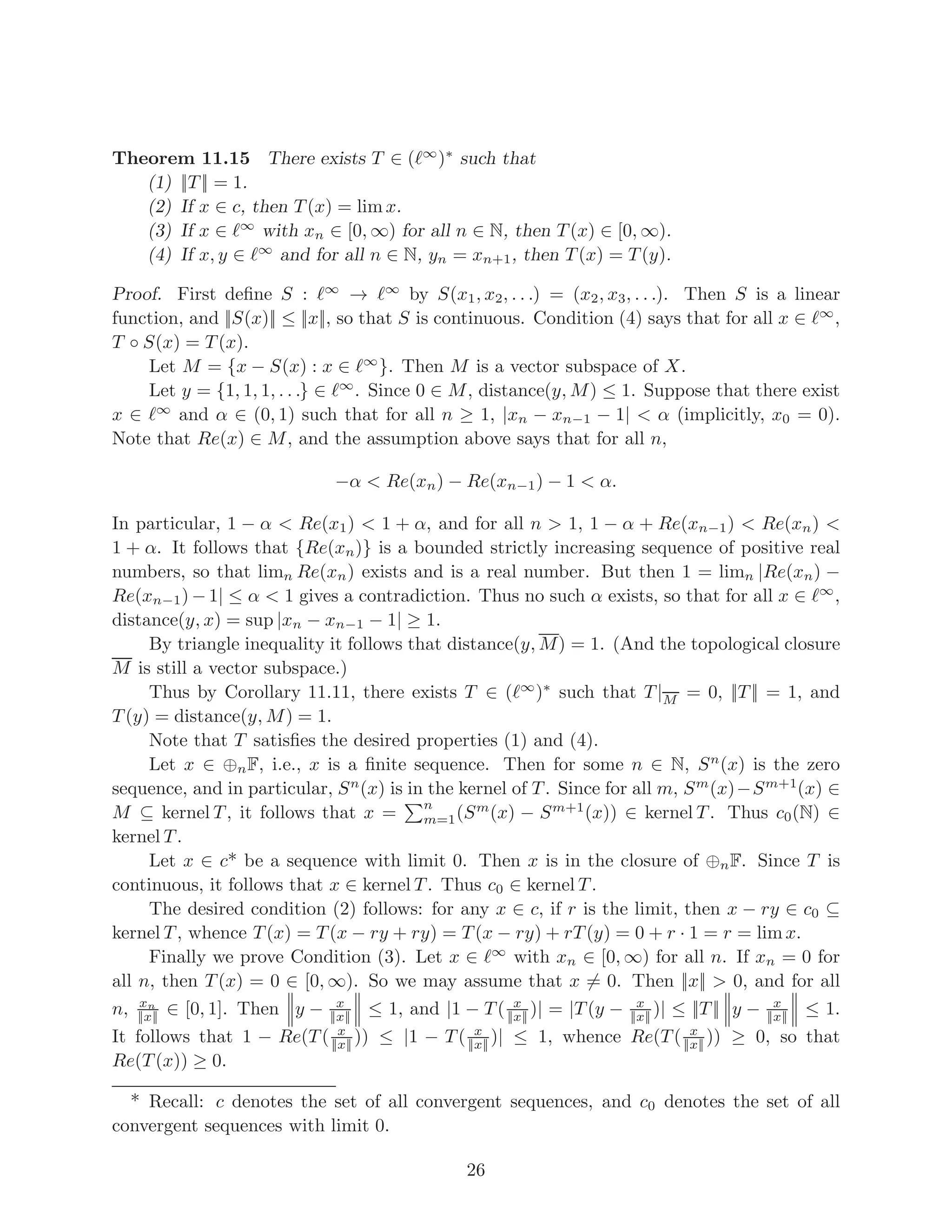
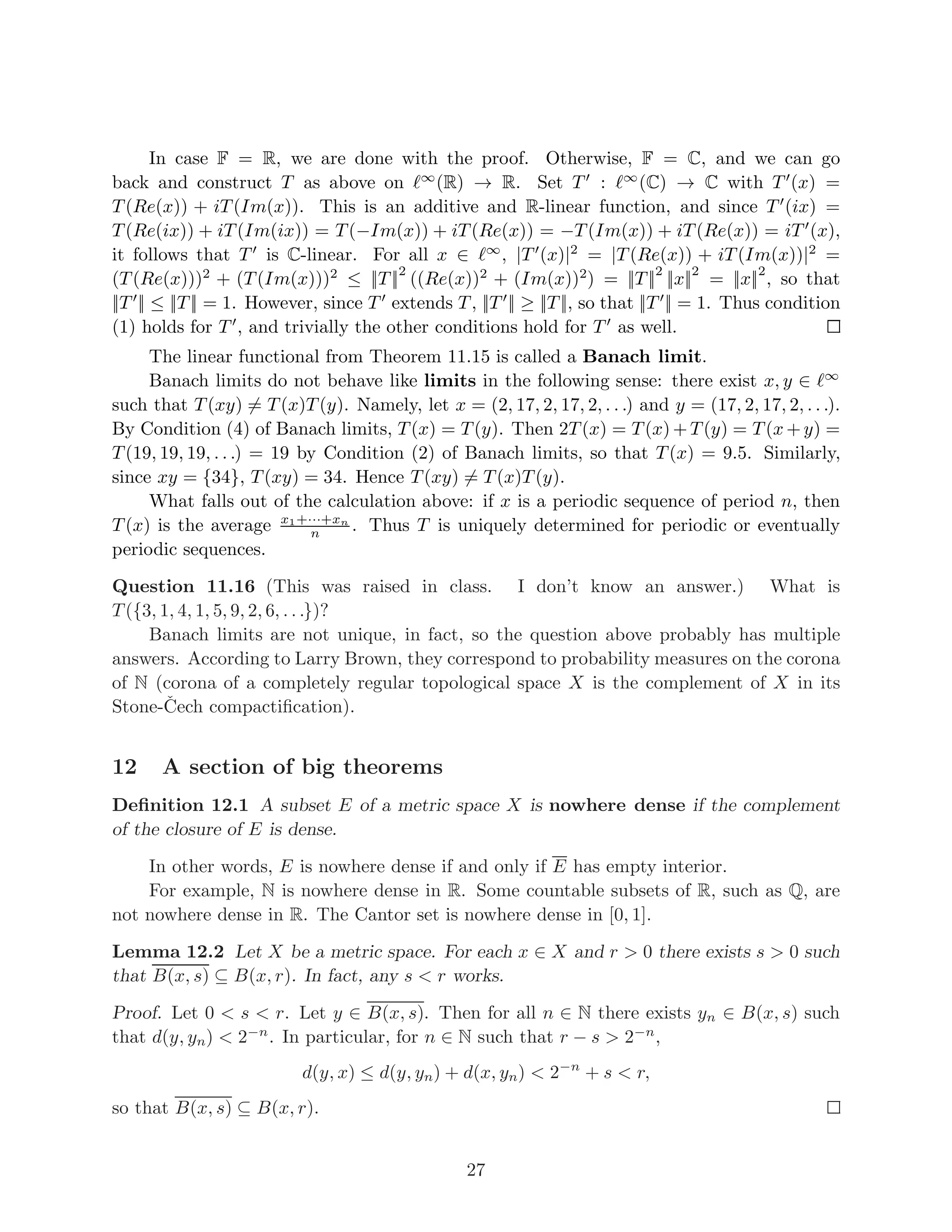
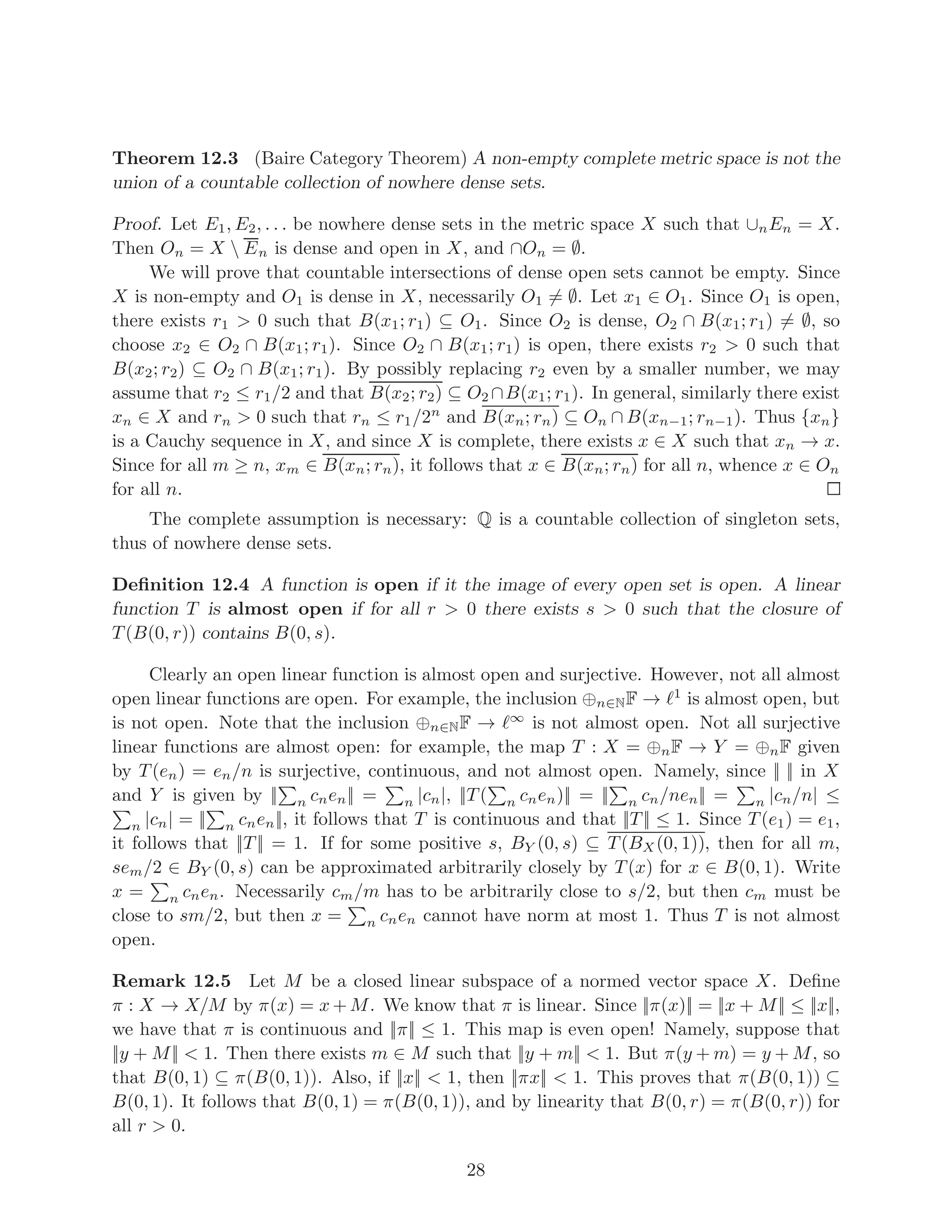
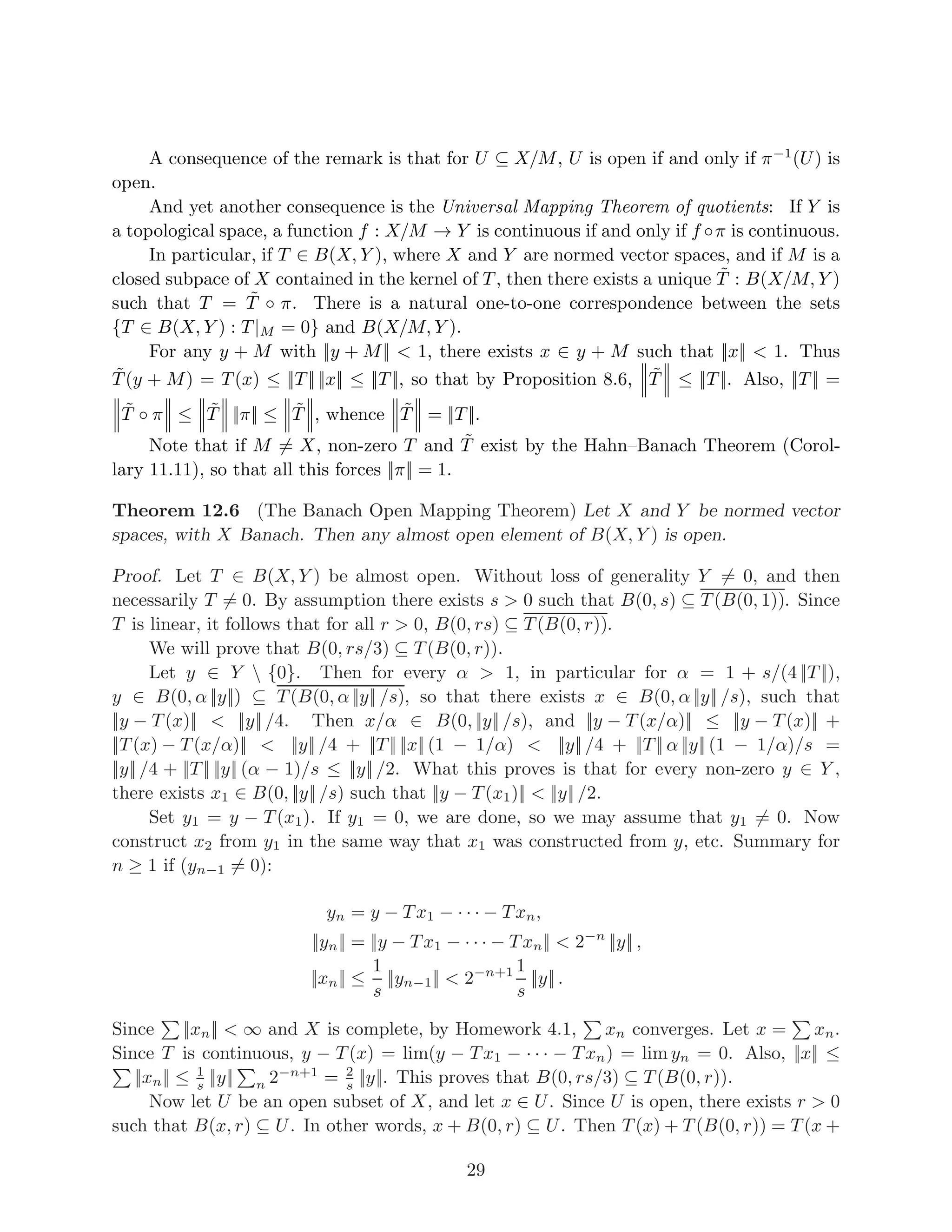
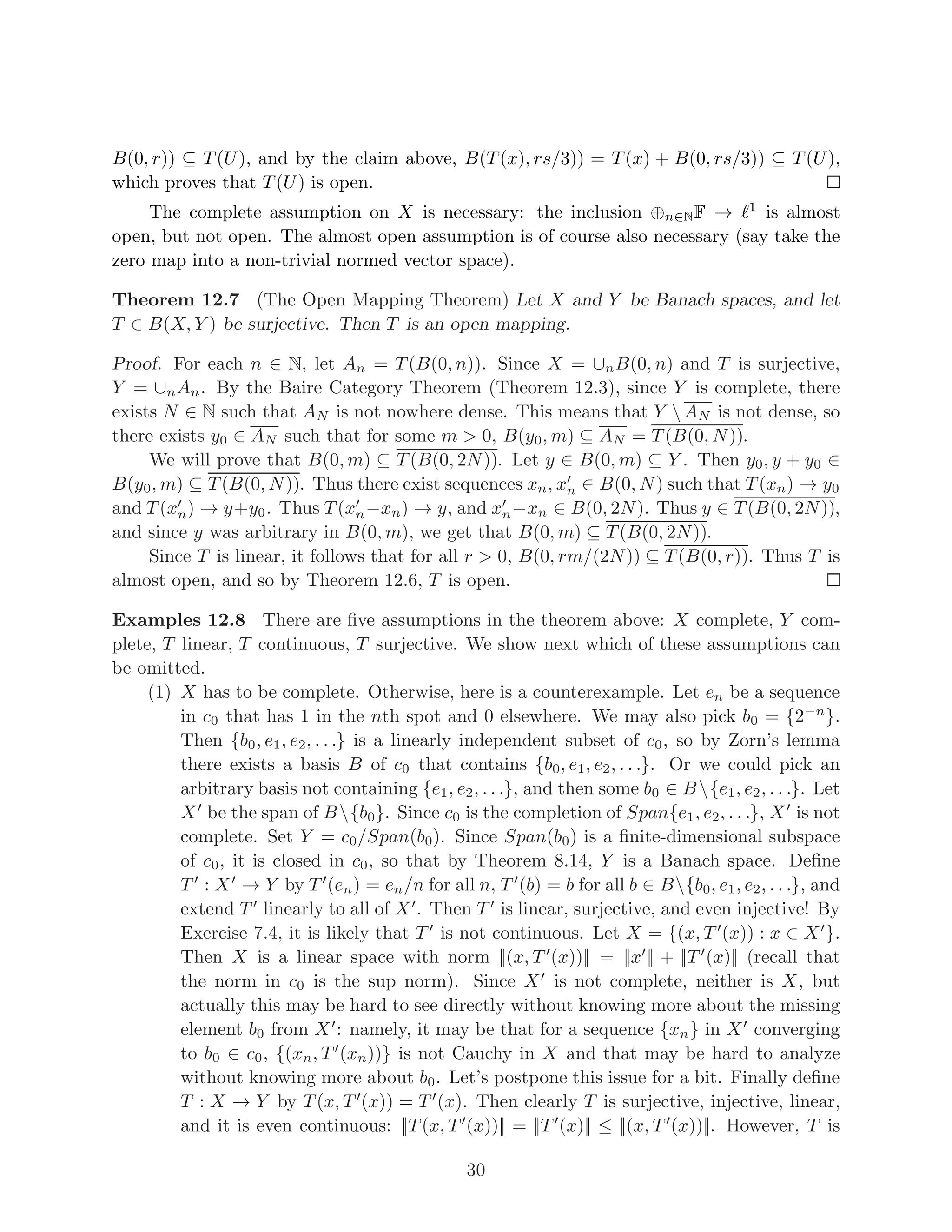
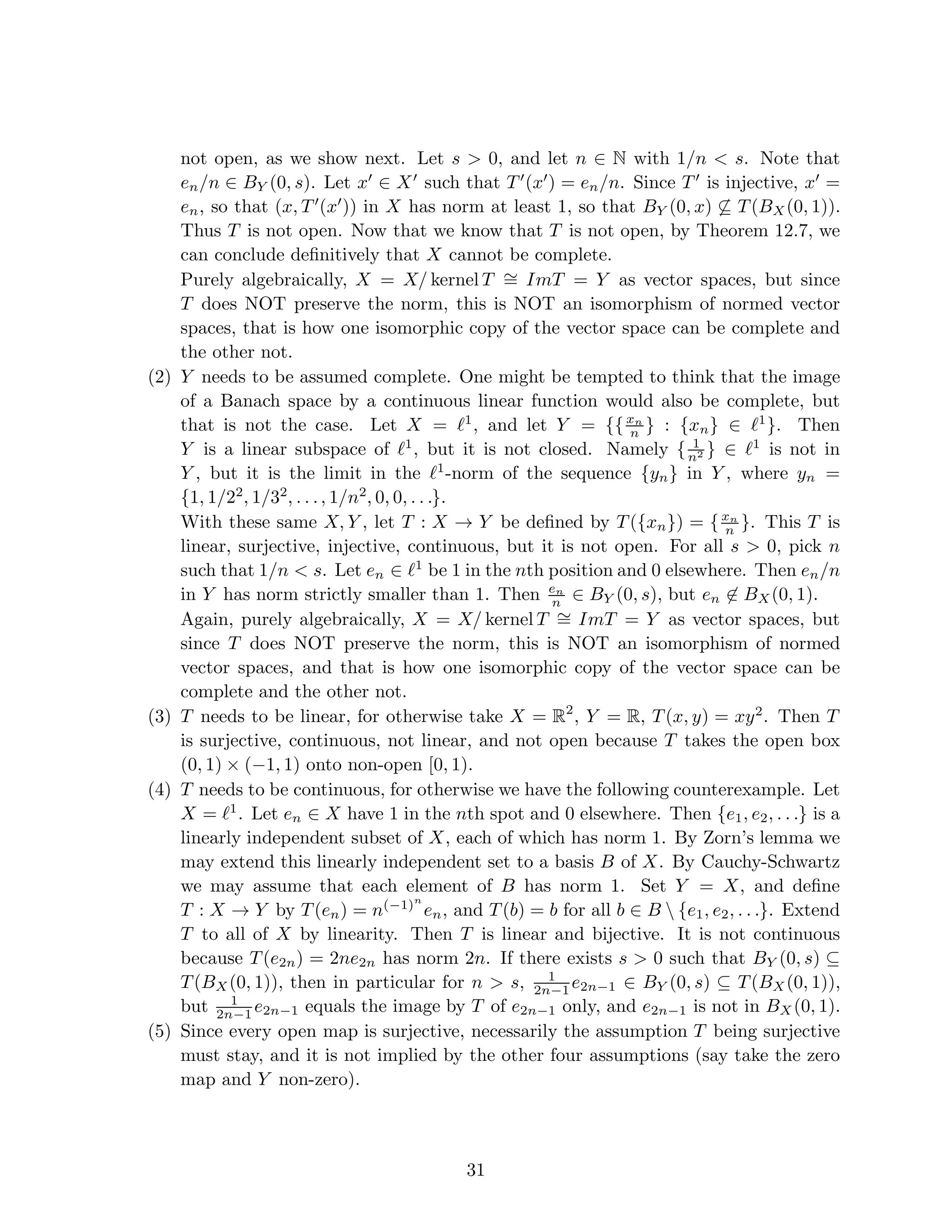
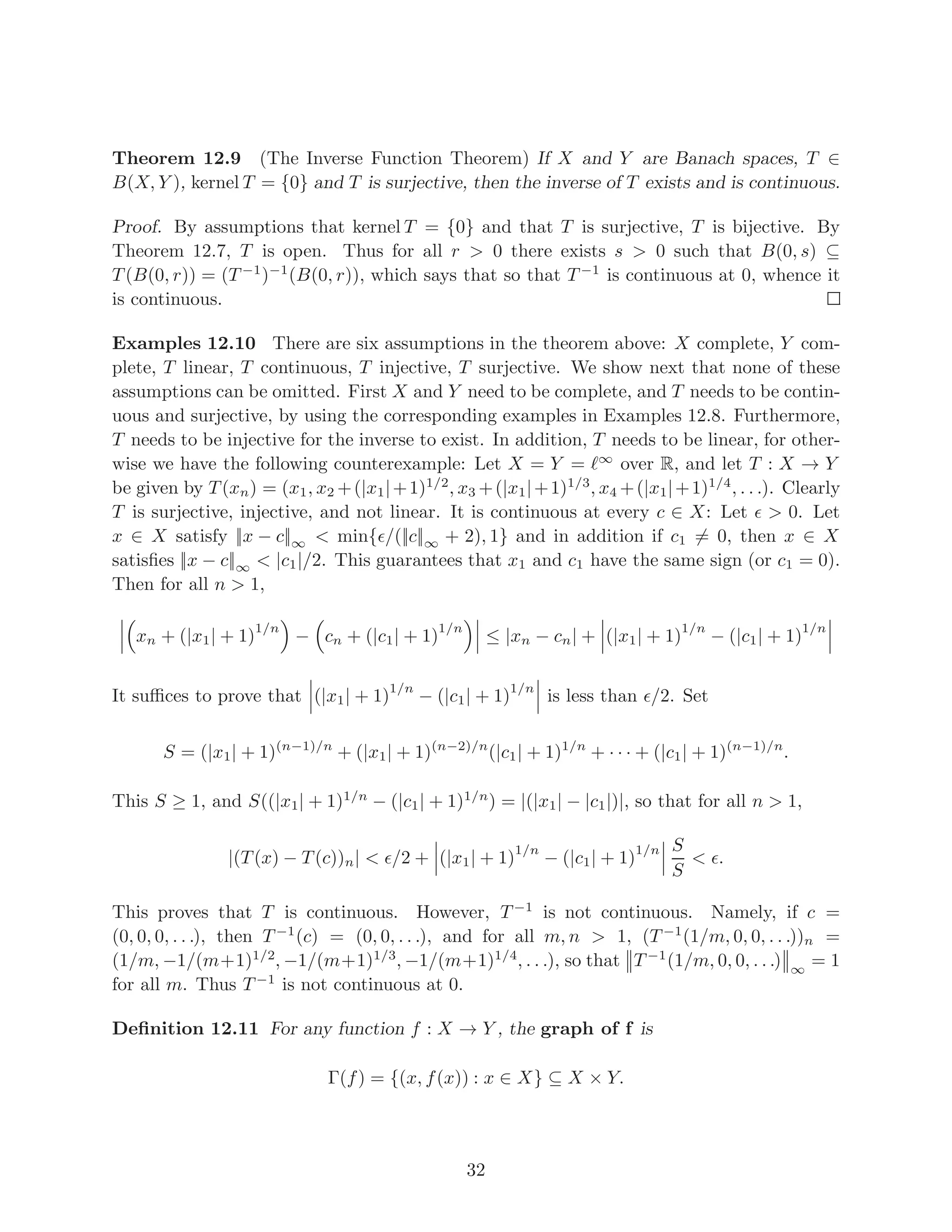
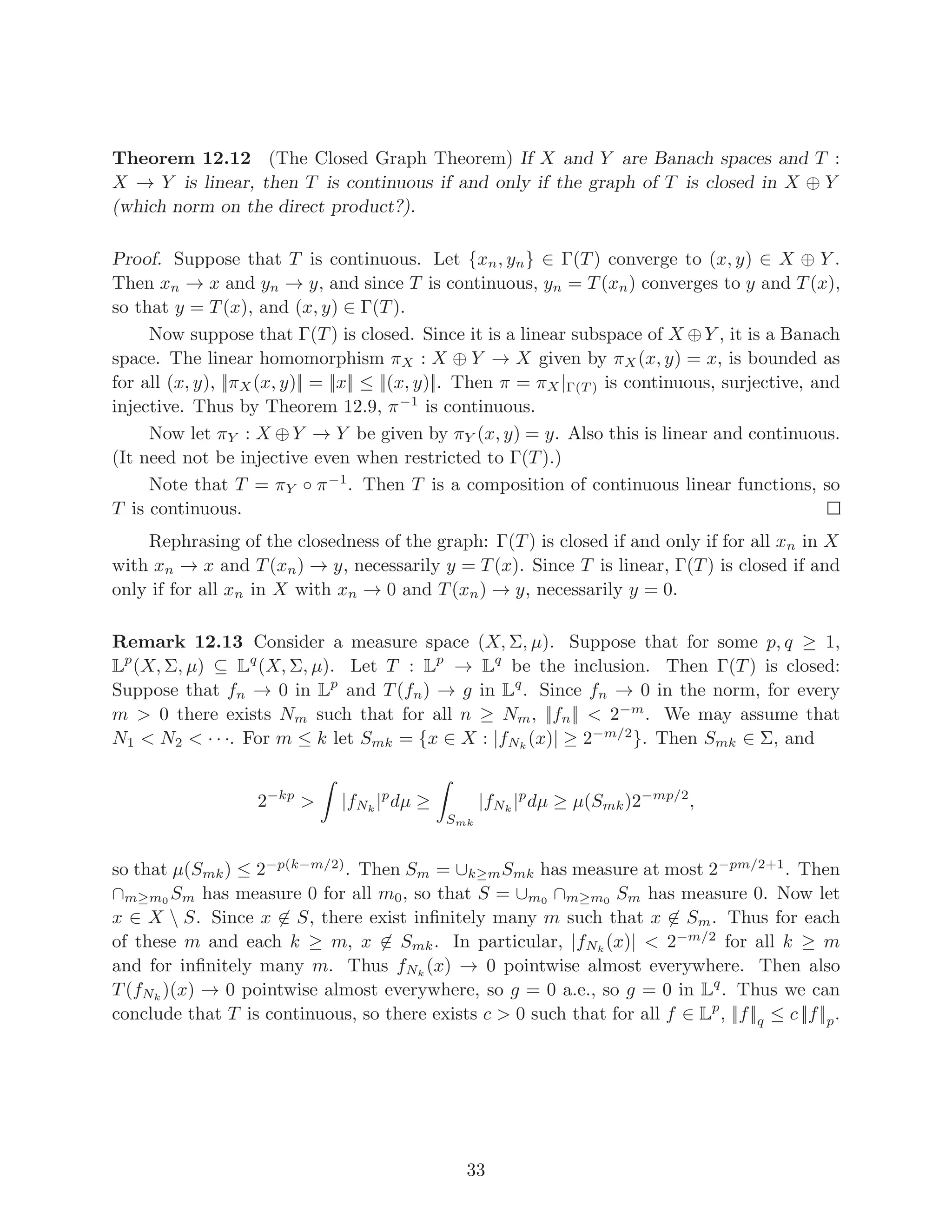

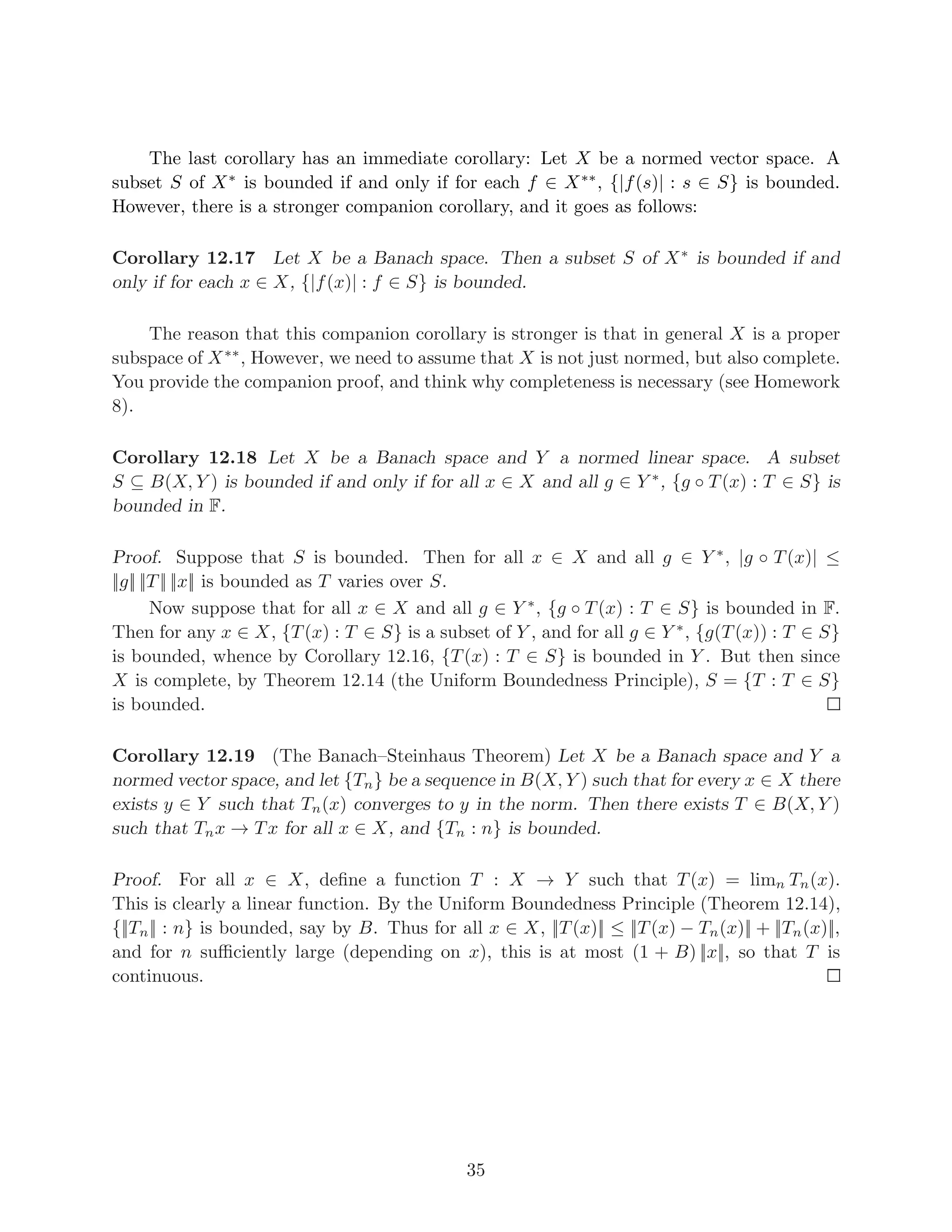
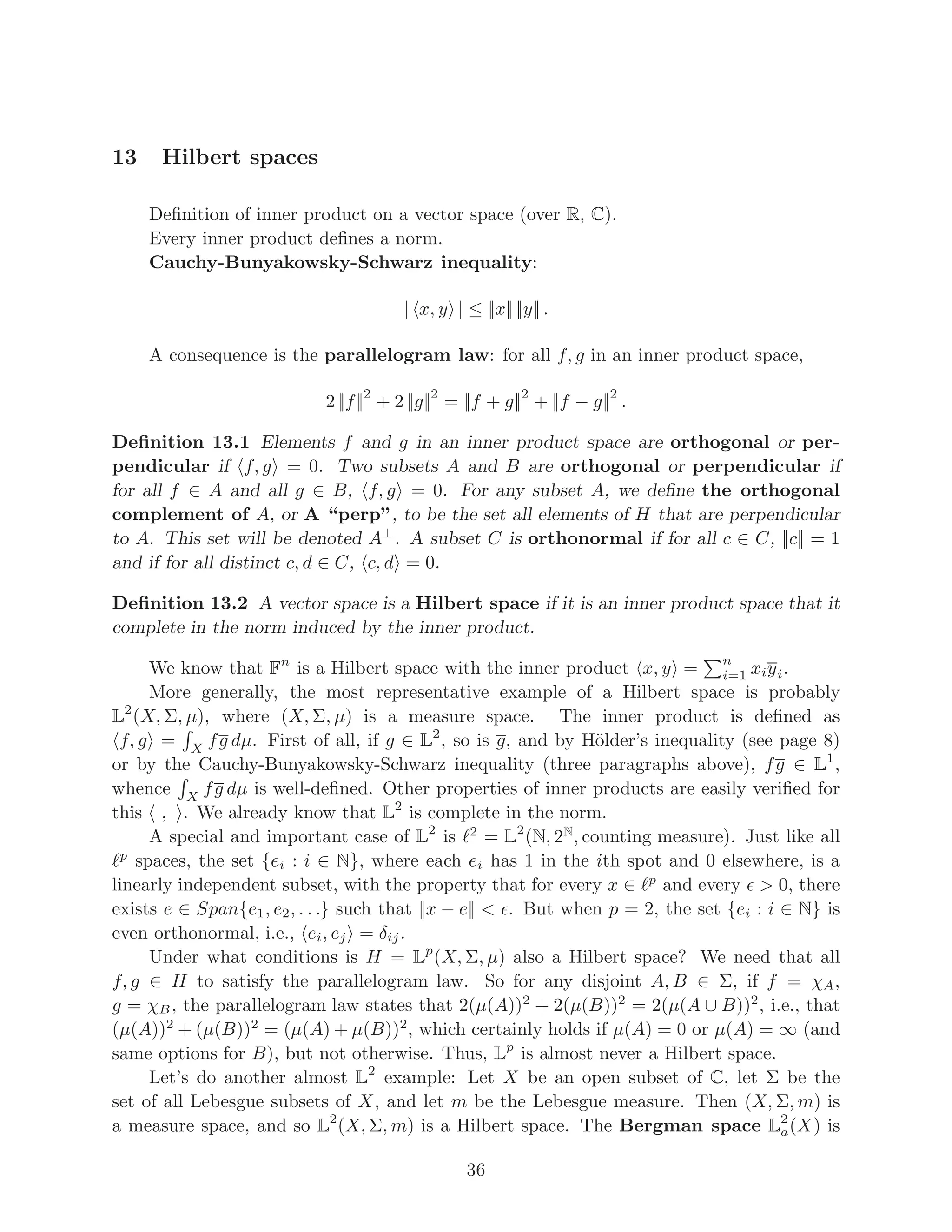
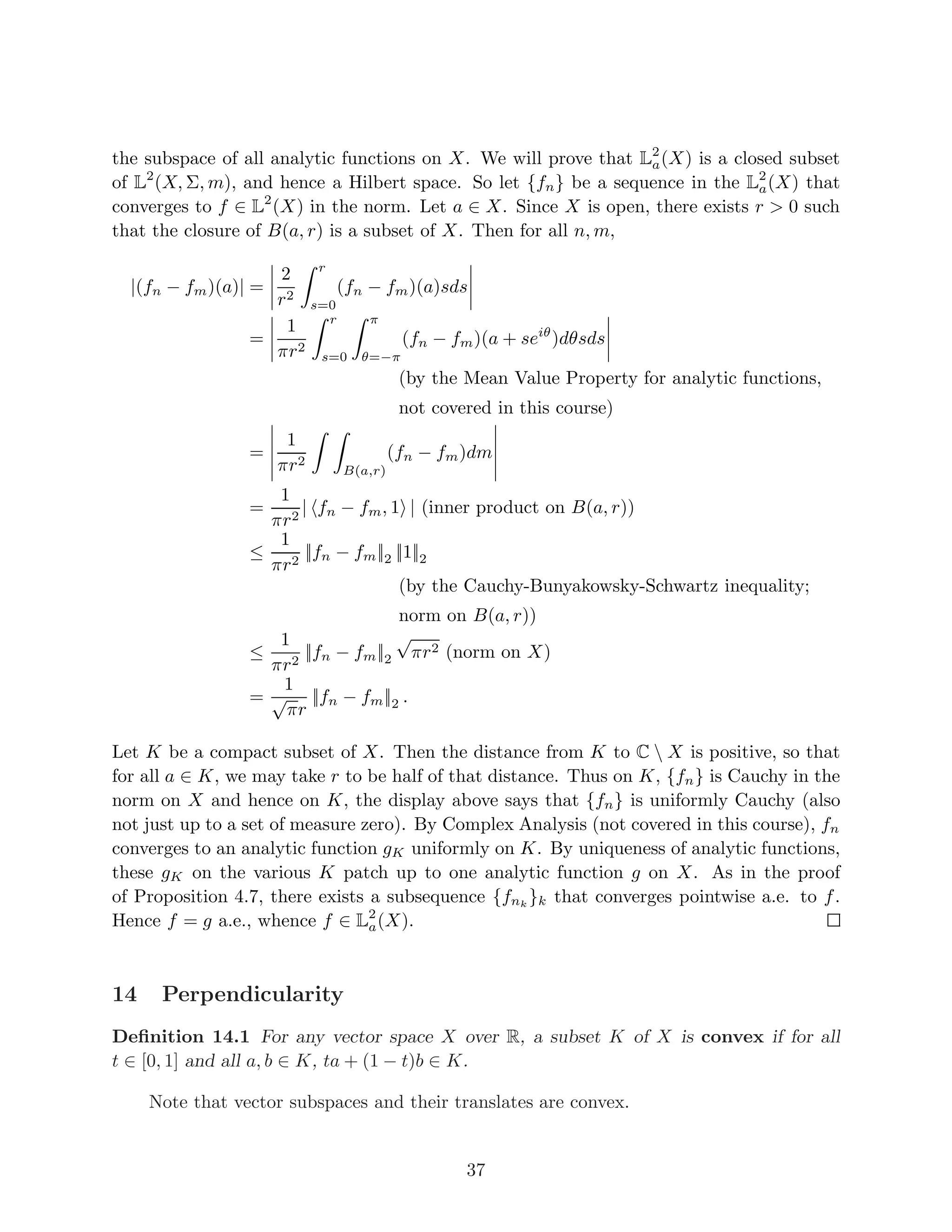
![5 L∞
spaces
Let (X, Σ, µ) be a measure space. Let f be a measurable function f (from X to C or
R ∪ {±∞}, and B ∈ R ∪ {∞} such that for some set E ∈ Σ of measure 0, |f|χXE ≤ B.
Then clearly for any measurable g that is µ-equivalent to f, there exists F ∈ Σ of measure
0, such that |g|χXF ≤ B. For such f we define
||f||∞
to be the infimum of all such possible B. We just proved that ||f||∞ = ||g||∞ whenever f is
µ-equivalent to g.
Definition 5.1 Let (X, Σ, µ) be a measure space. Define L∞
= L∞
(X) = L∞
(X, Σ, σ)
to be the set of all µ-equivalent classes of measurable functions for which ||f||∞ ∞.
Theorem 5.2 If (X, Σ, µ) be a measure space, then L∞
(X) is a Banach space with the
norm || ||∞.
Proof. Note that if f ∈ L∞
, then f is bounded almost everywhere, and so by the discussion
above Definition 4.5, L∞
is closed under addition. The other properties of vector spaces
are straightforward to establish for L∞
.
For the norm we only verify that triangle inequality: Let B, C ∈ R such that f ≤ B
almost everywhere and g ≤ C almost everywhere. Then f +g ≤ B +C almost everywhere,
so that ||f + g||∞ ≤ B + C. Now we take the infimum over all such B and C to get that
||f + g||∞ ≤ ||f||∞ + ||g||∞.
That L∞
is complete I leave for the exercises.
6 Some spaces that are almost Banach, but aren’t
Definition 6.1 Let X = C∞
([a, b]) be the set of all functions [a, b] → R that have deriva-
tives of all orders (one sided derivatives at a and b).
For each k ∈ N, define ||f||k =
Pk
i=1](https://image.slidesharecdn.com/functionalanalysisejemplosinfinitos-210607191306/75/Functionalanalysis-ejemplos-infinitos-38-2048.jpg)
